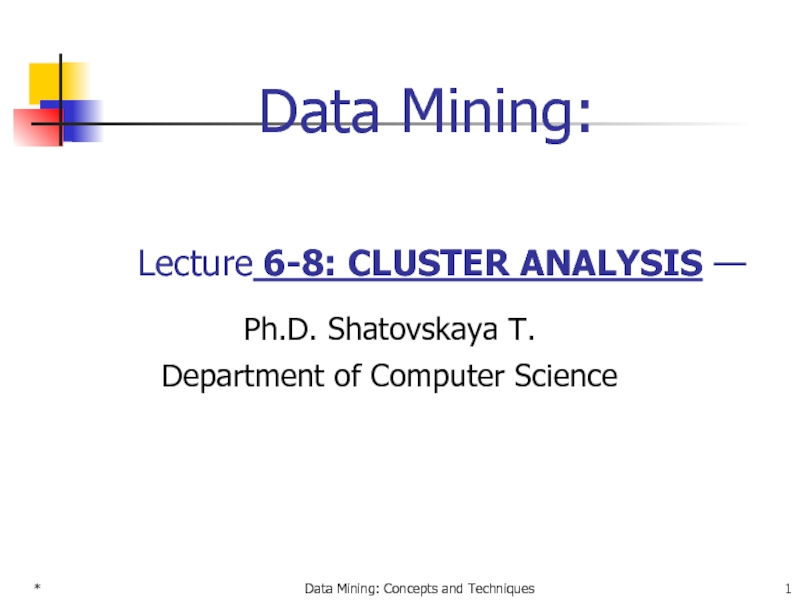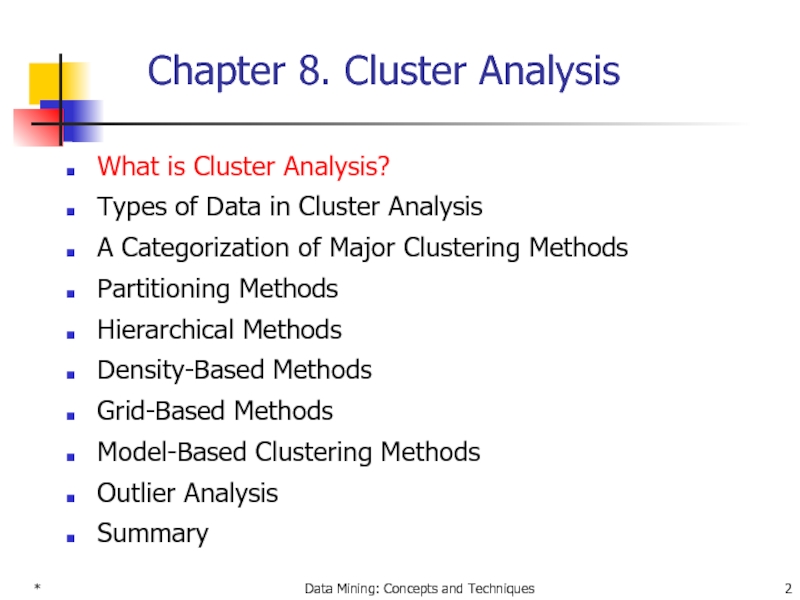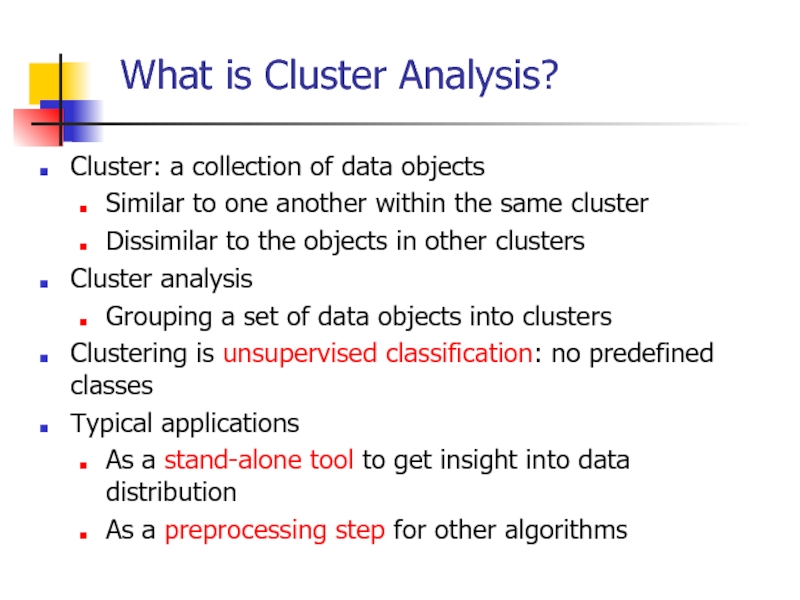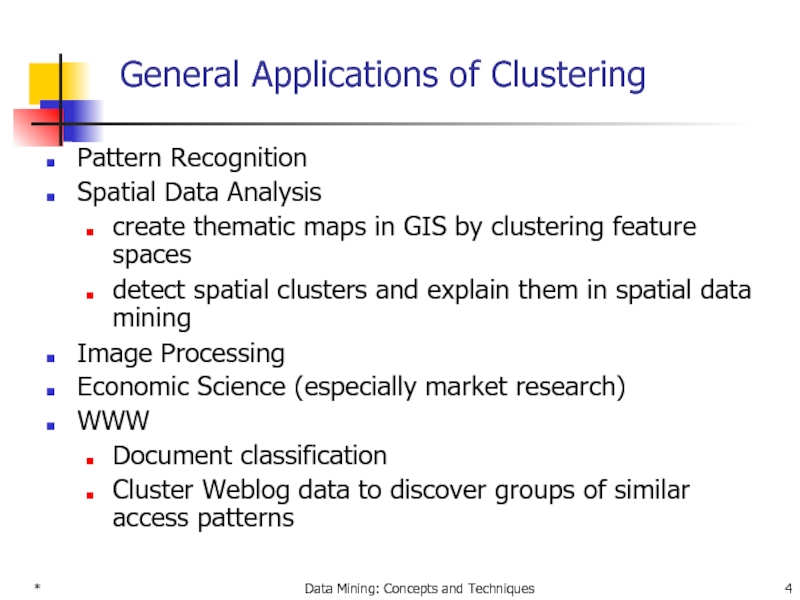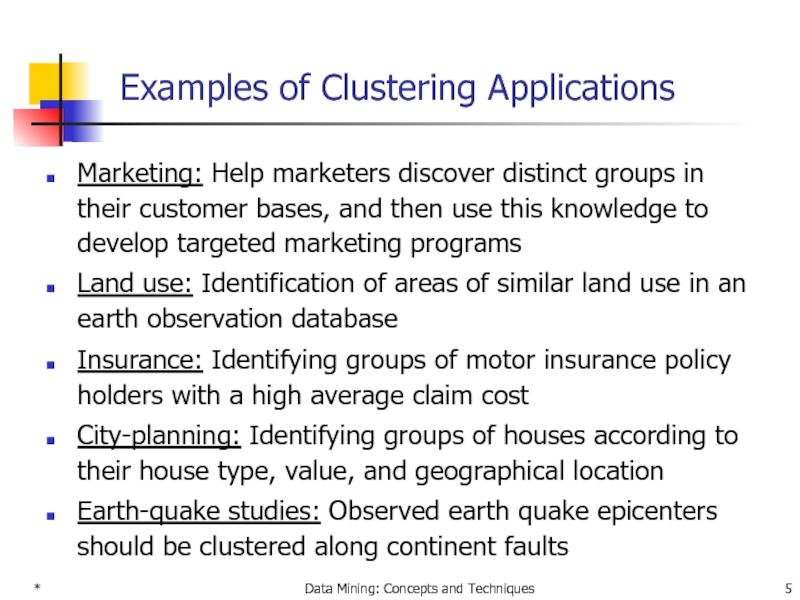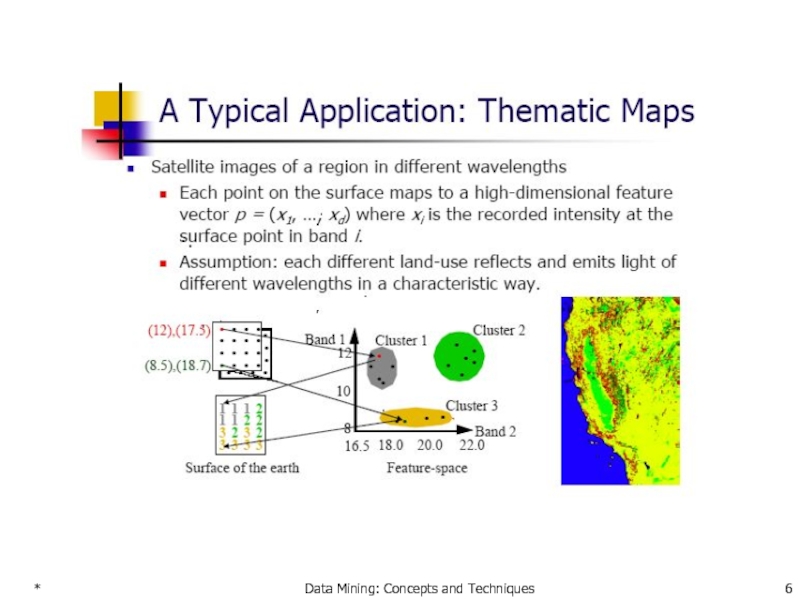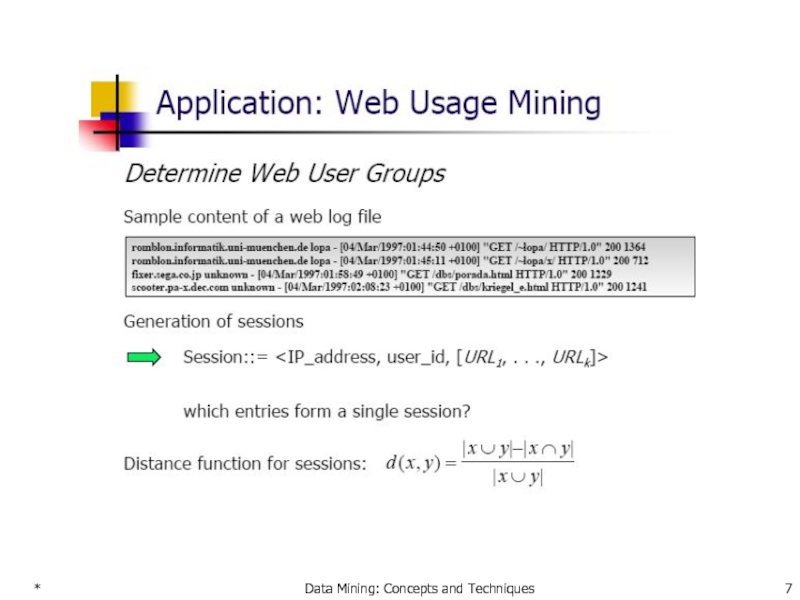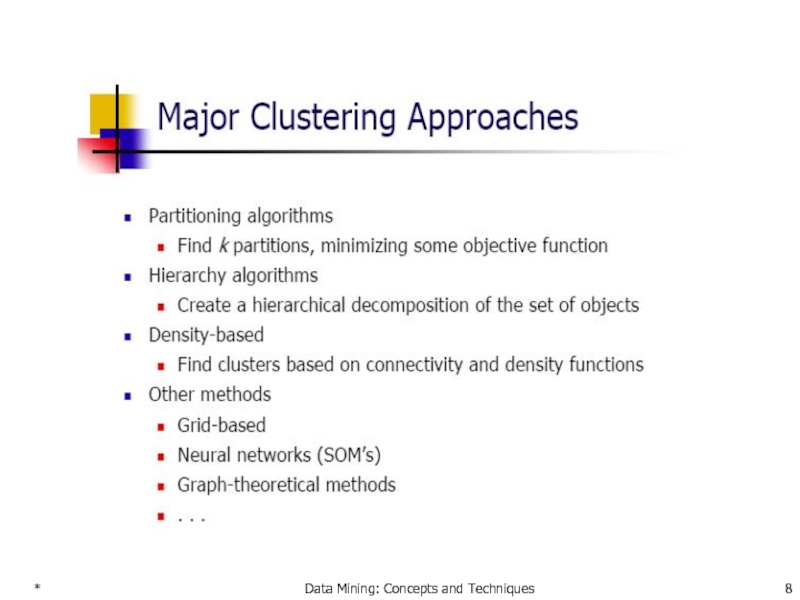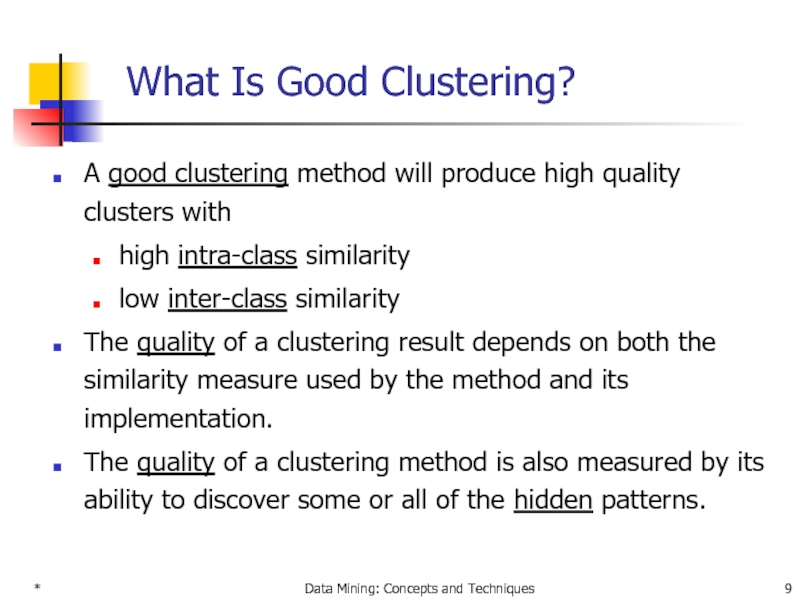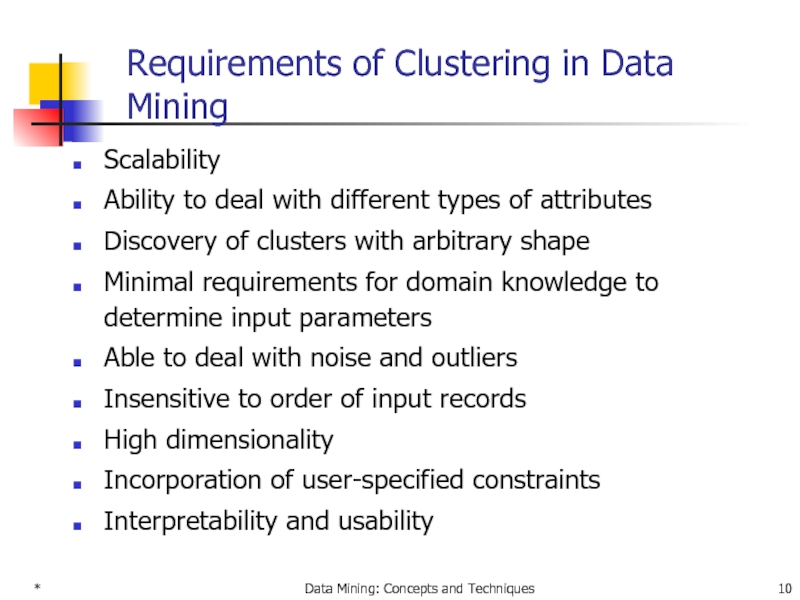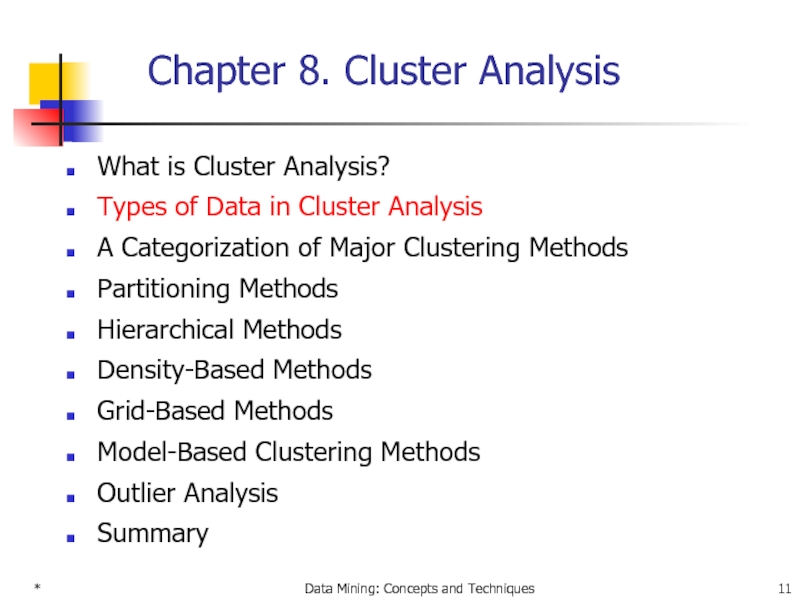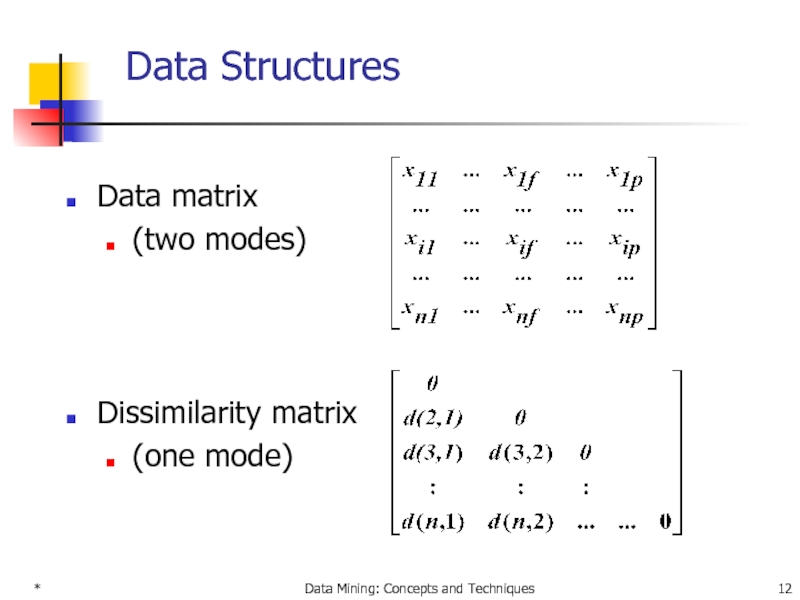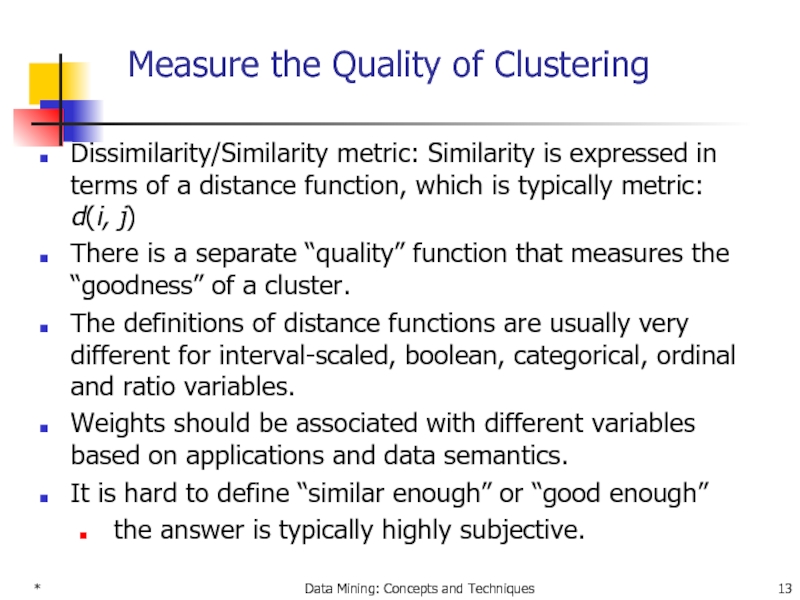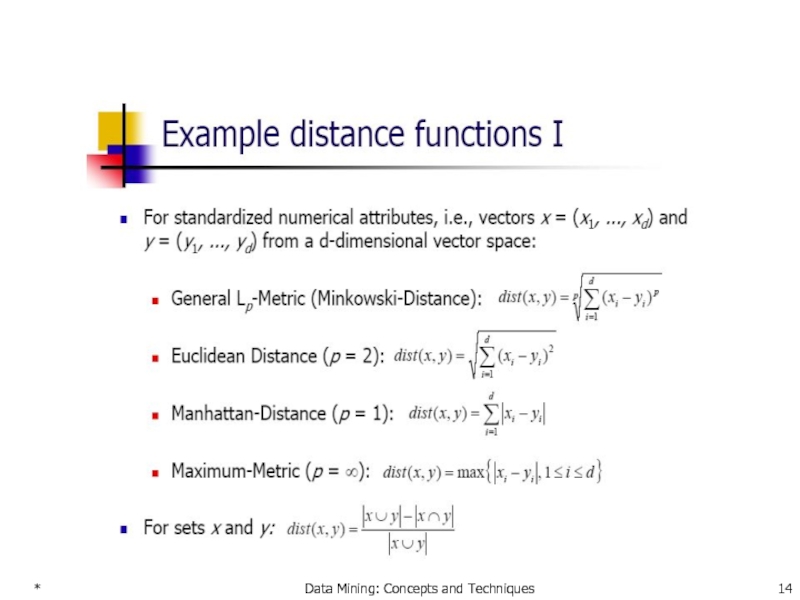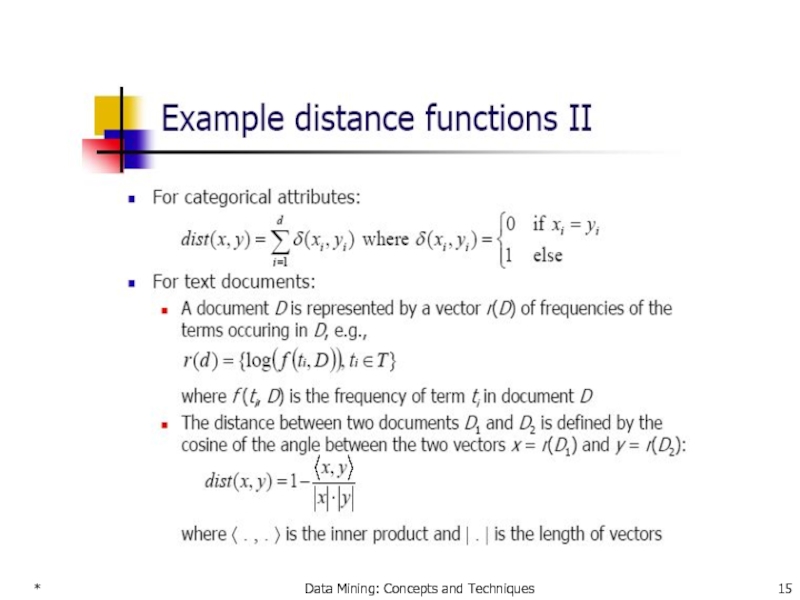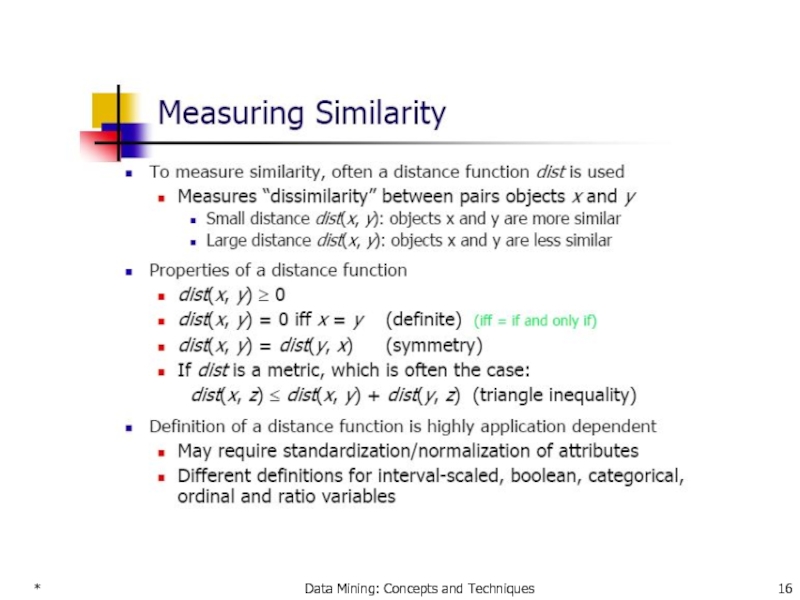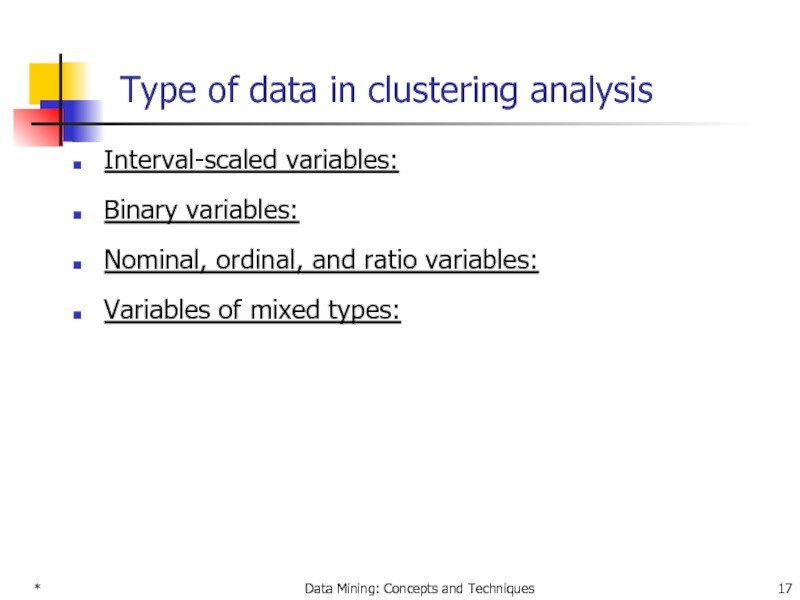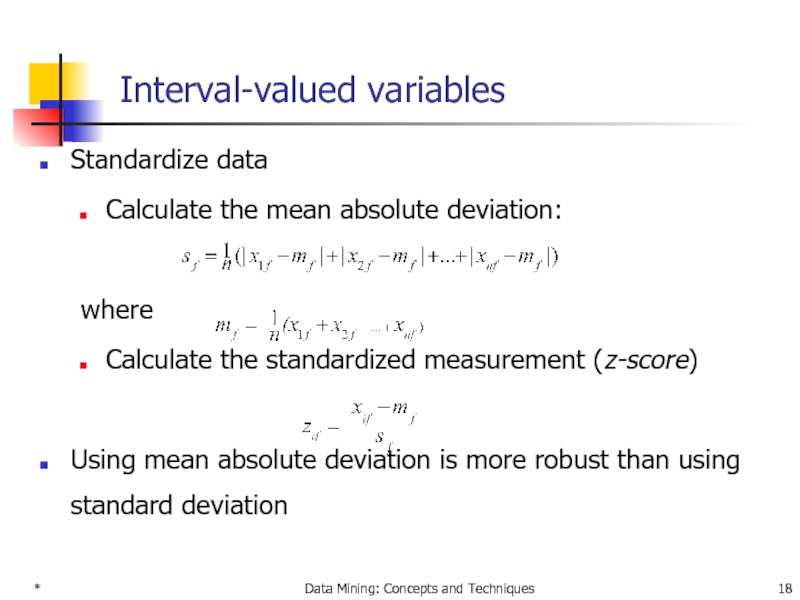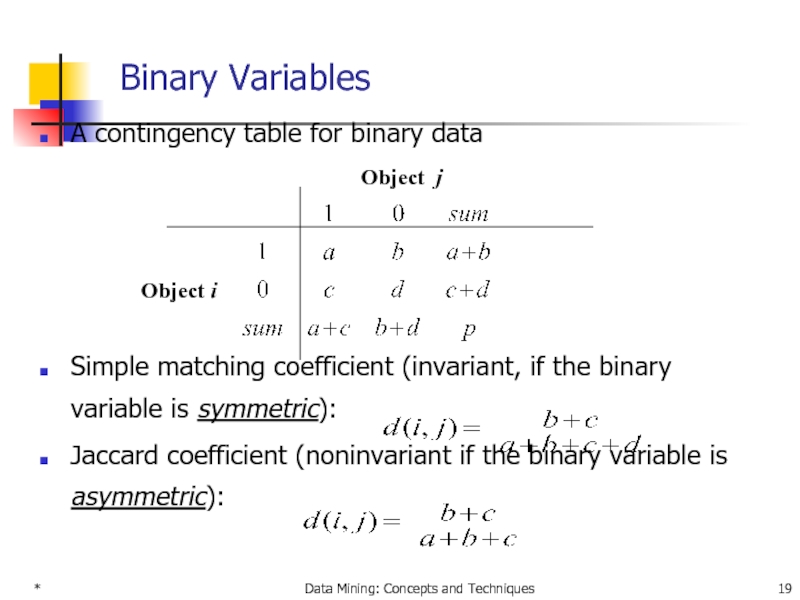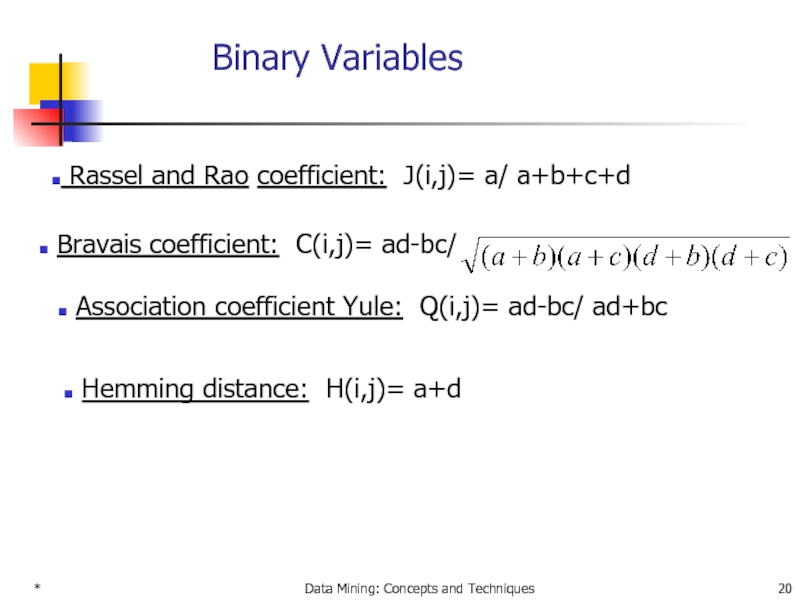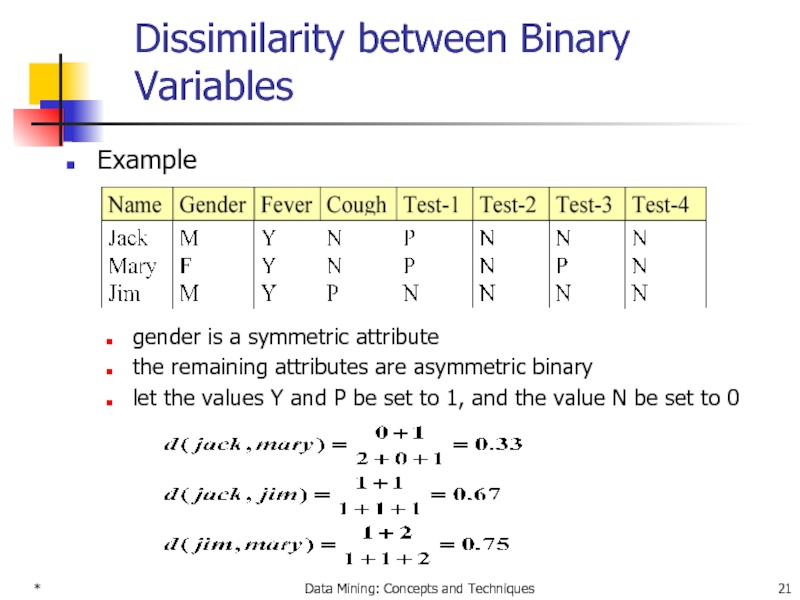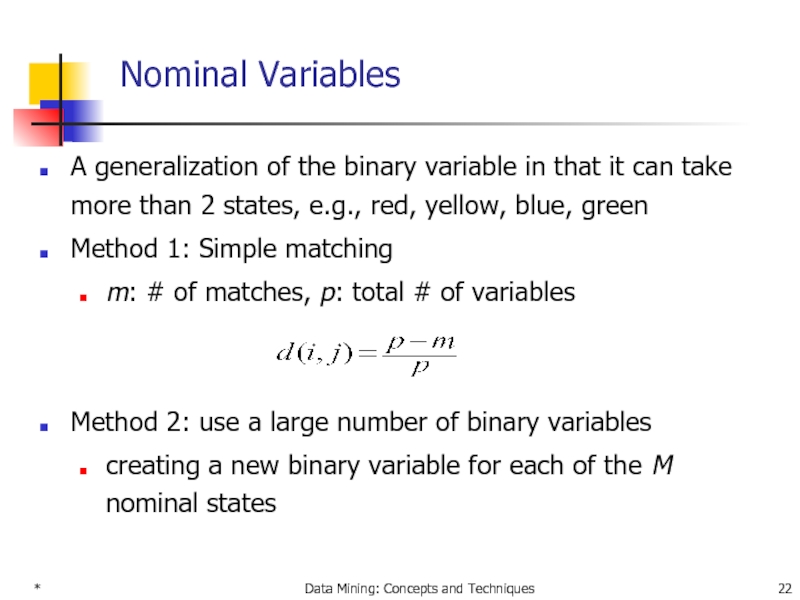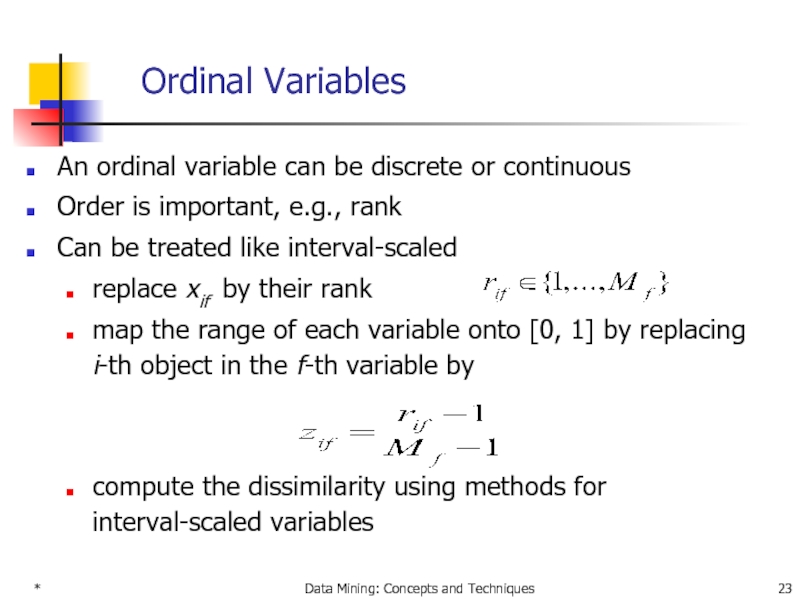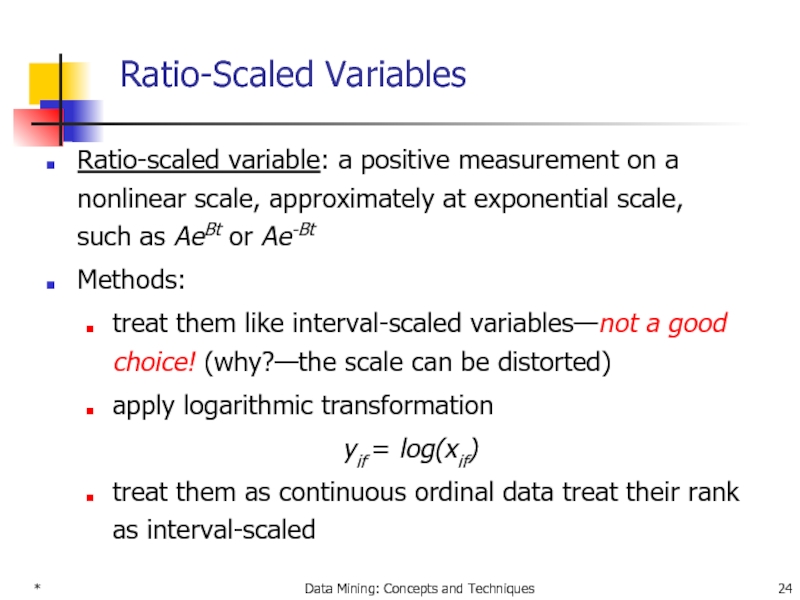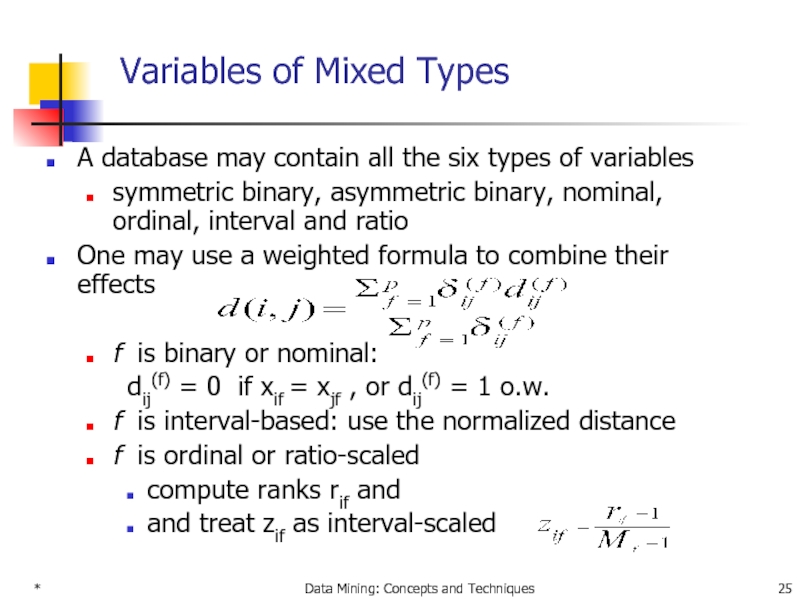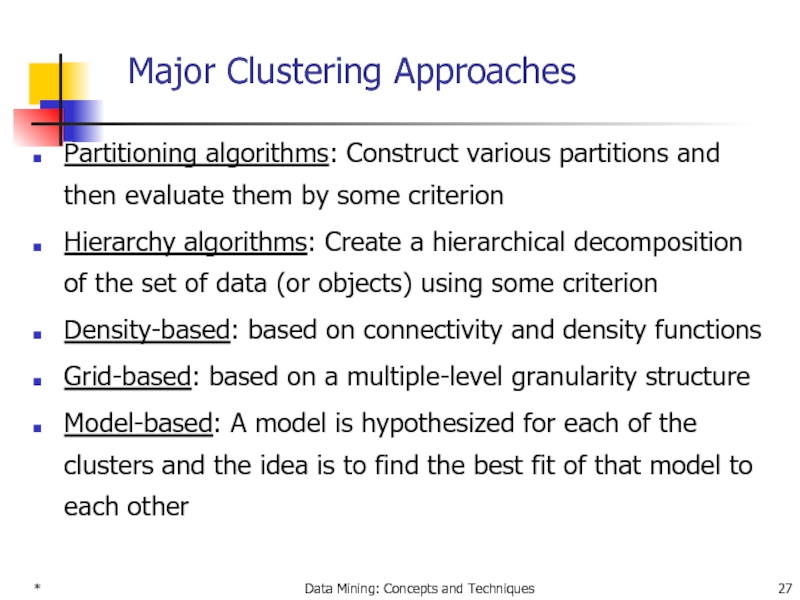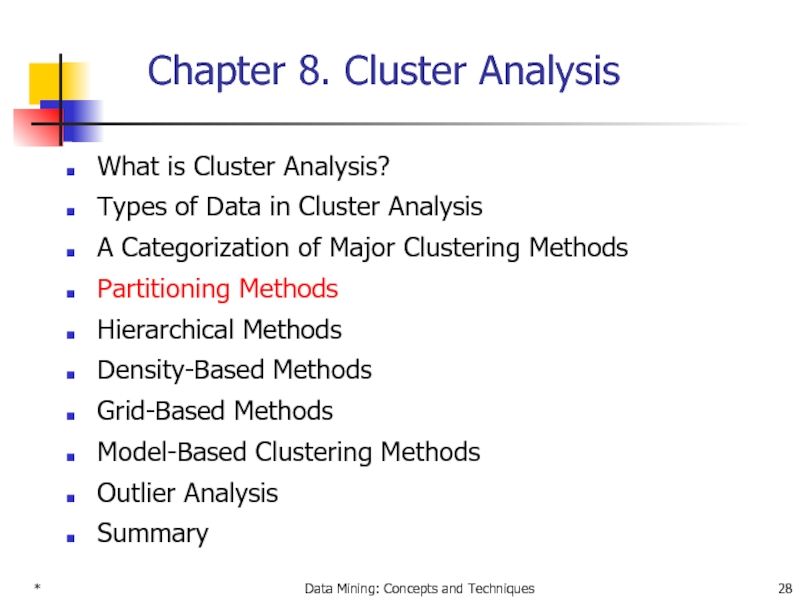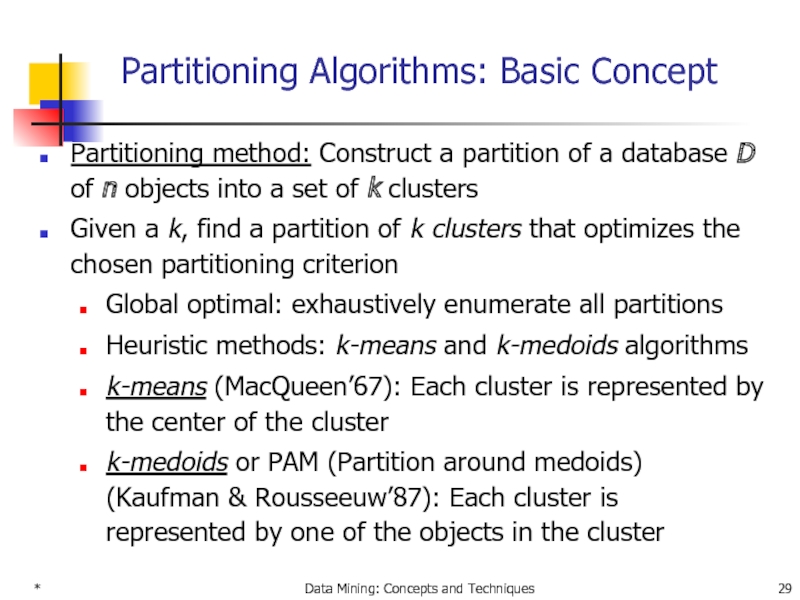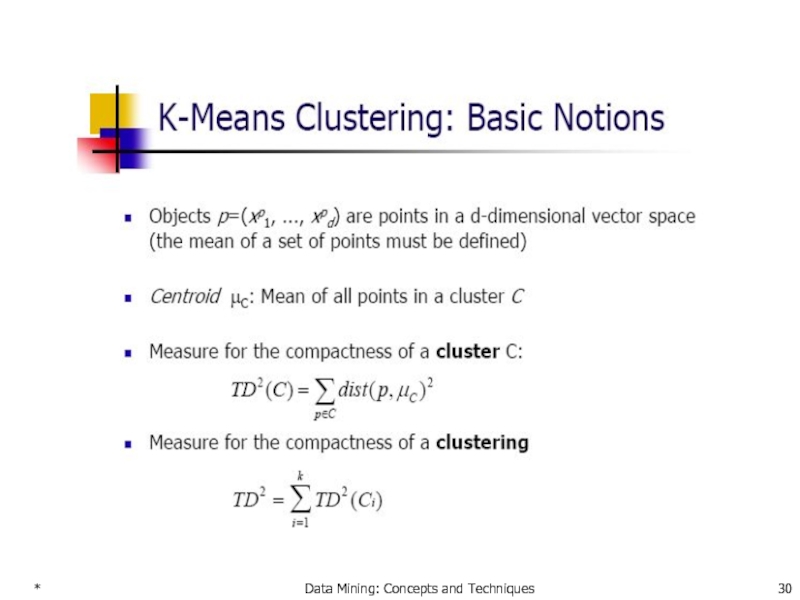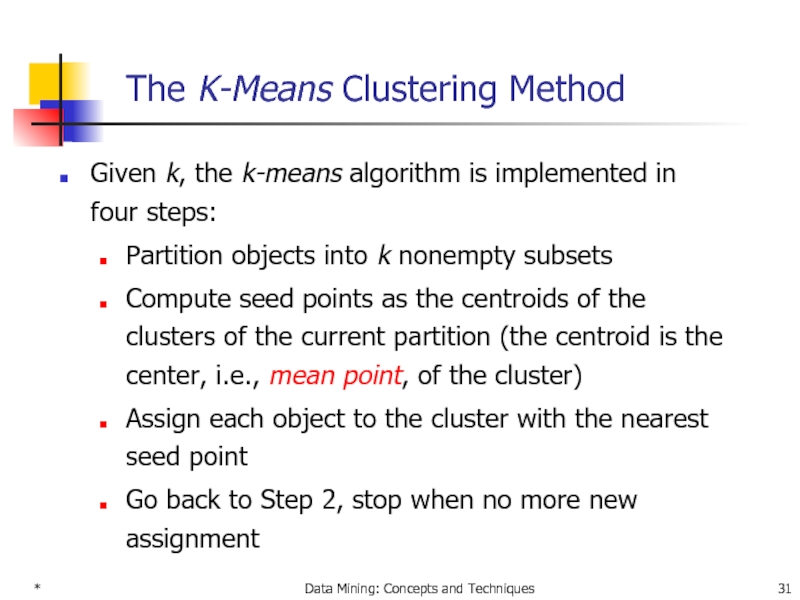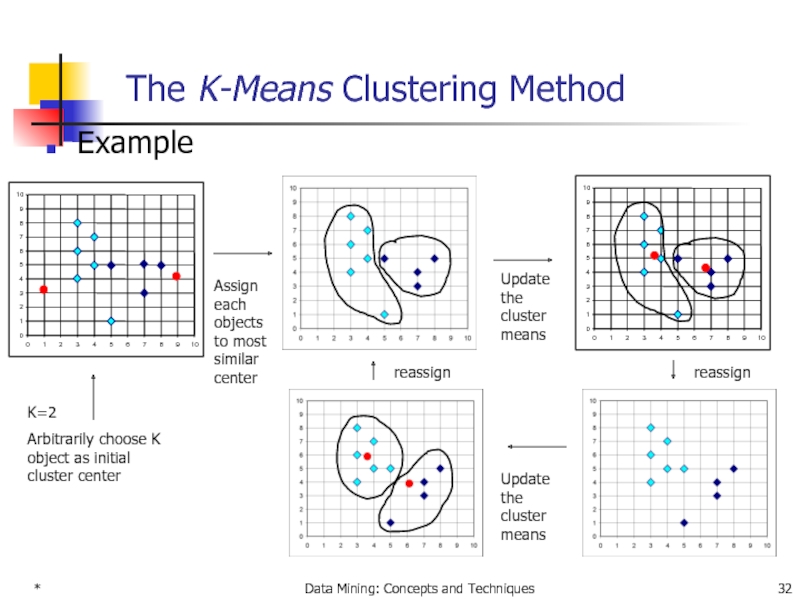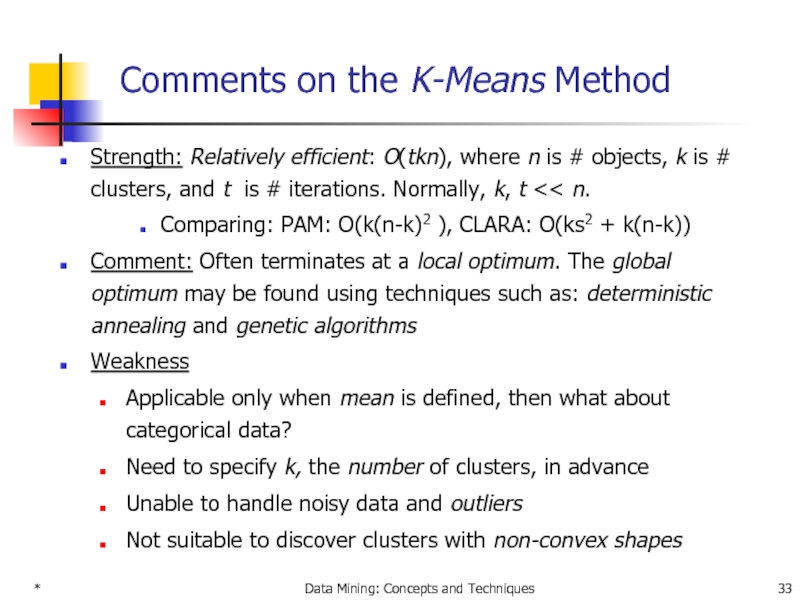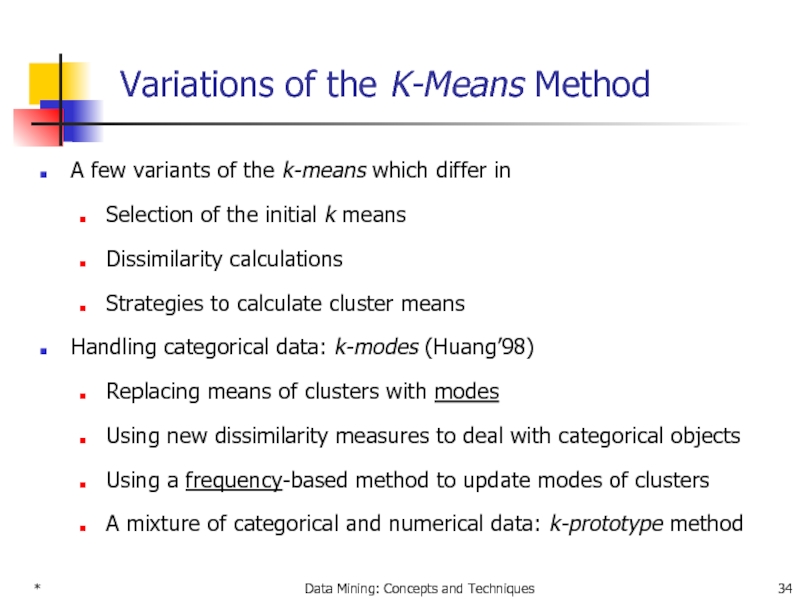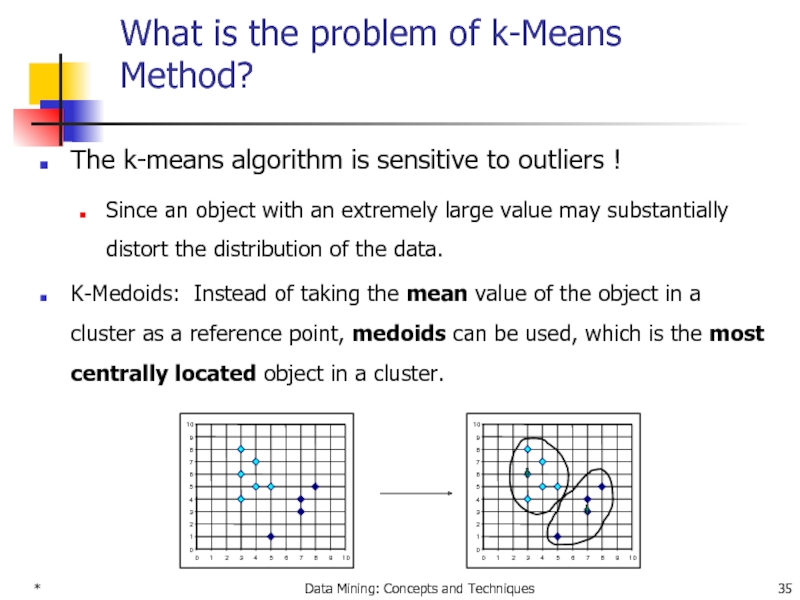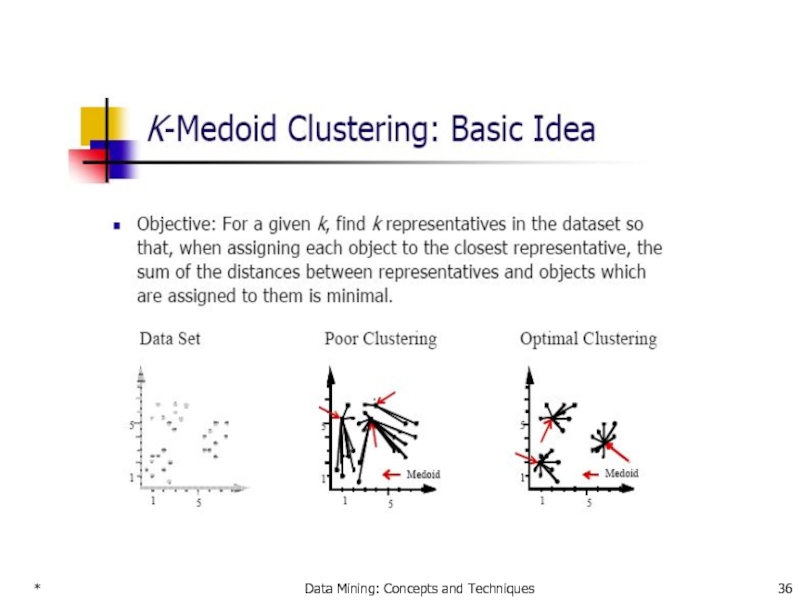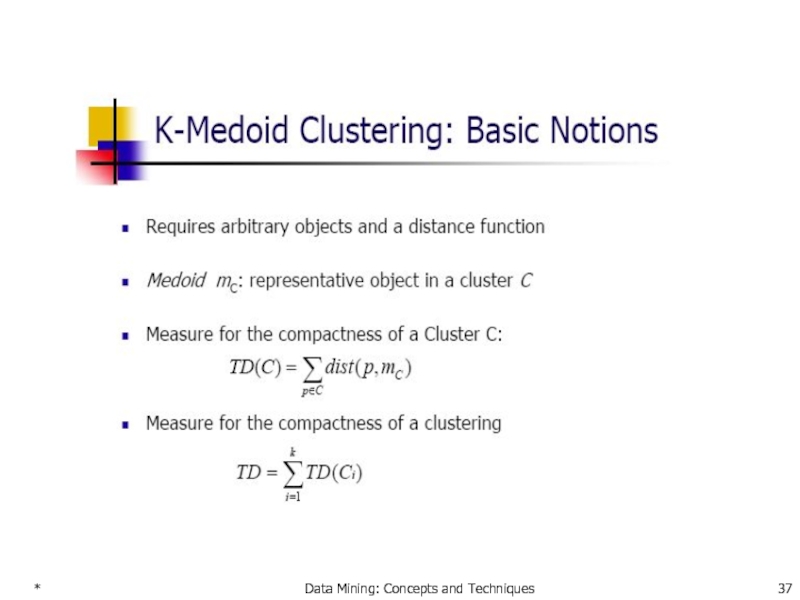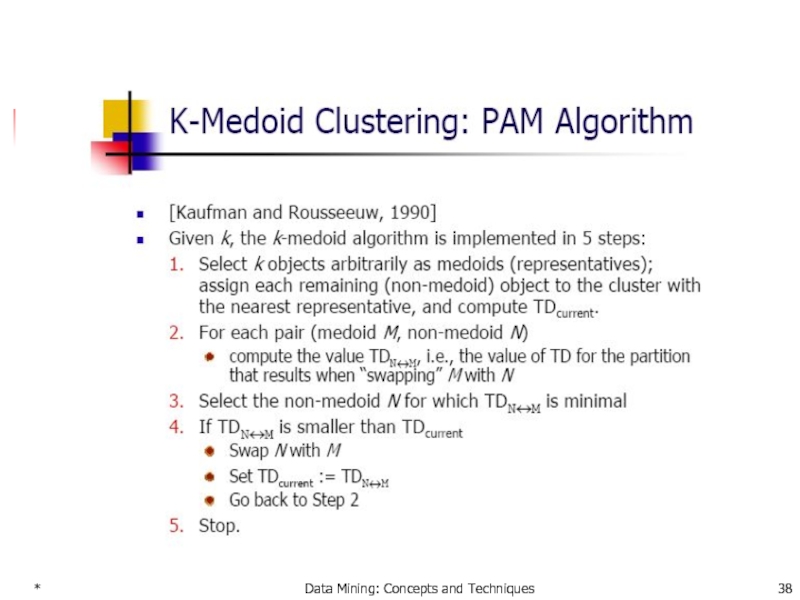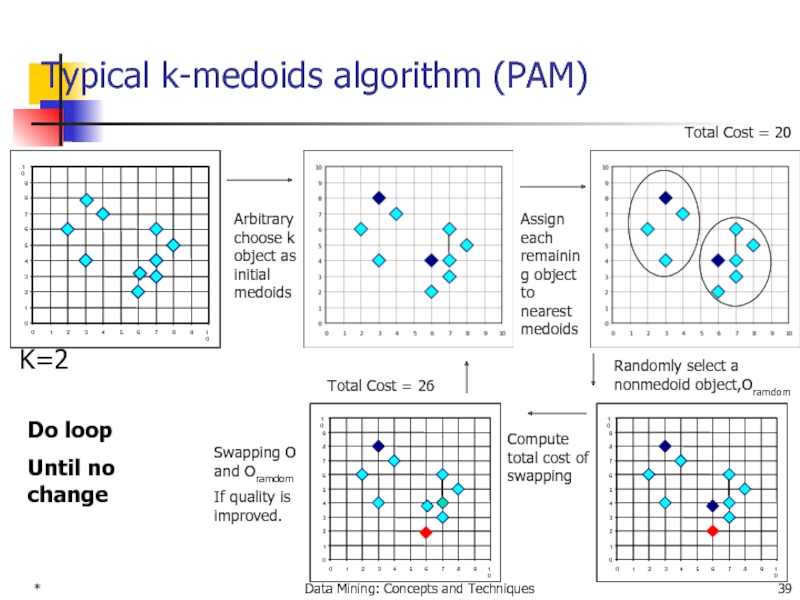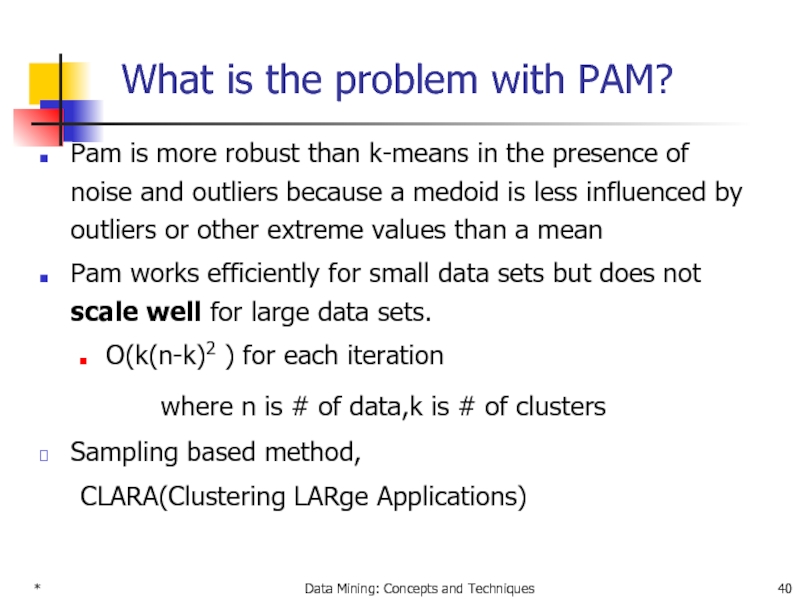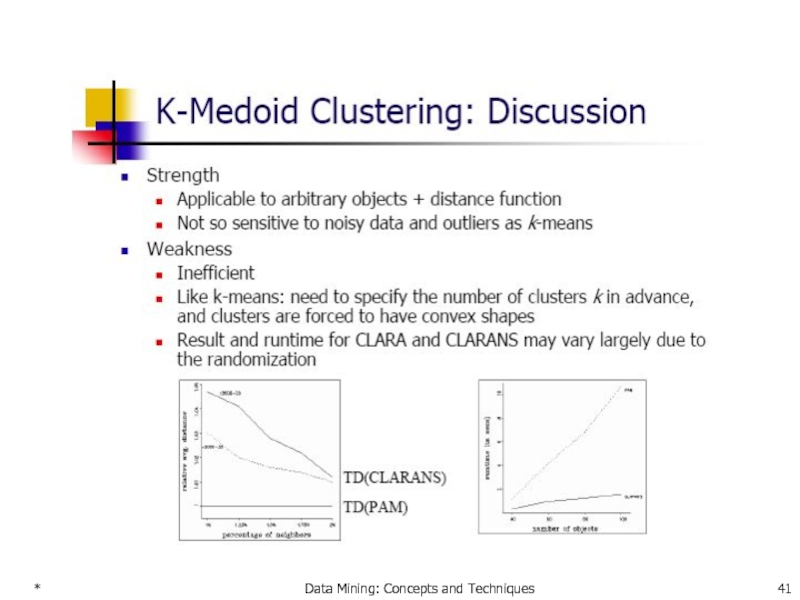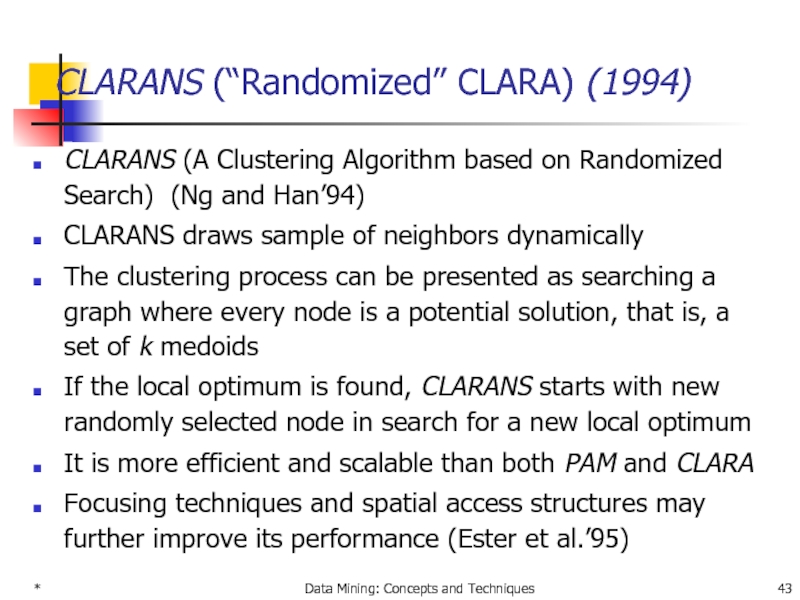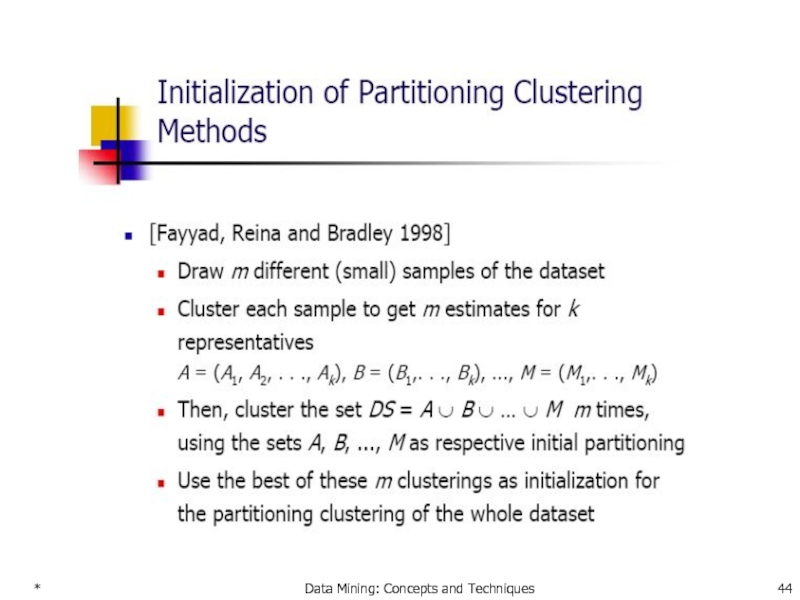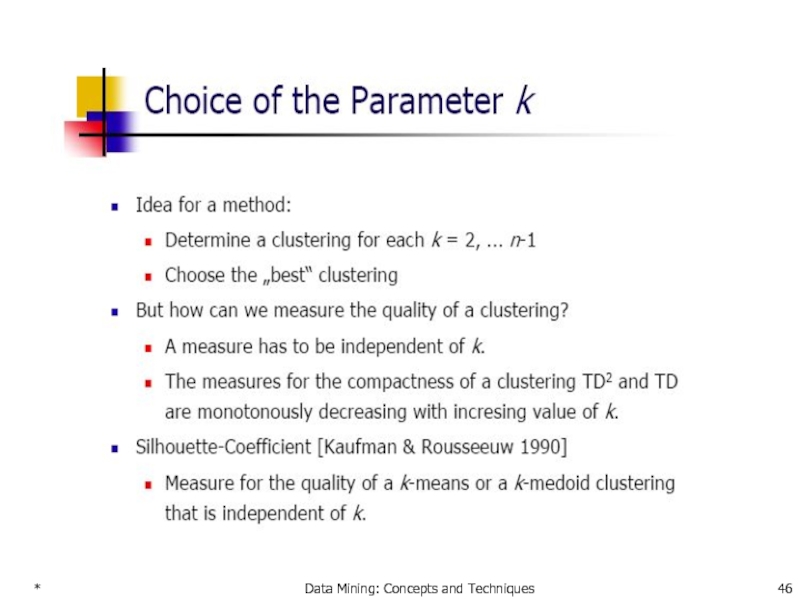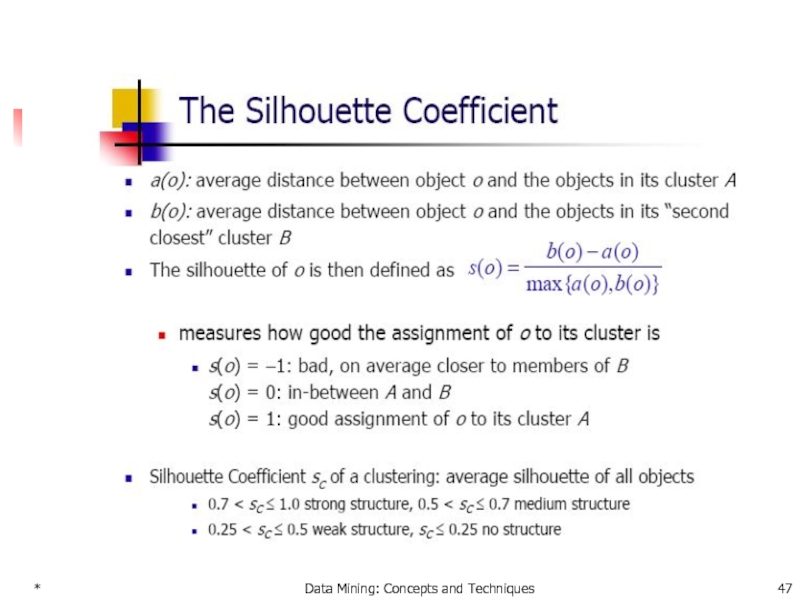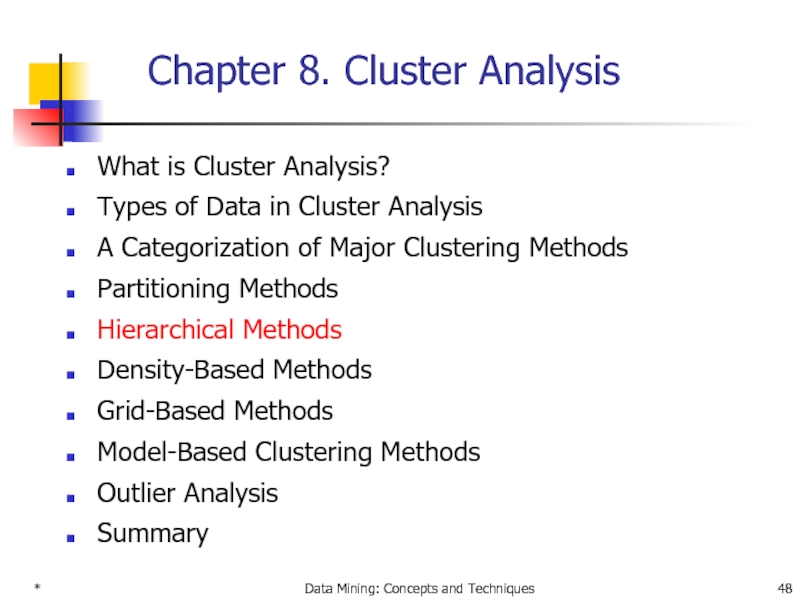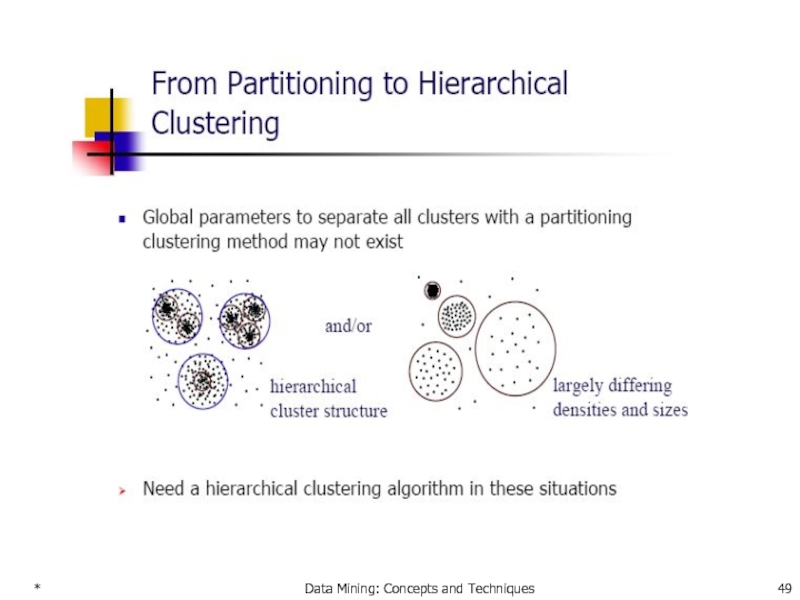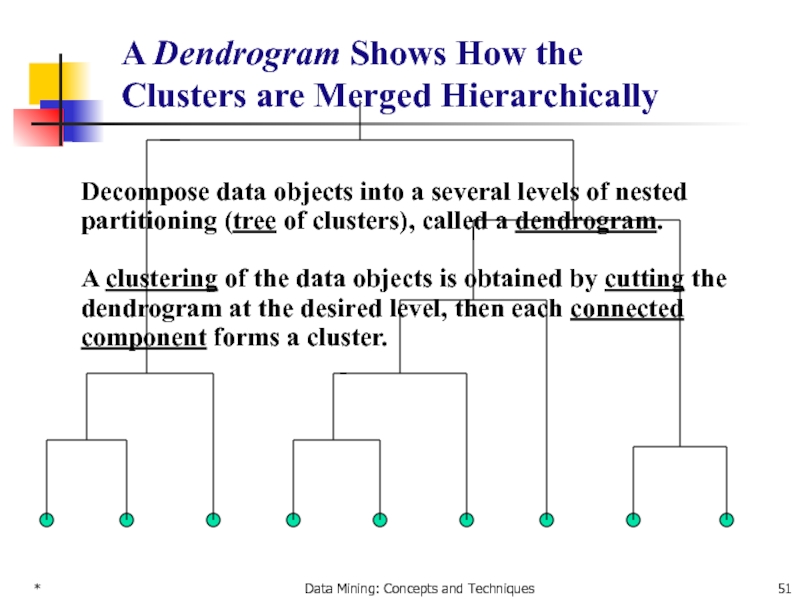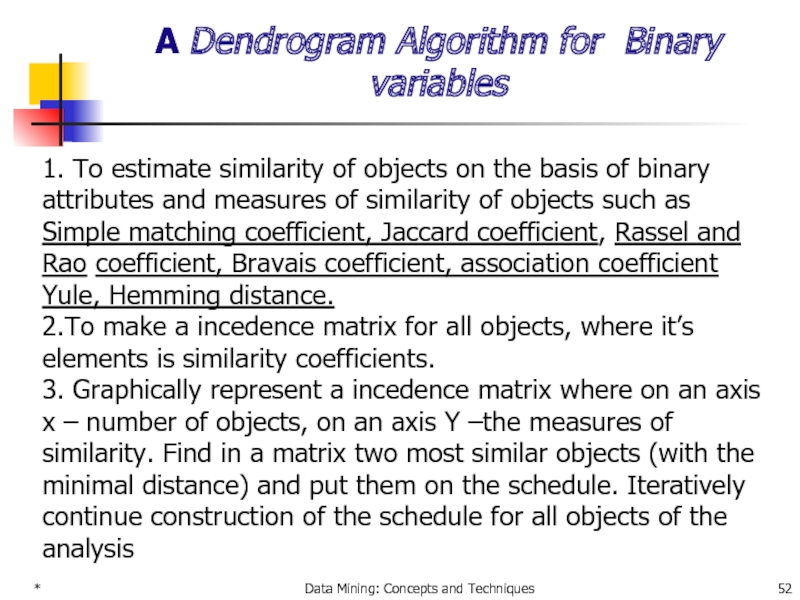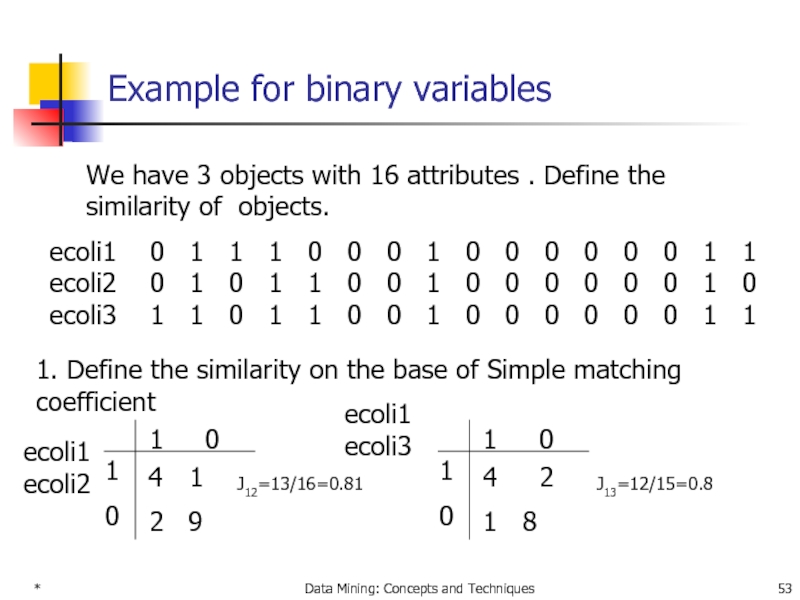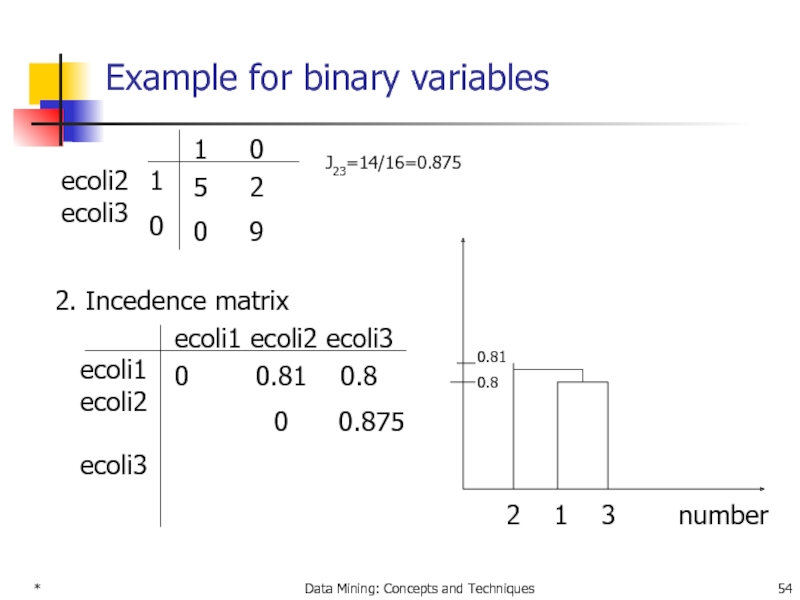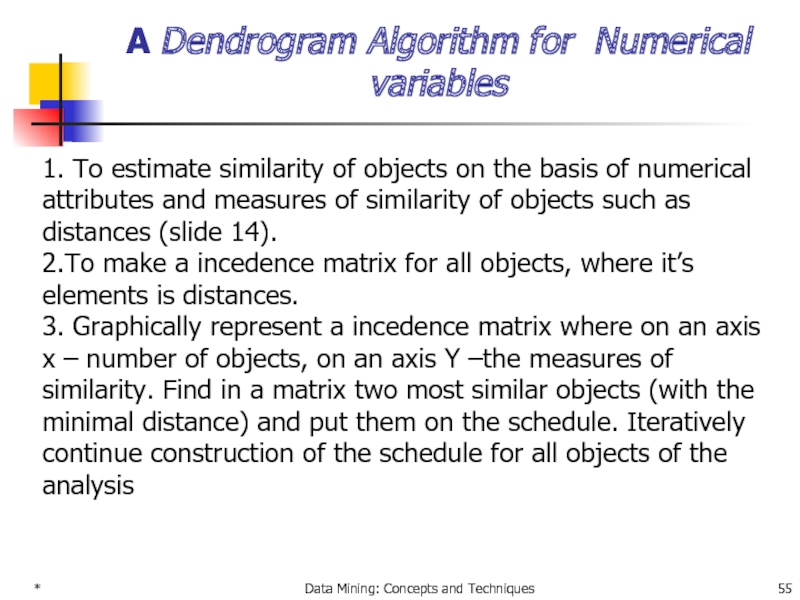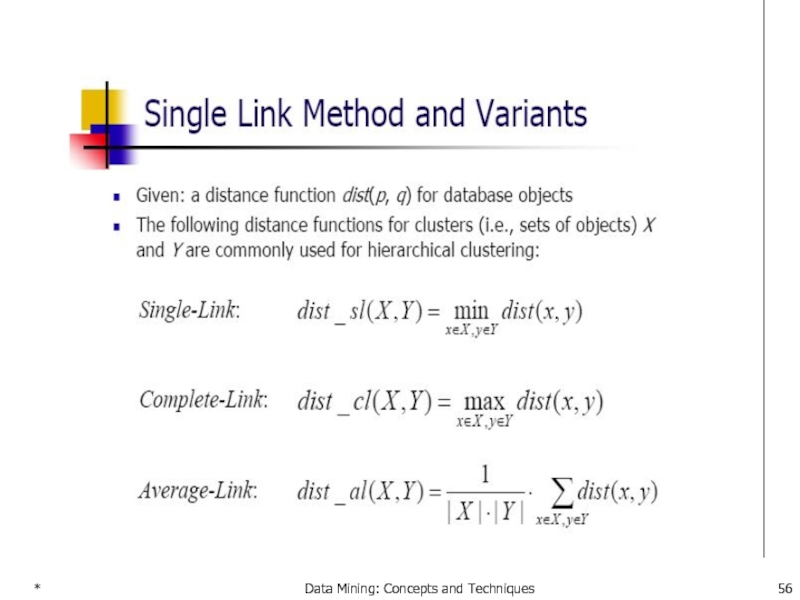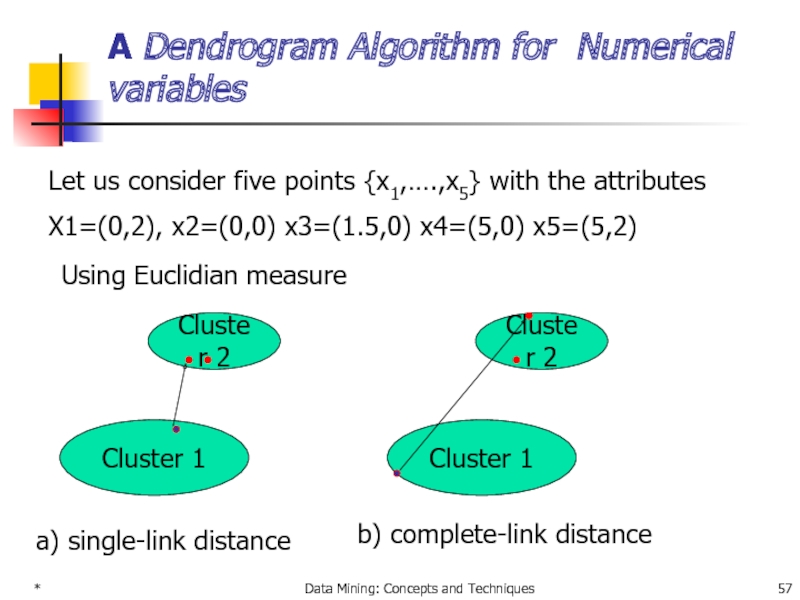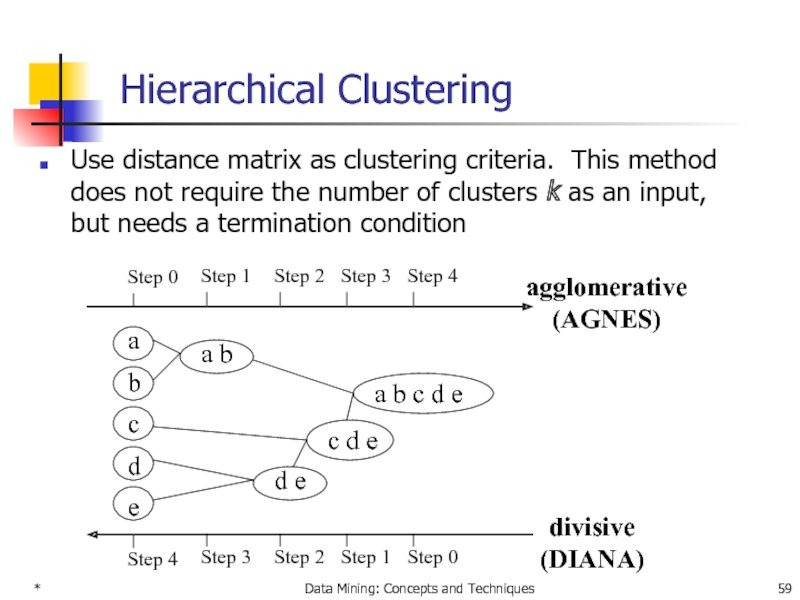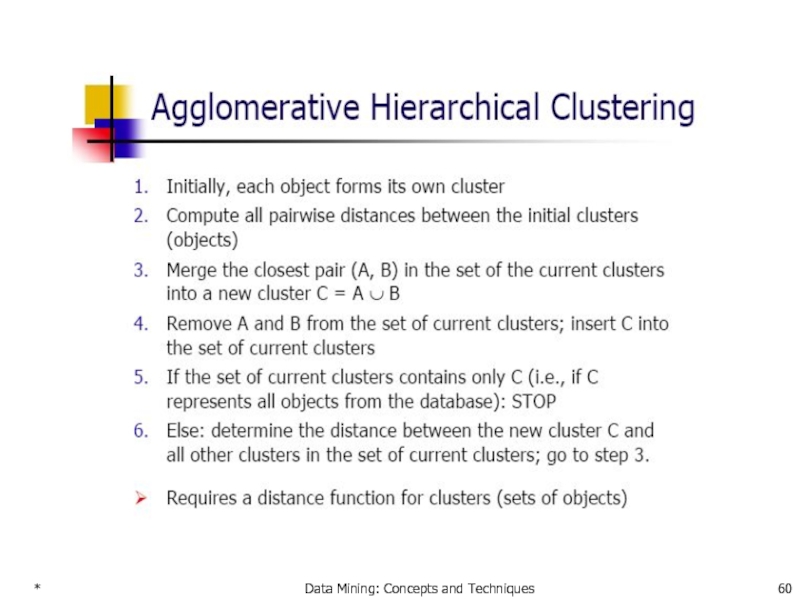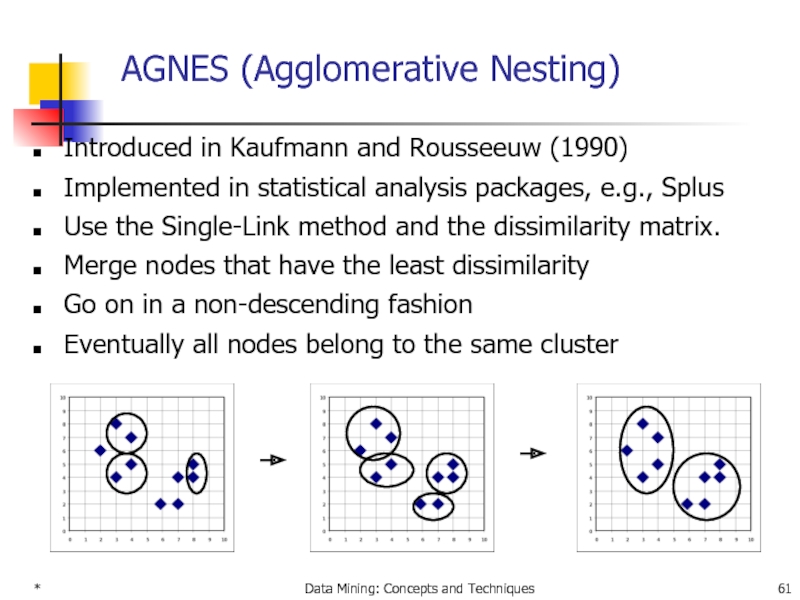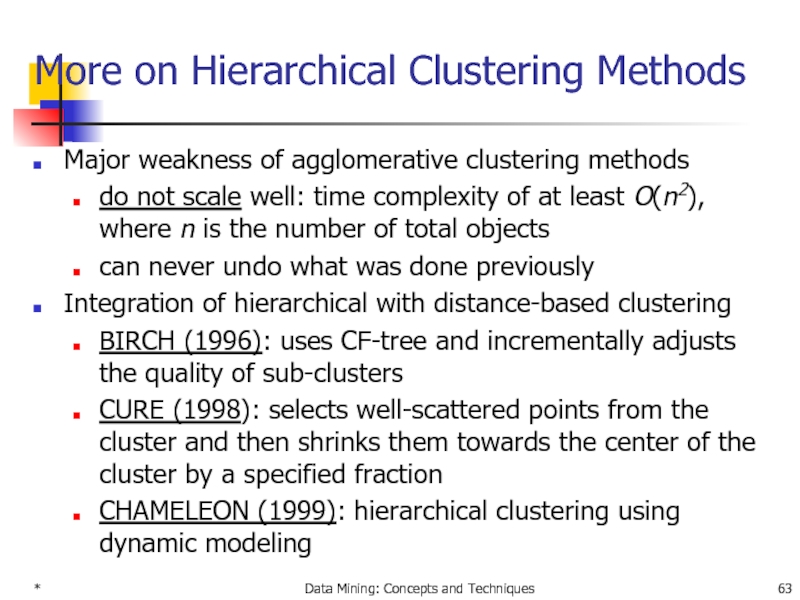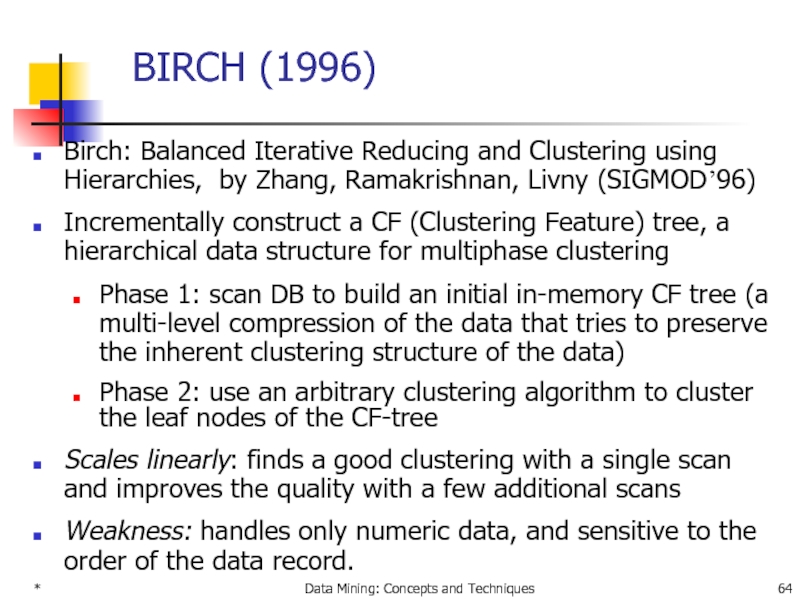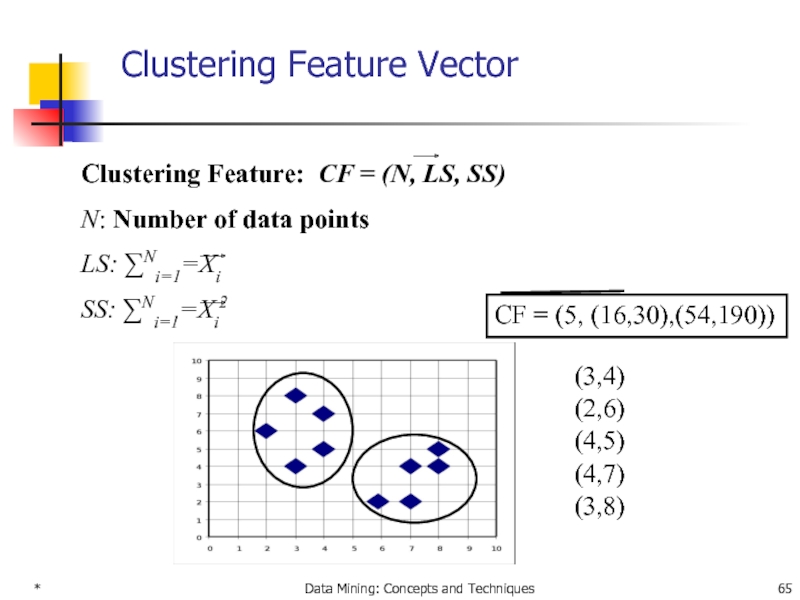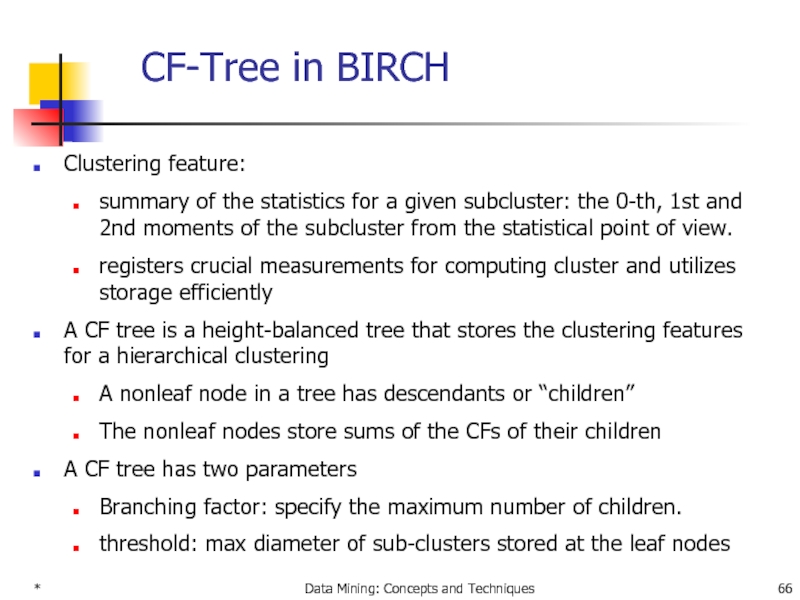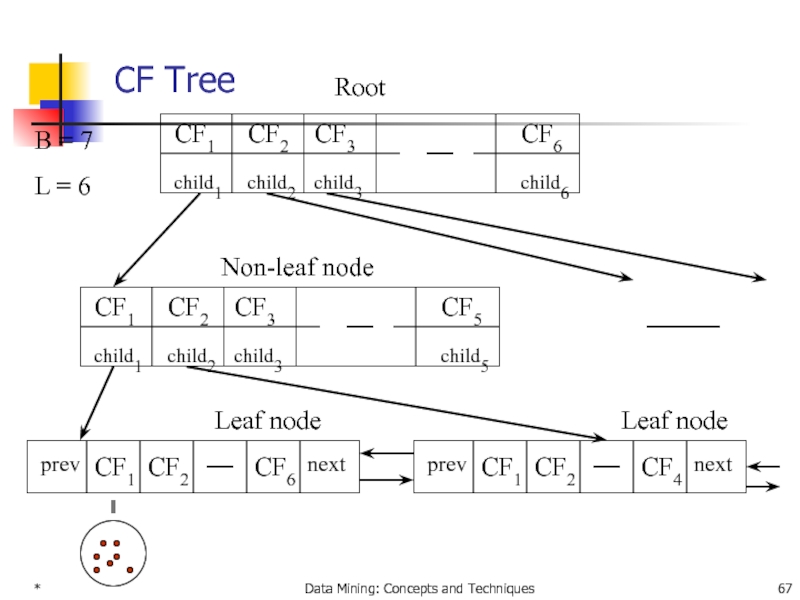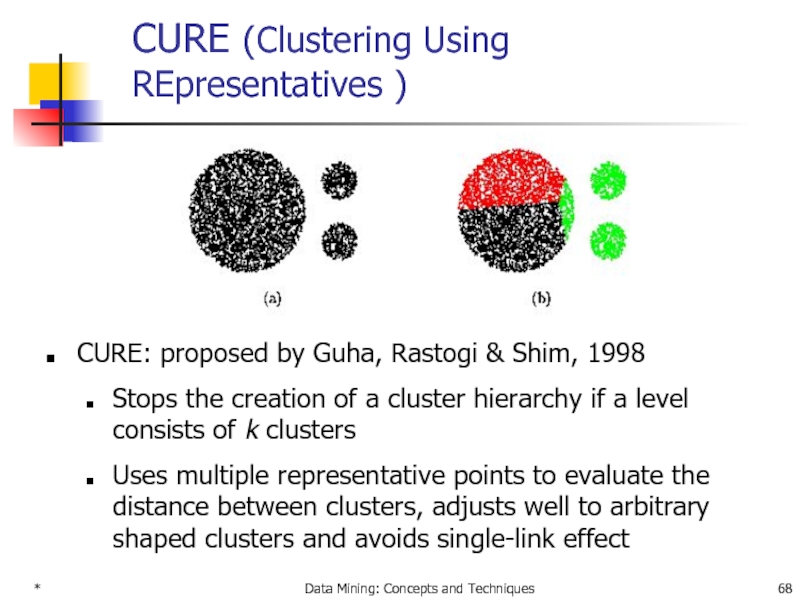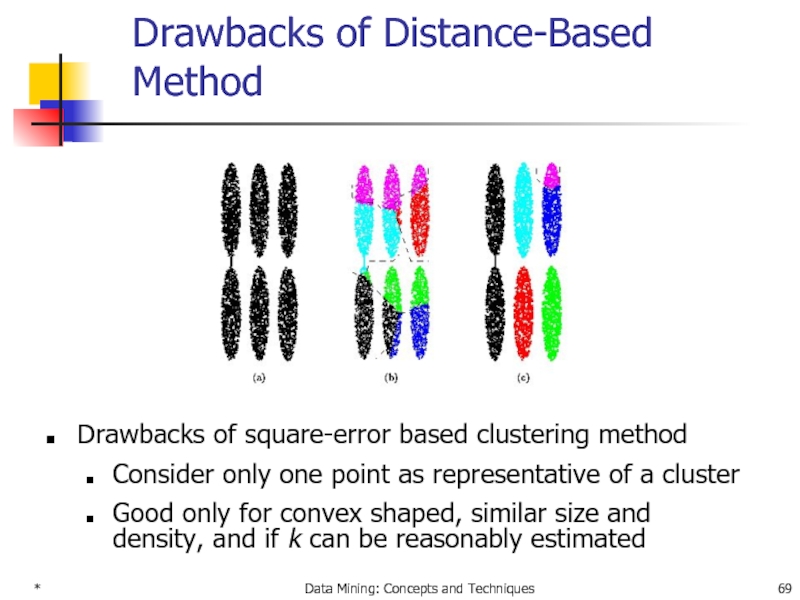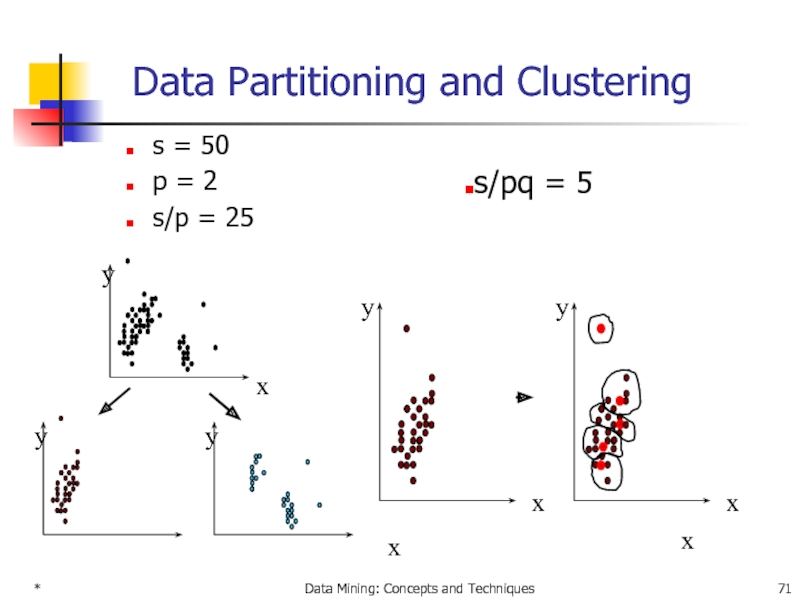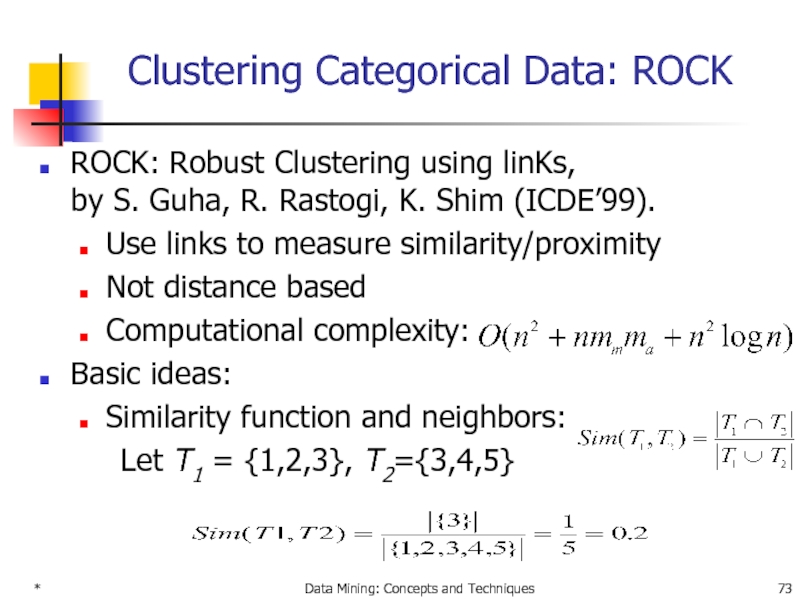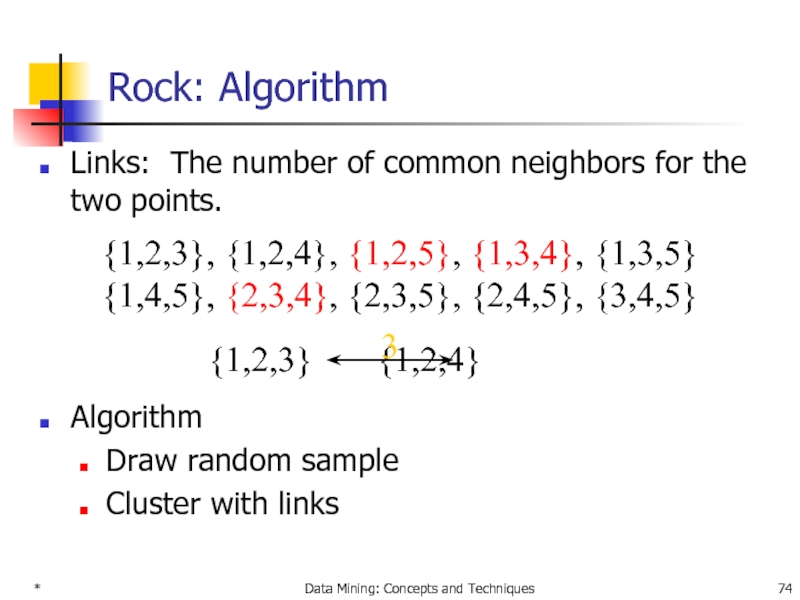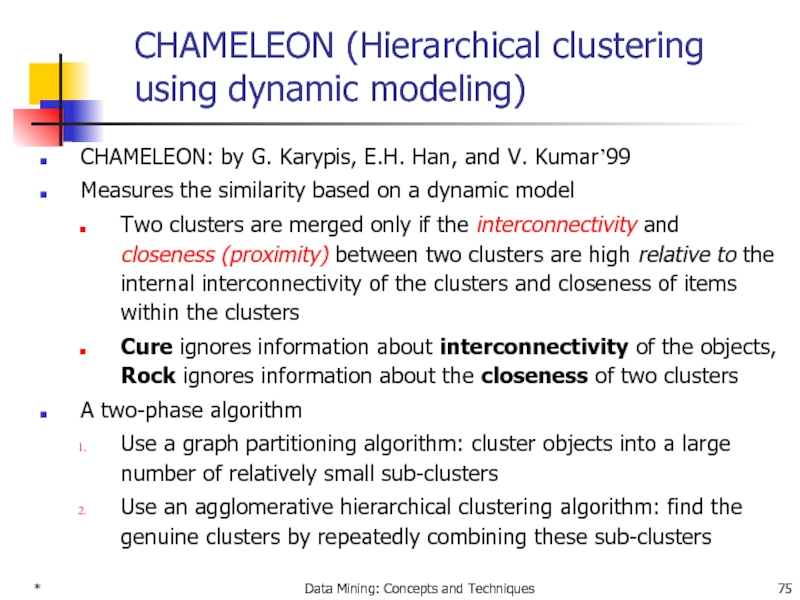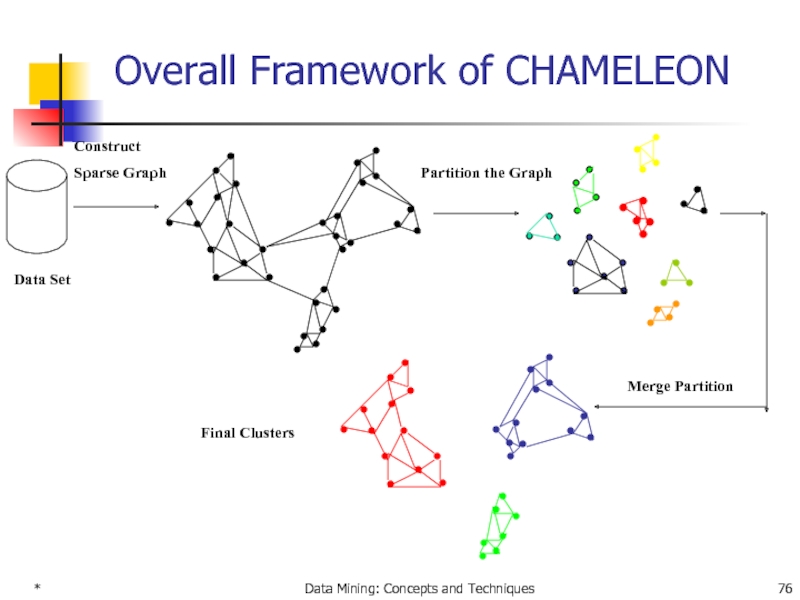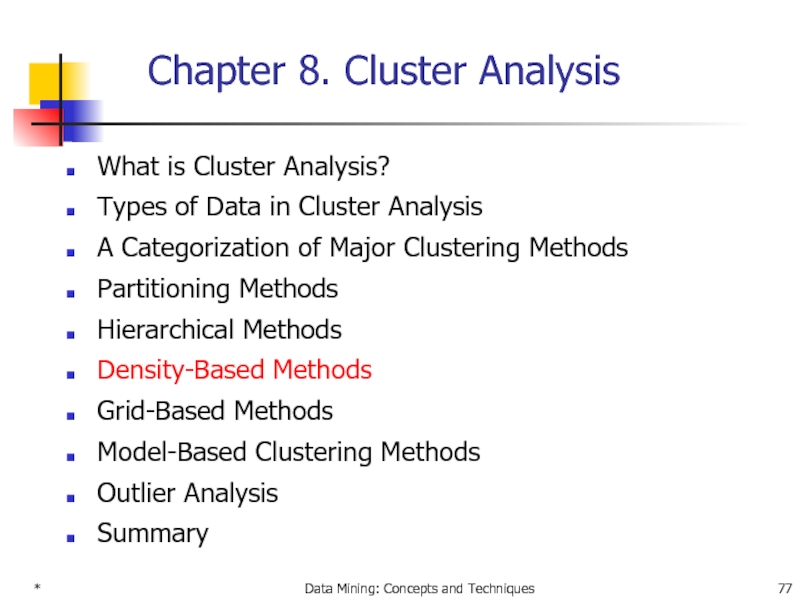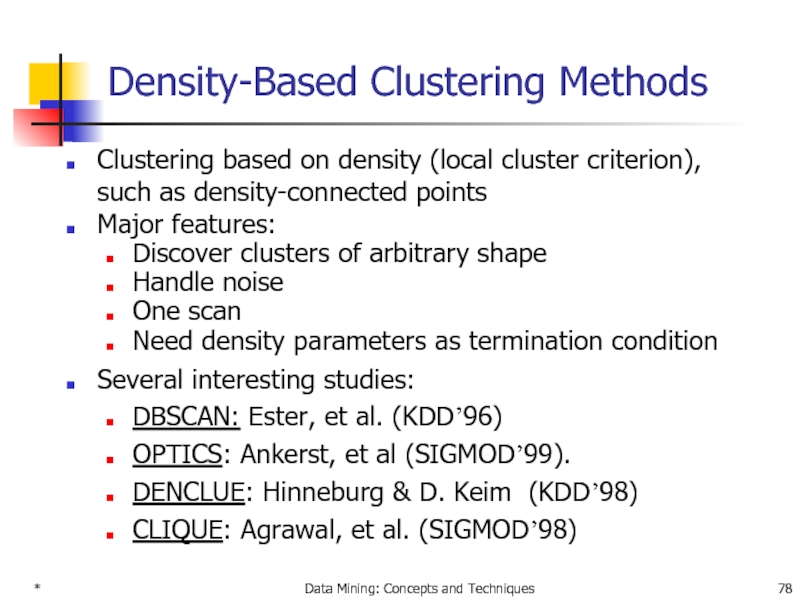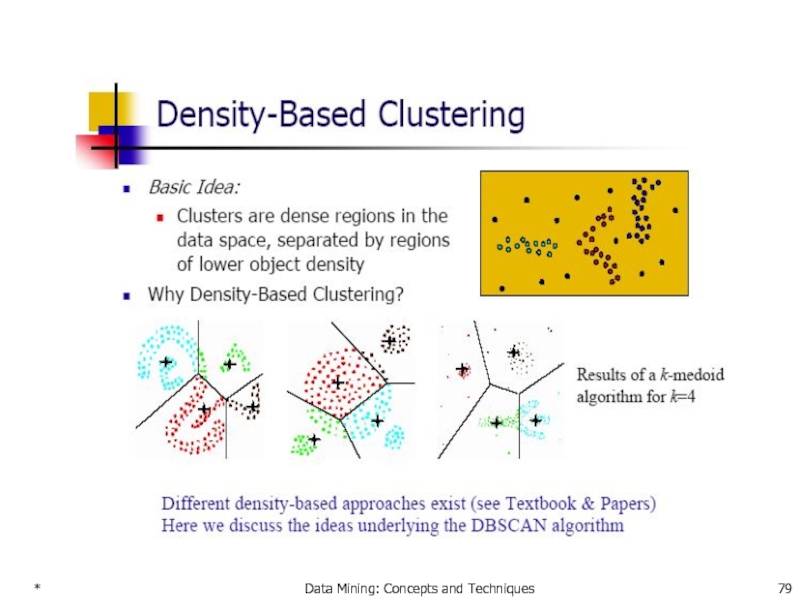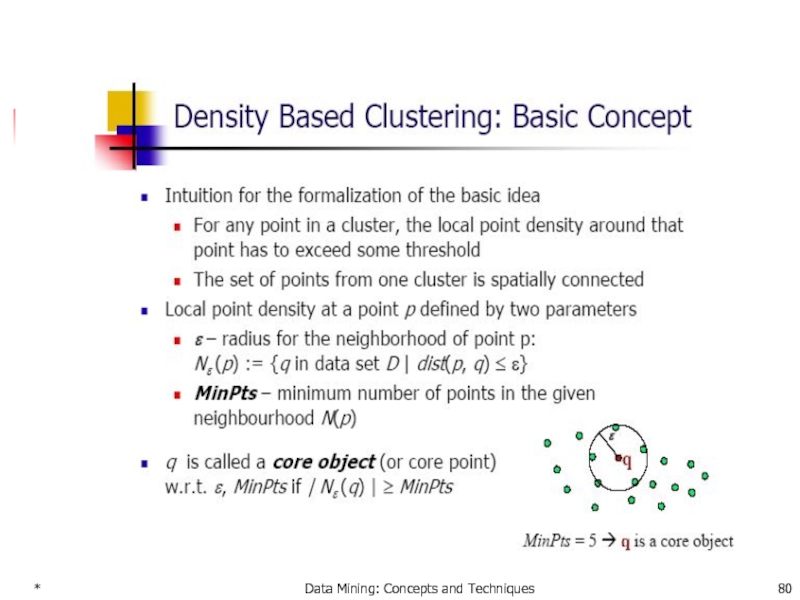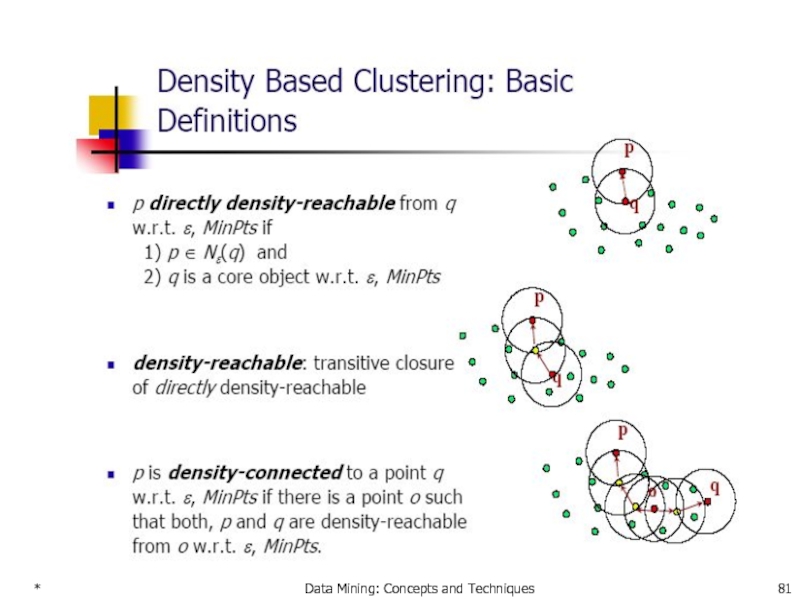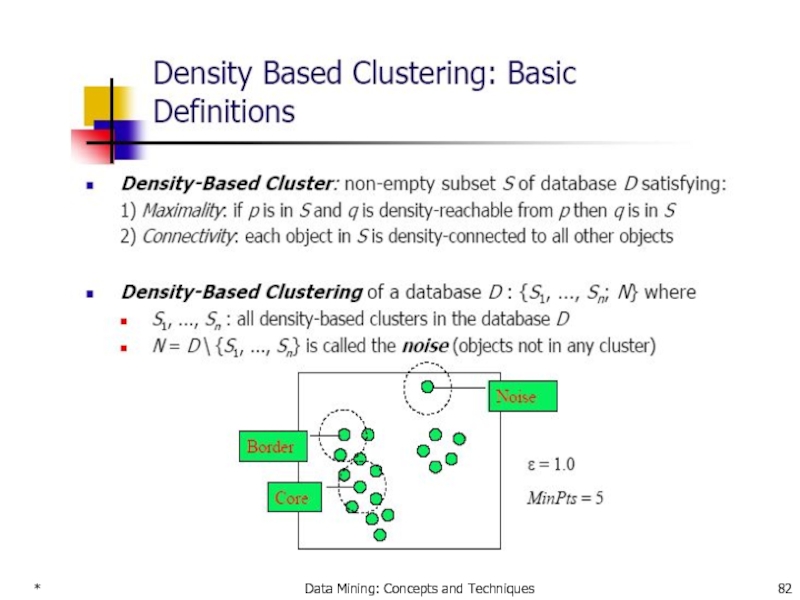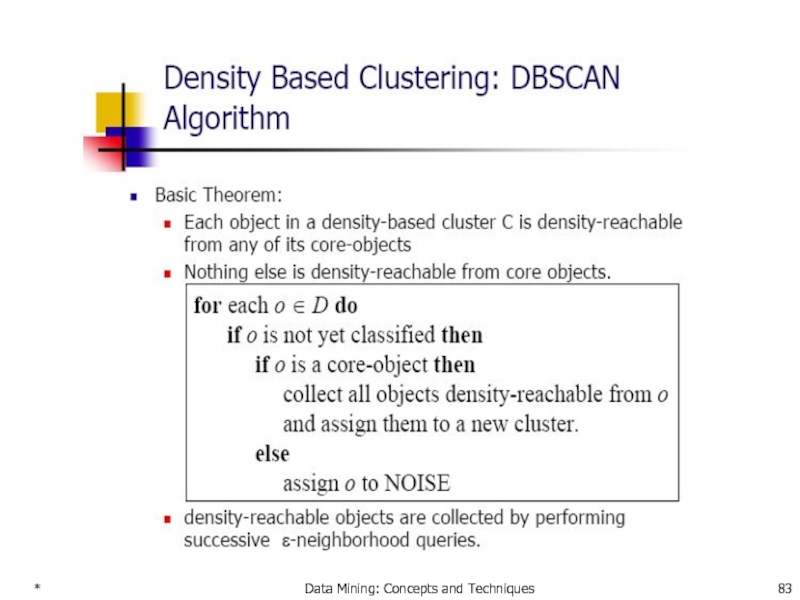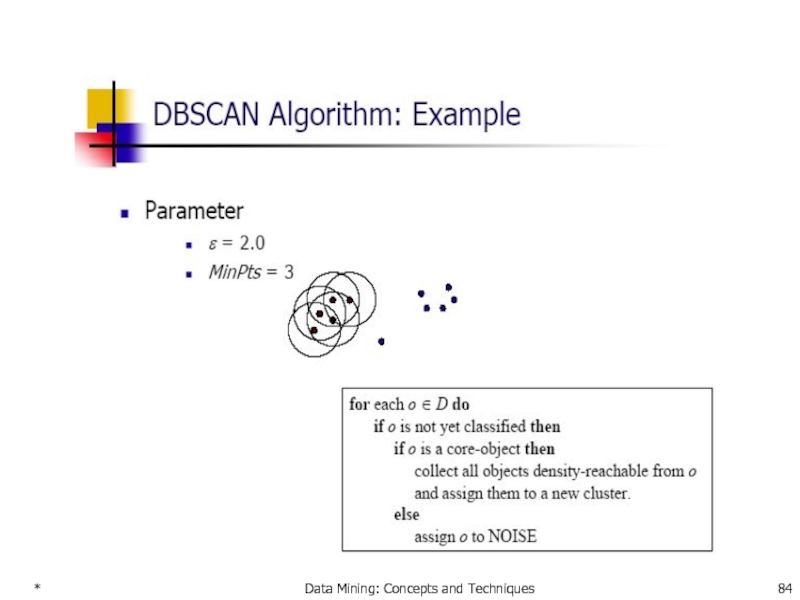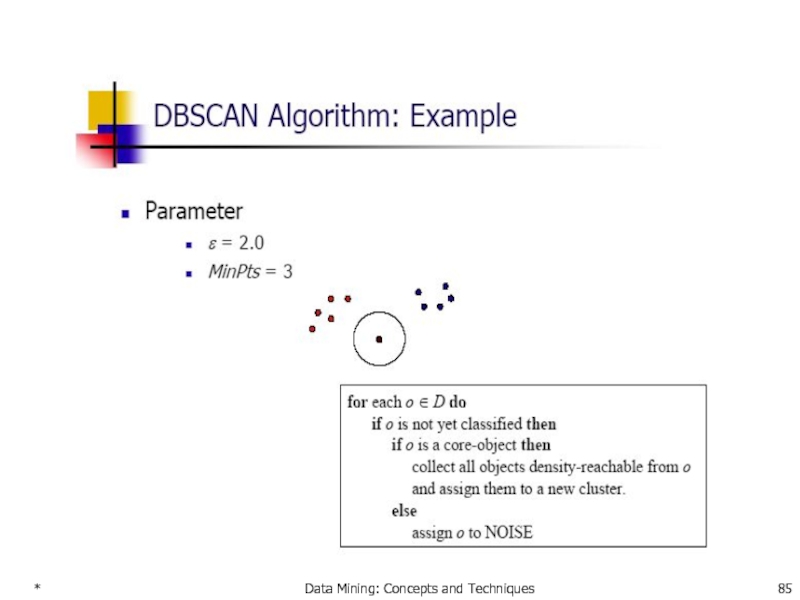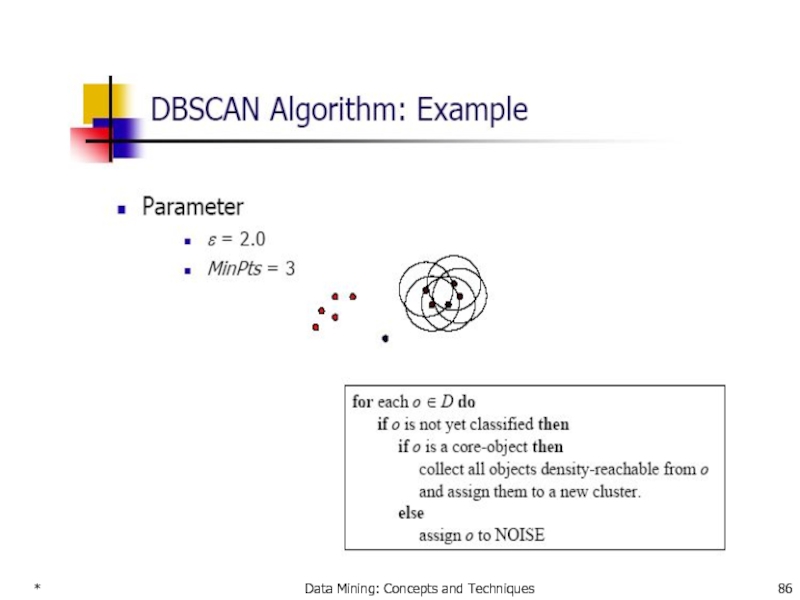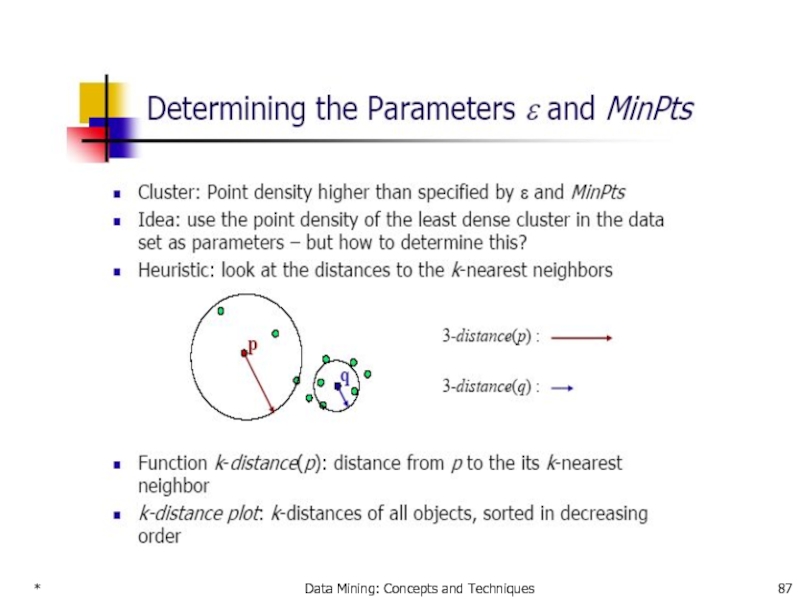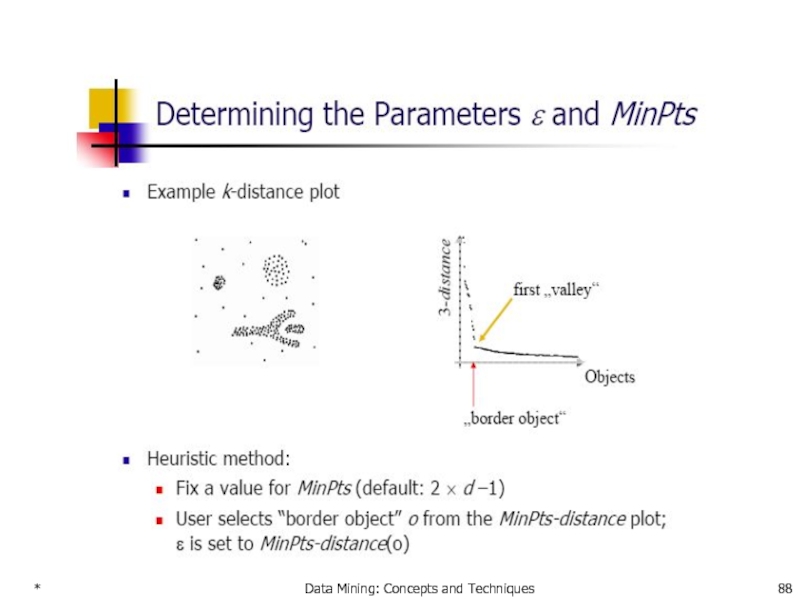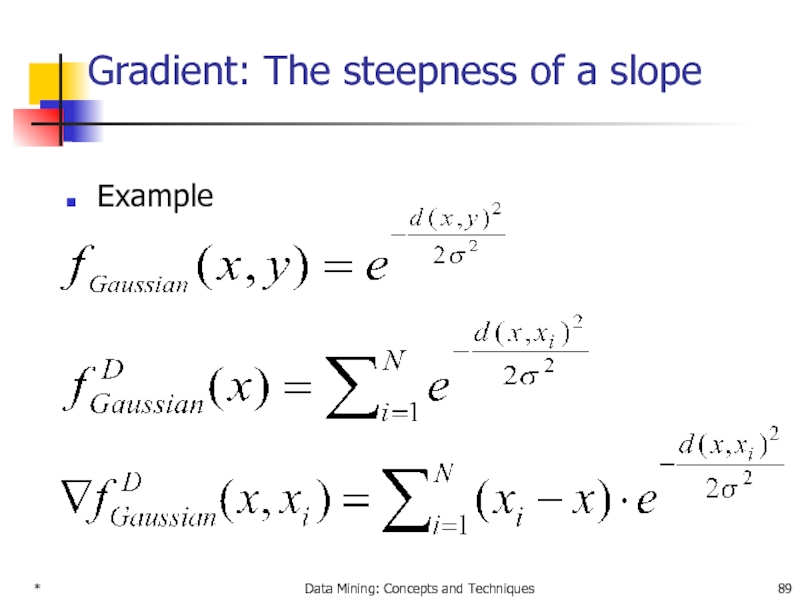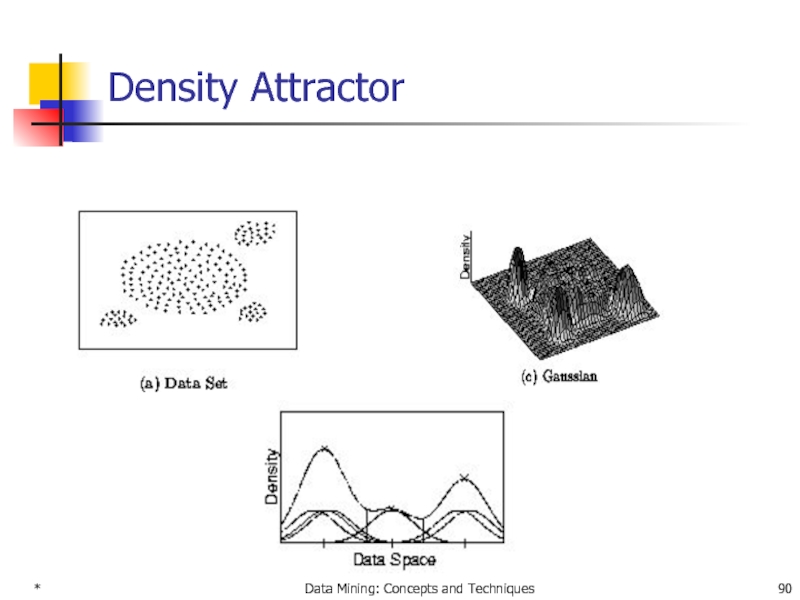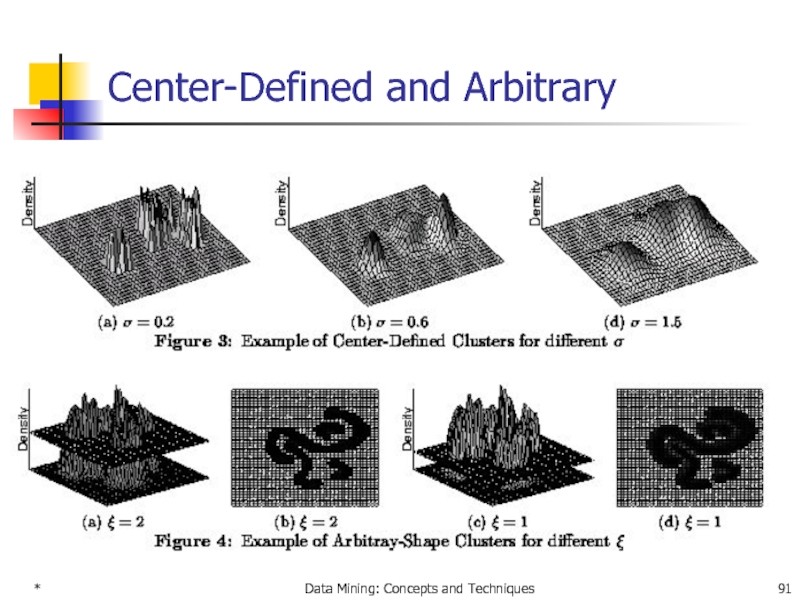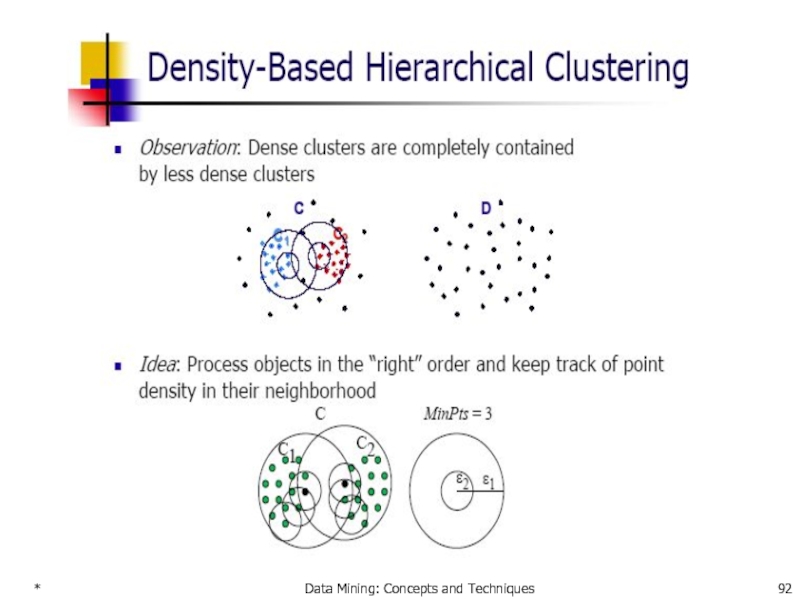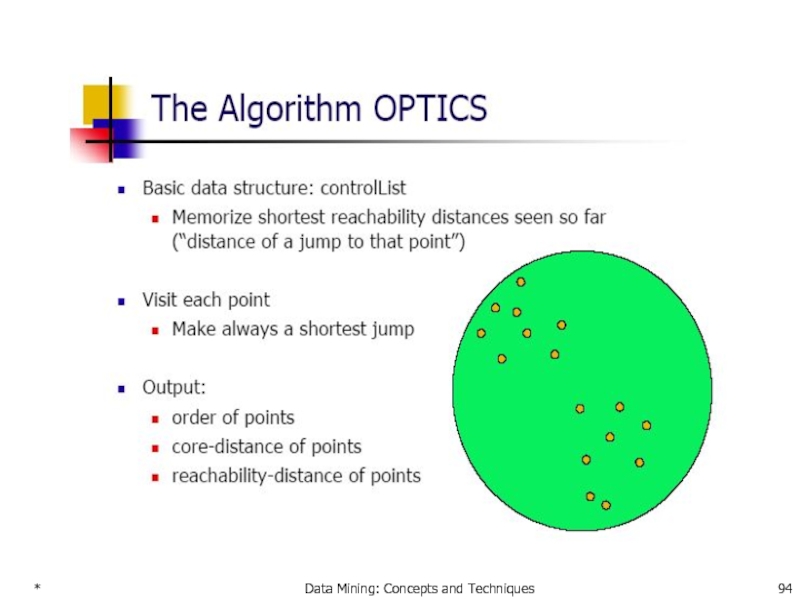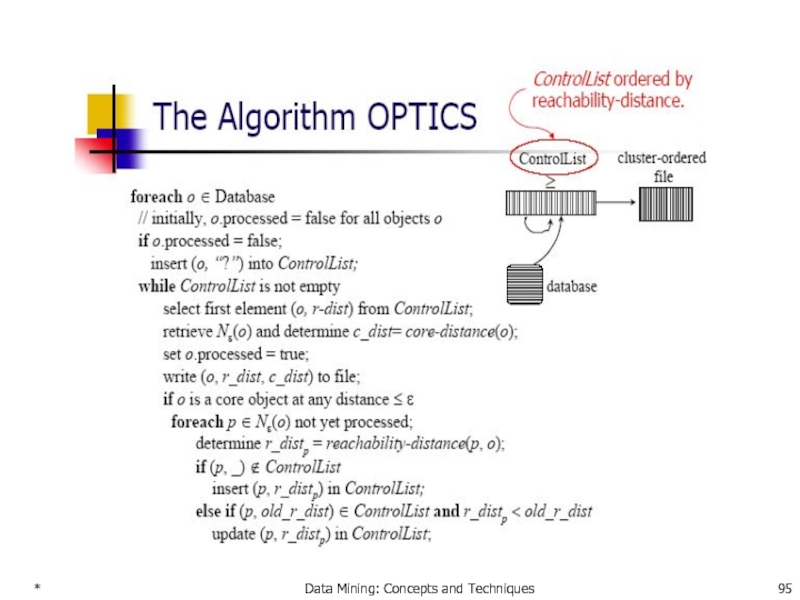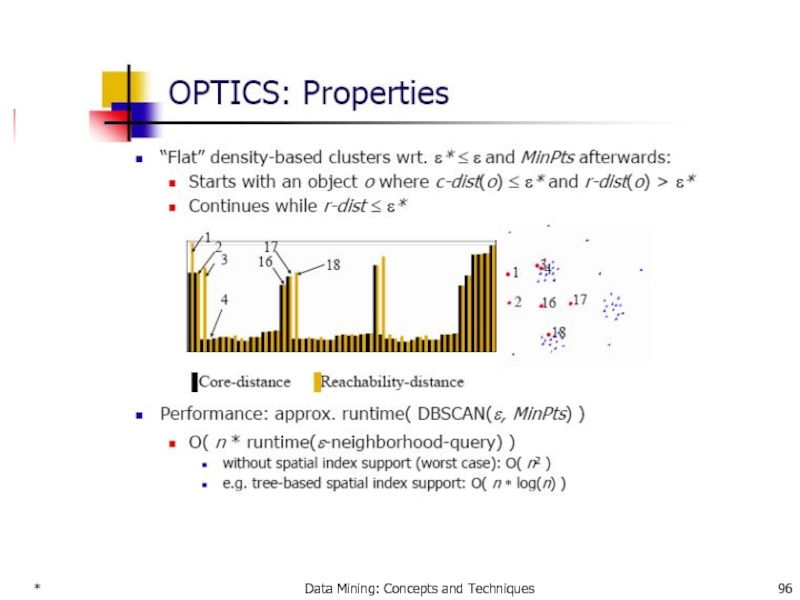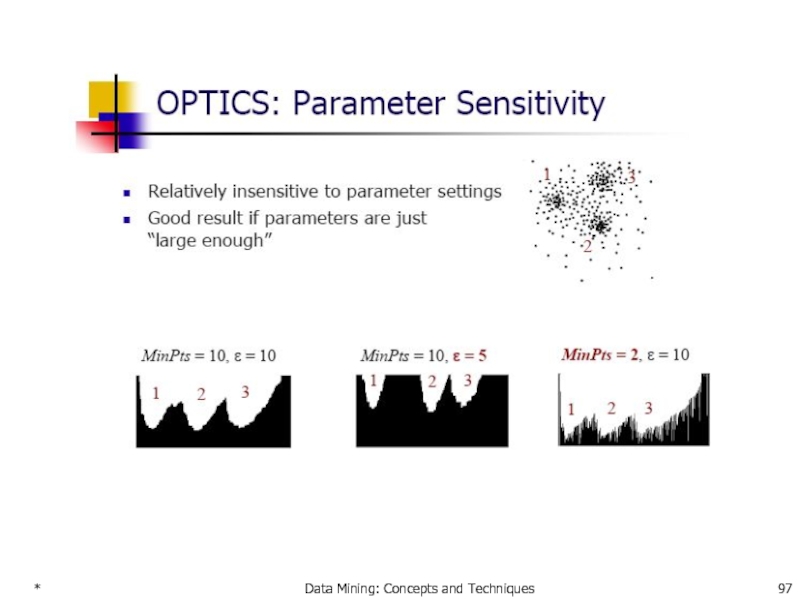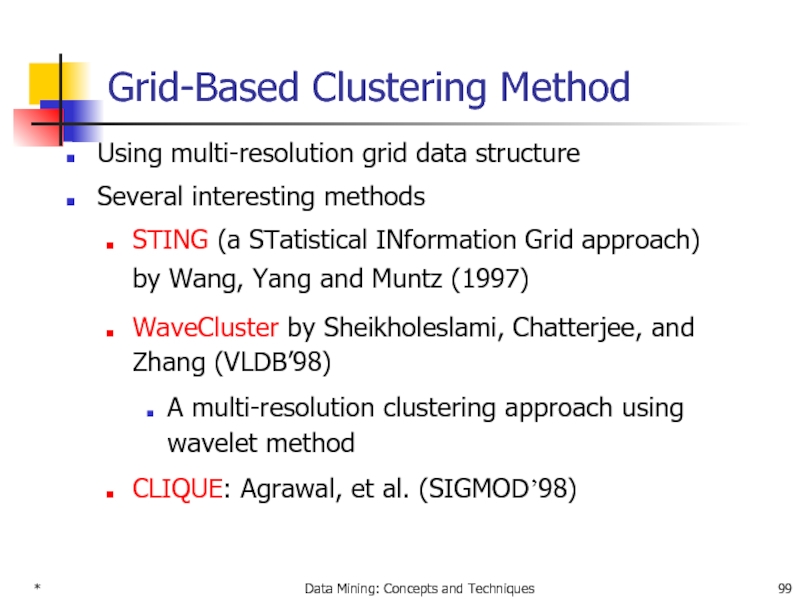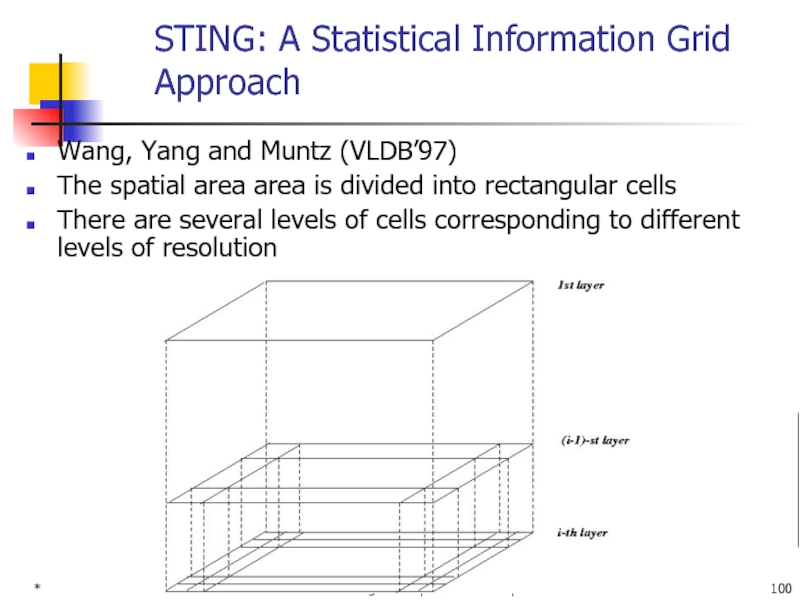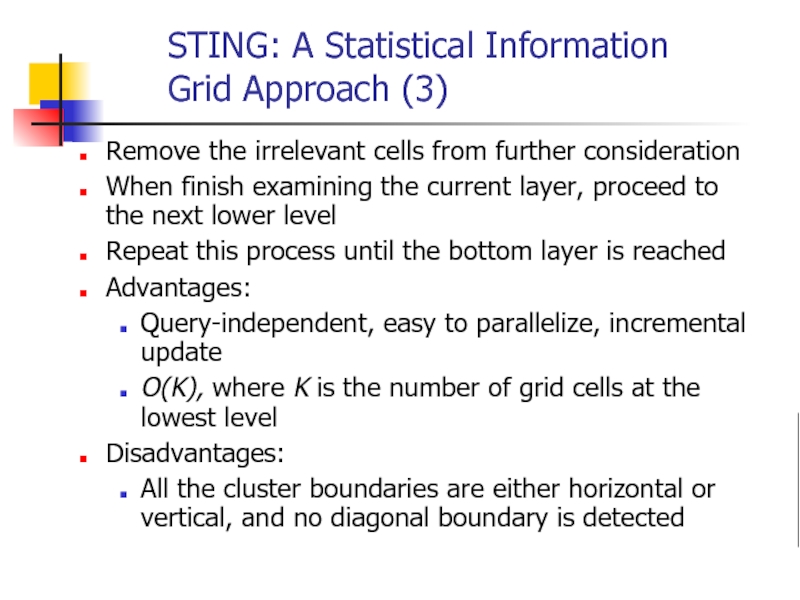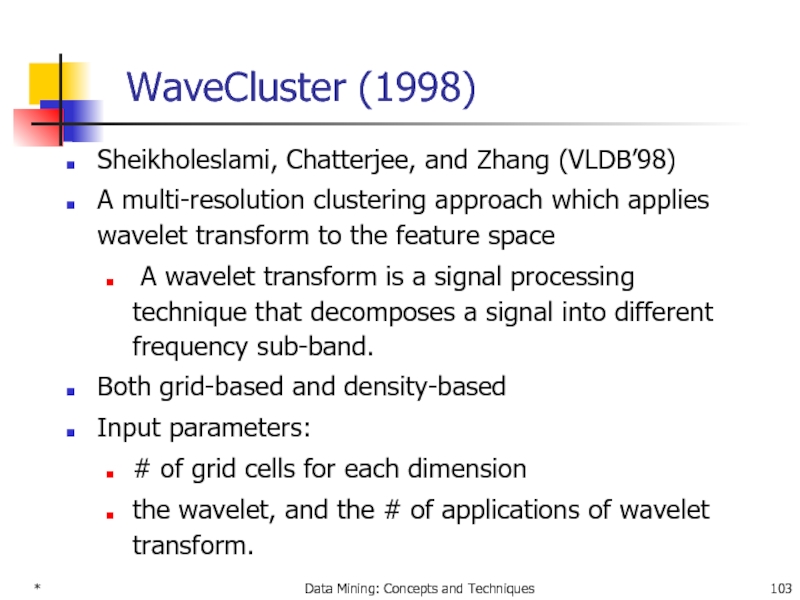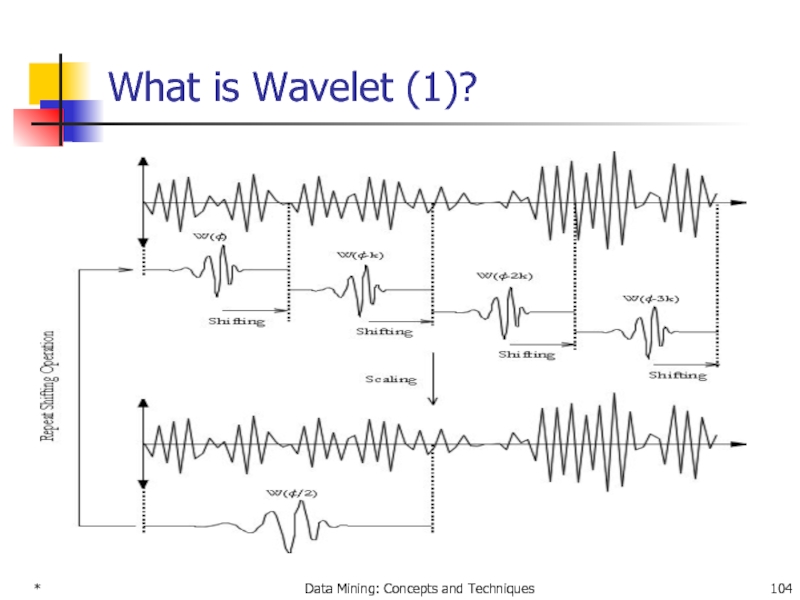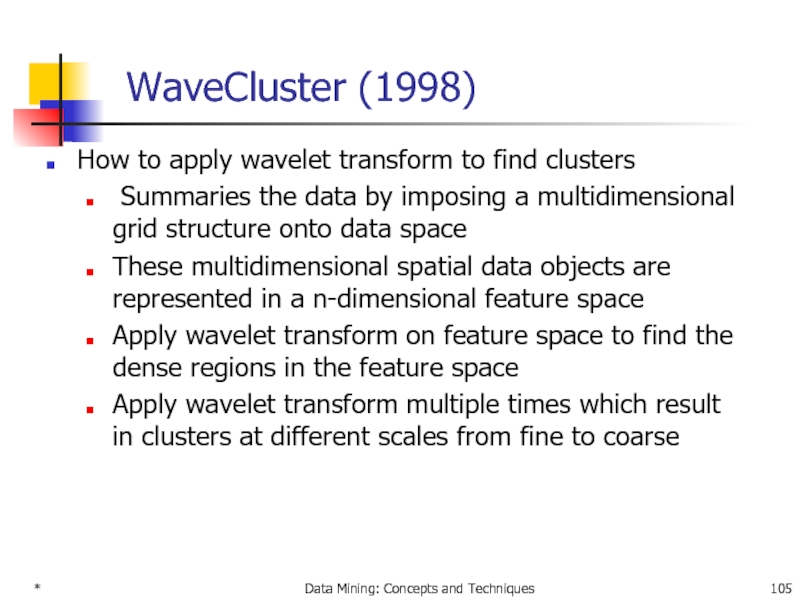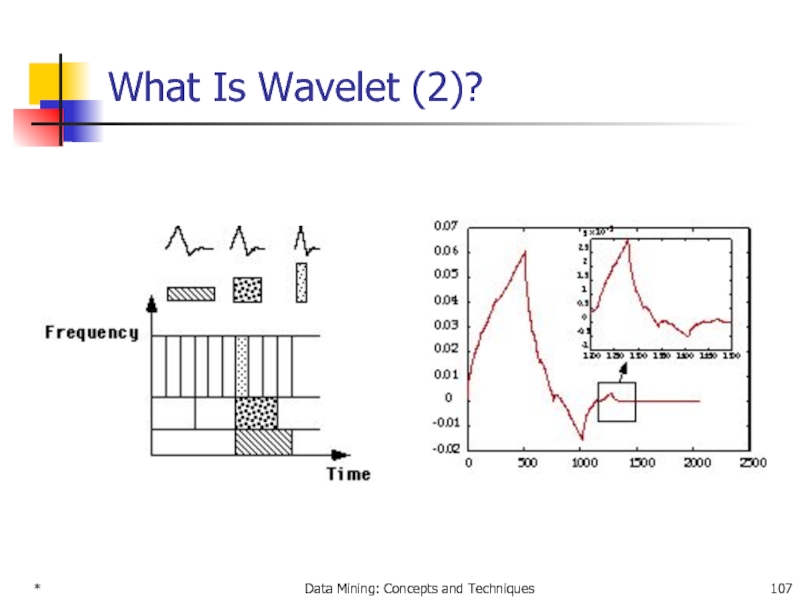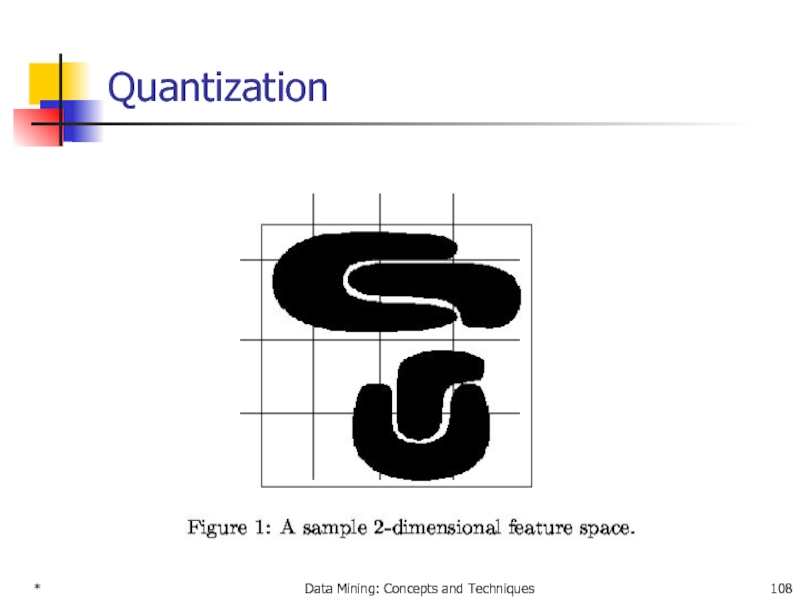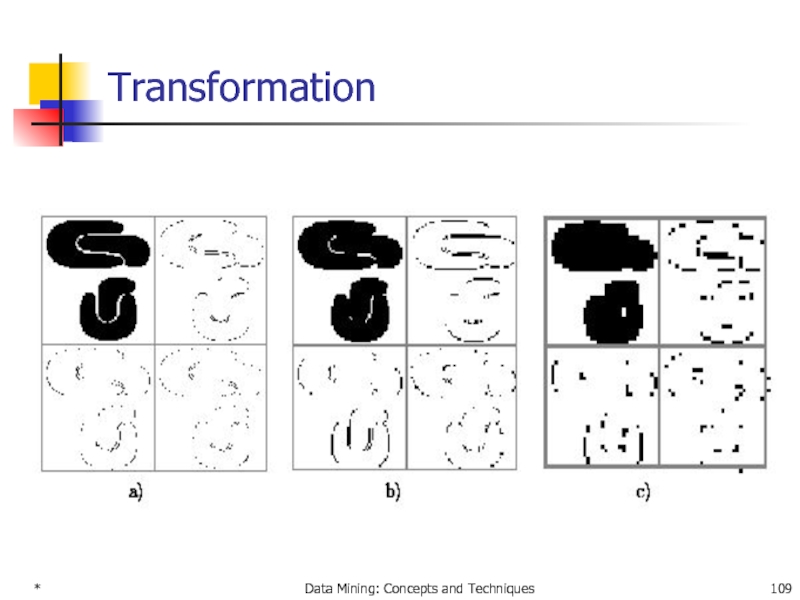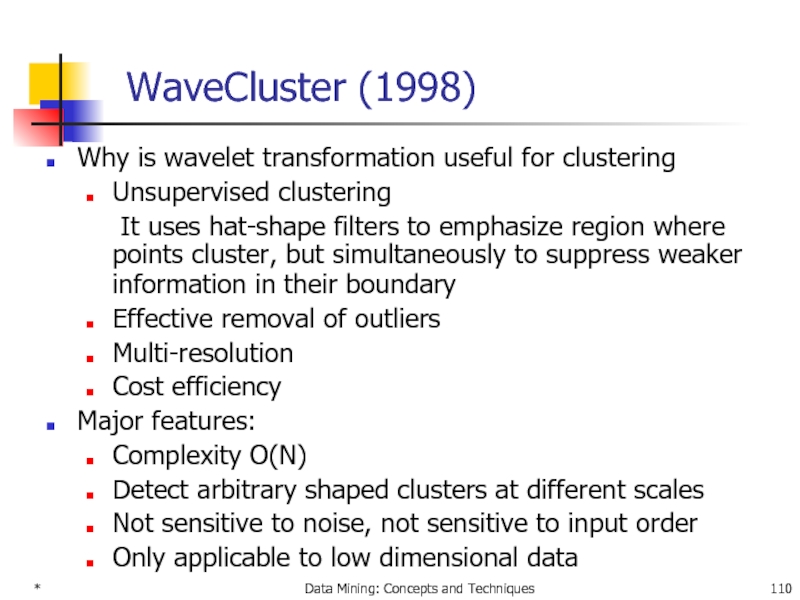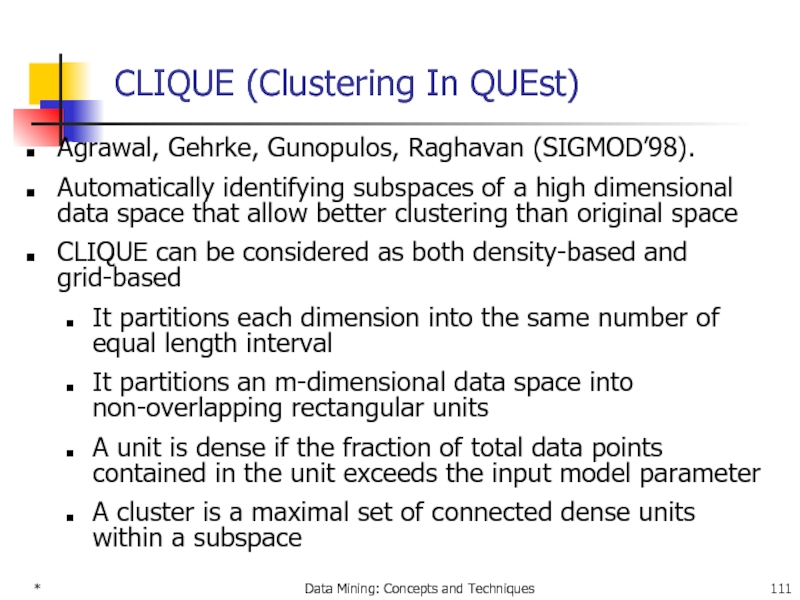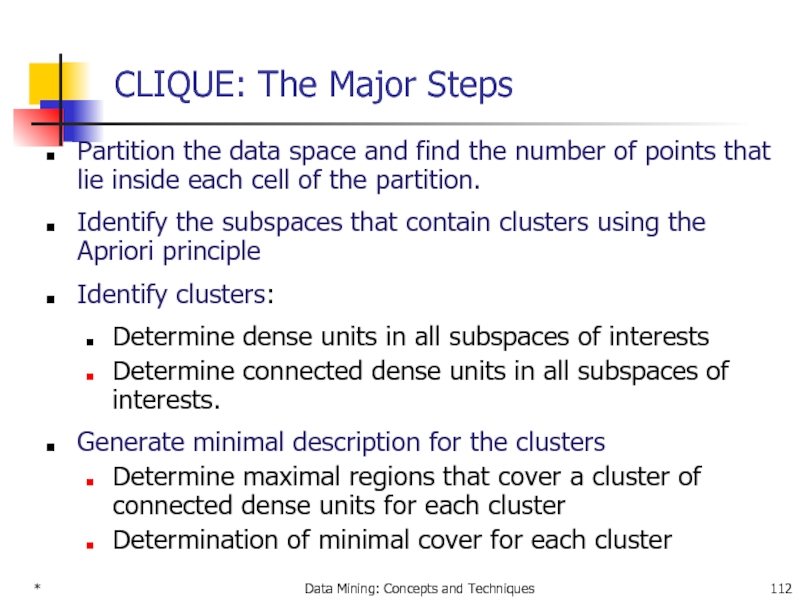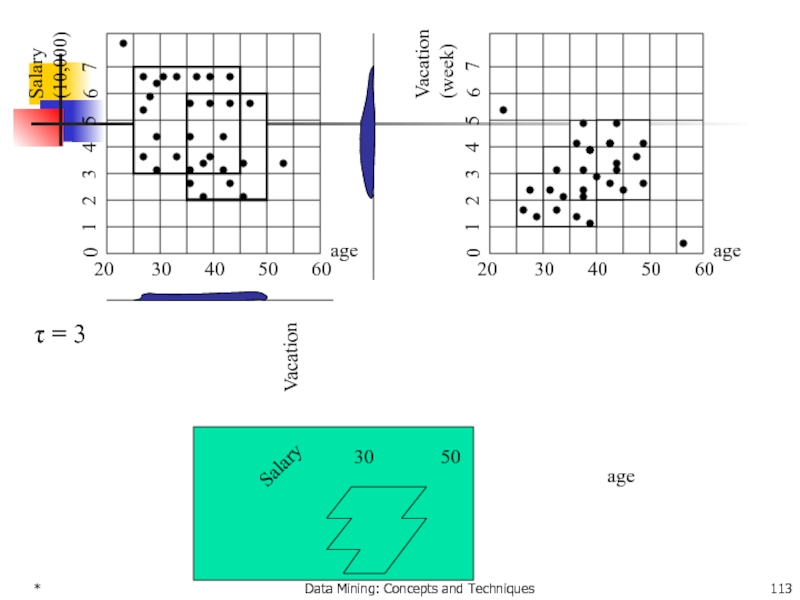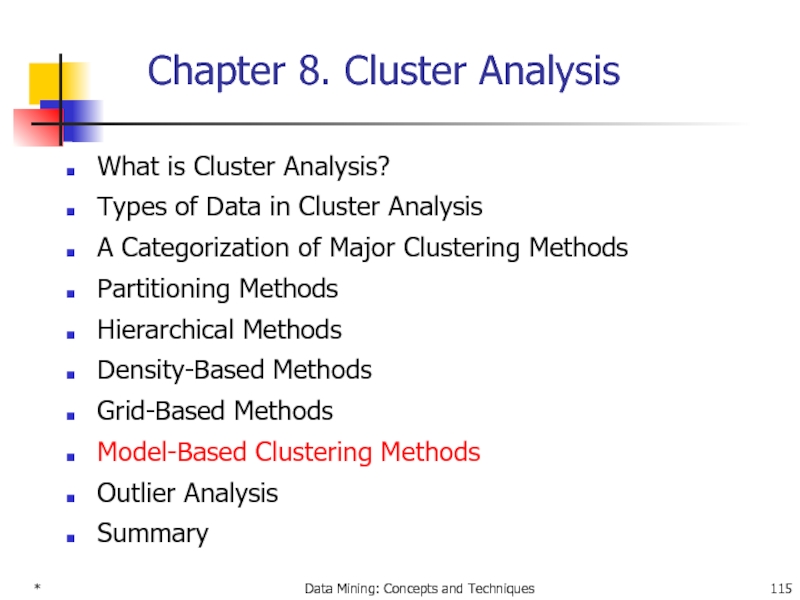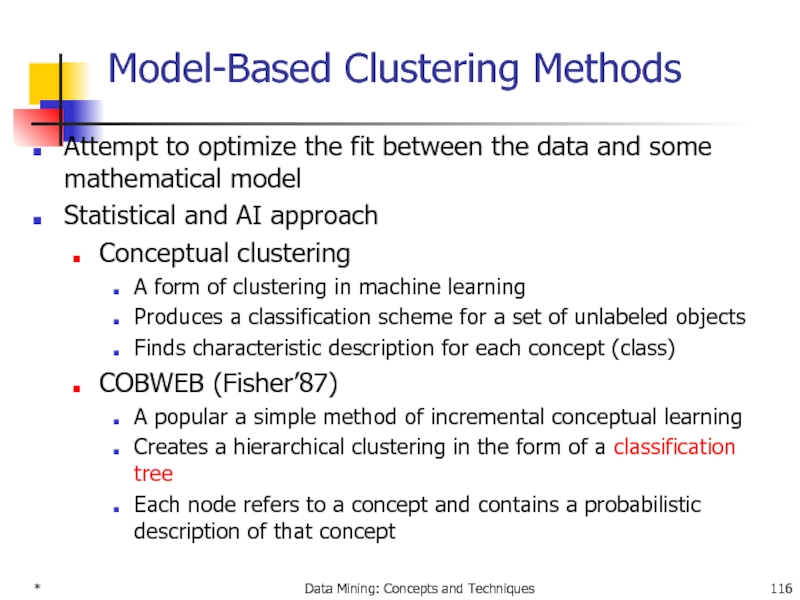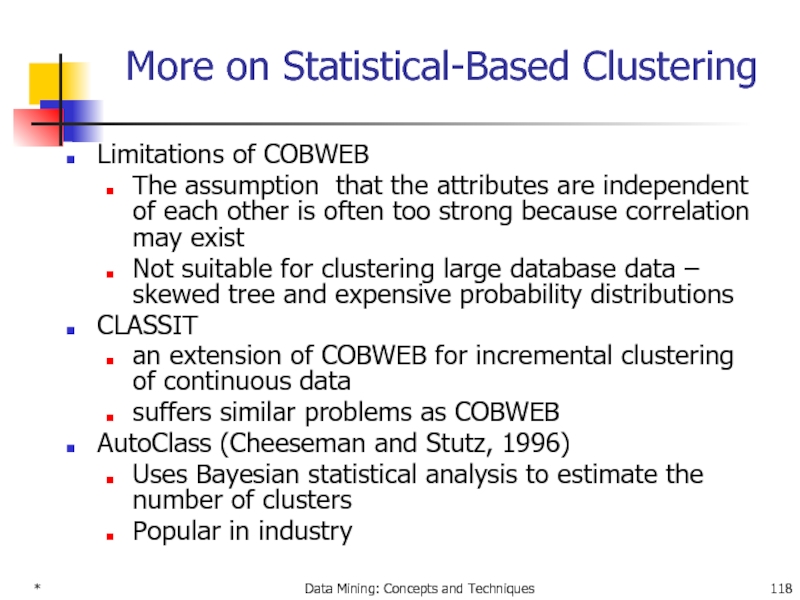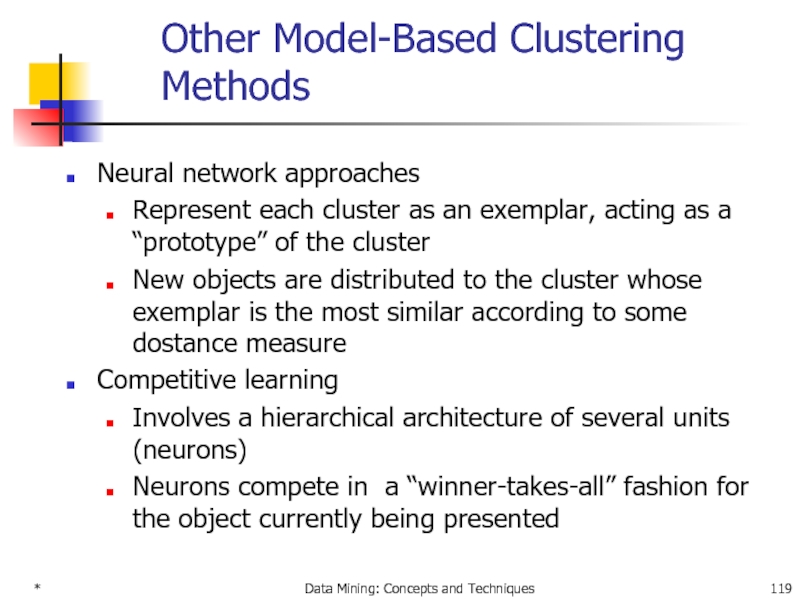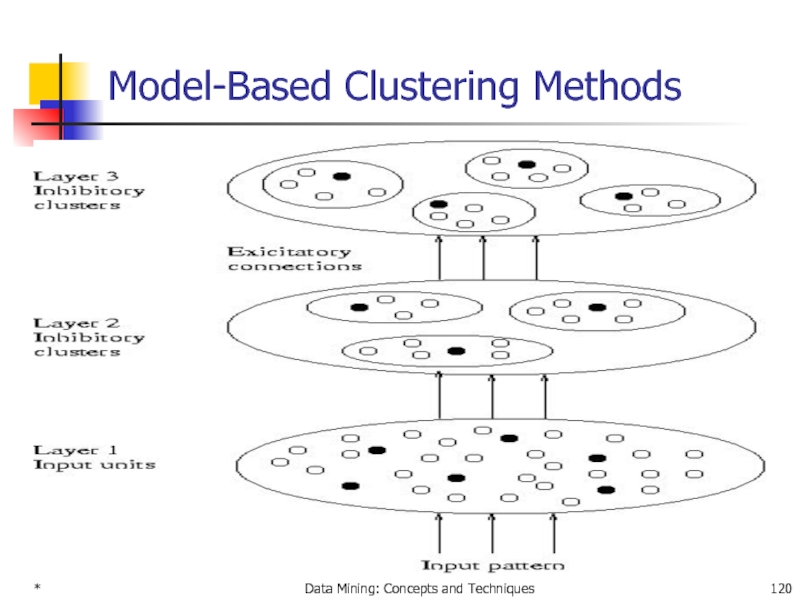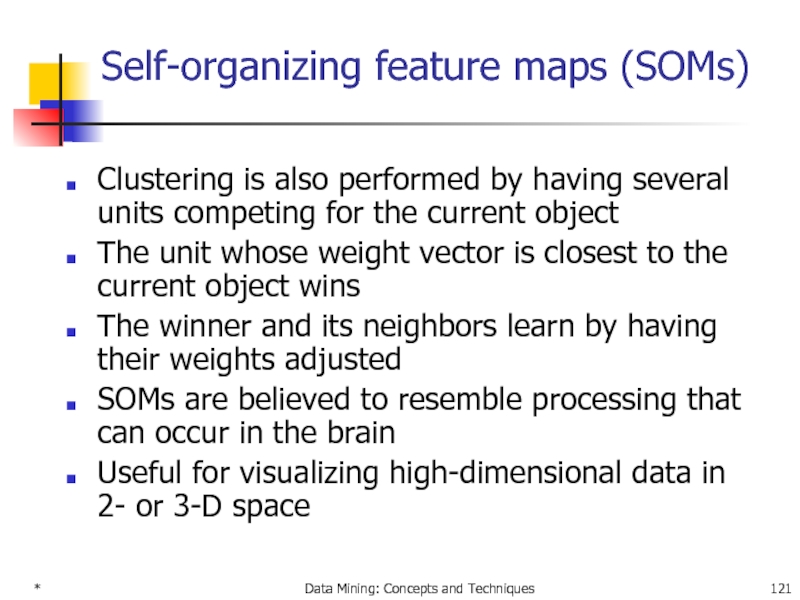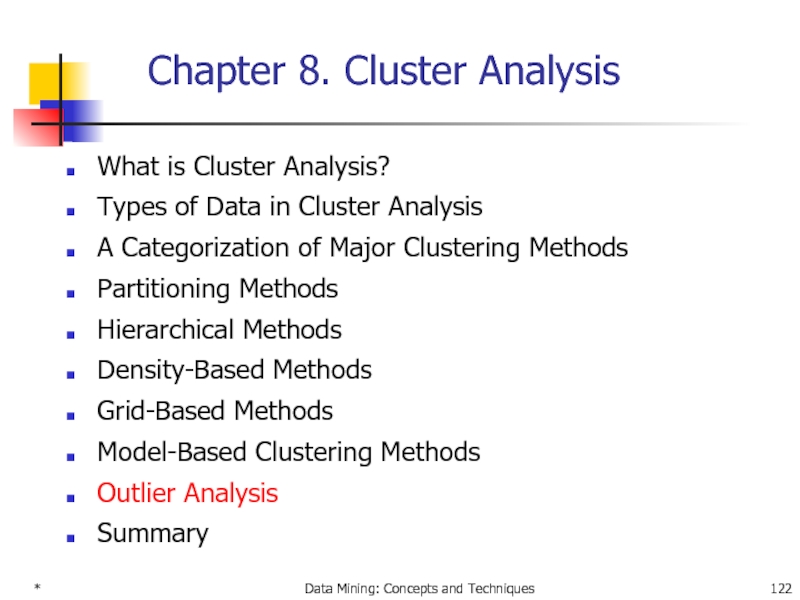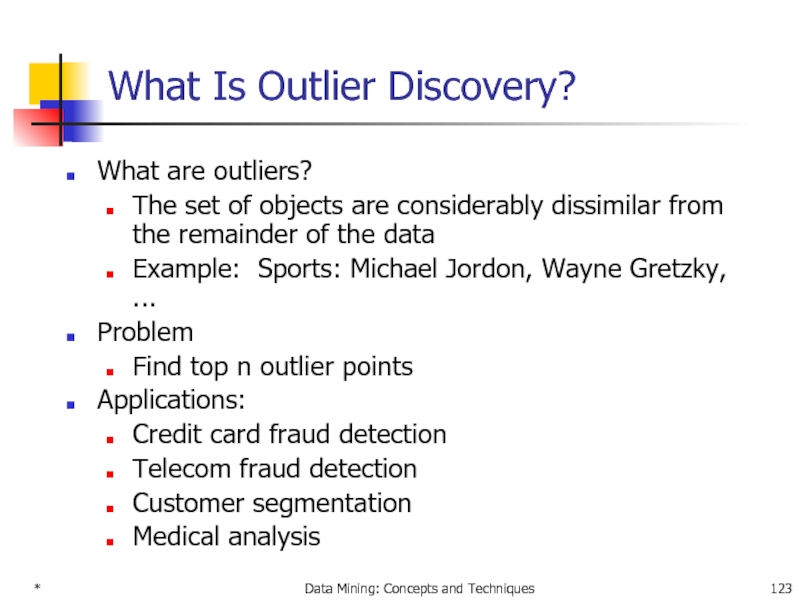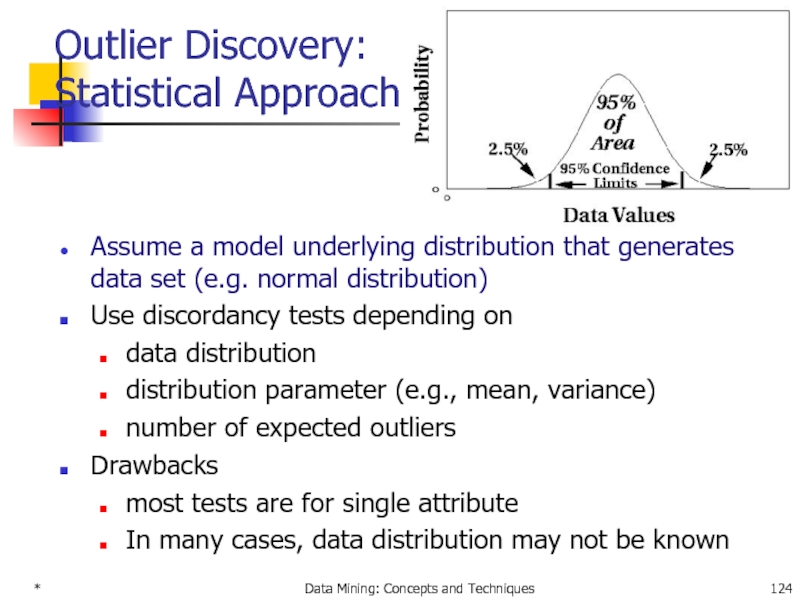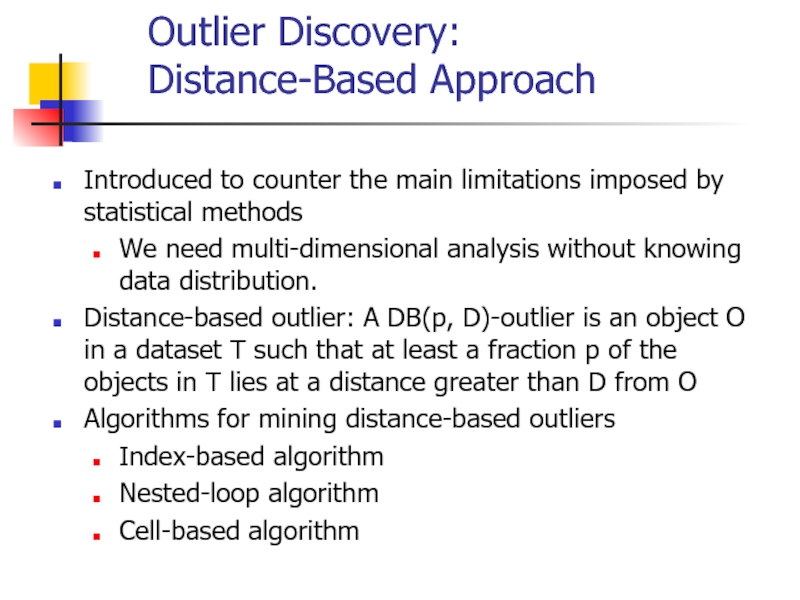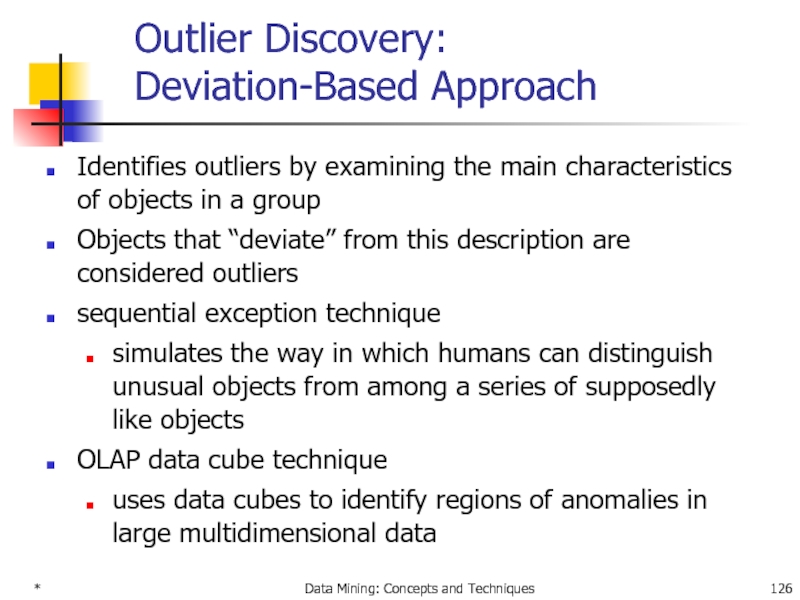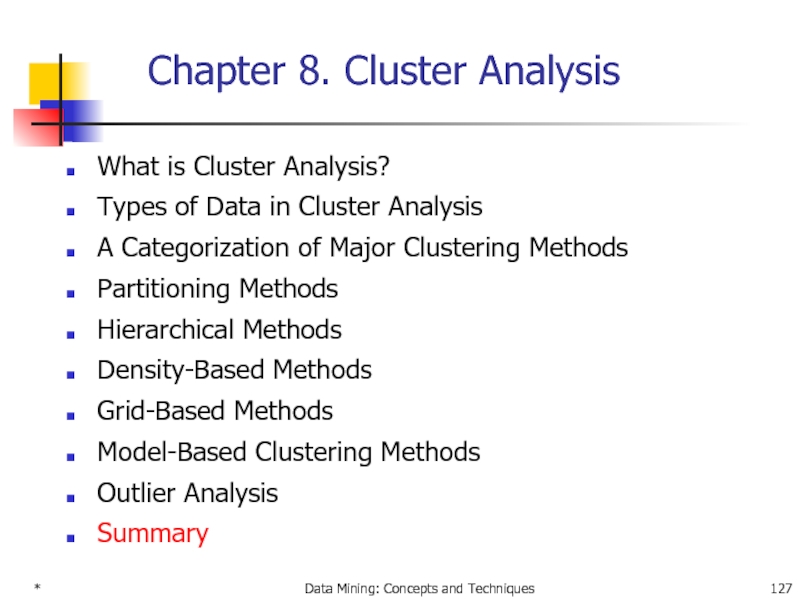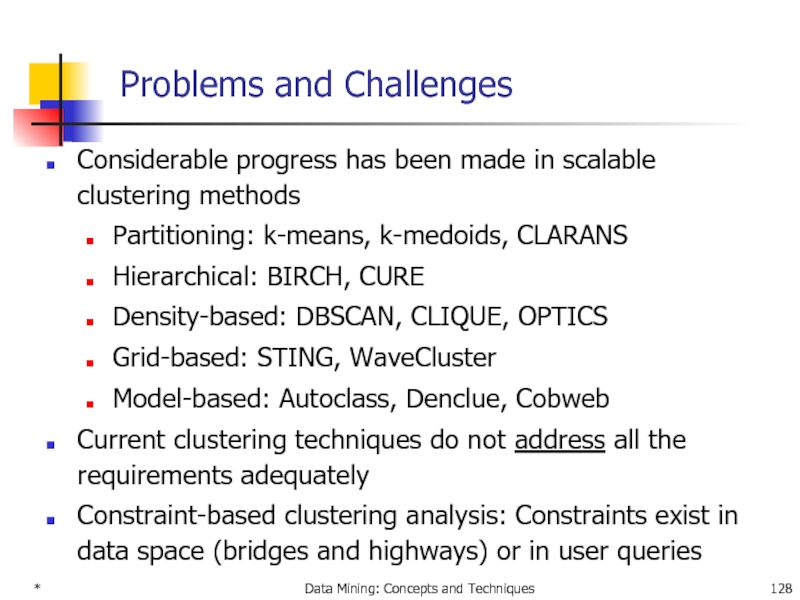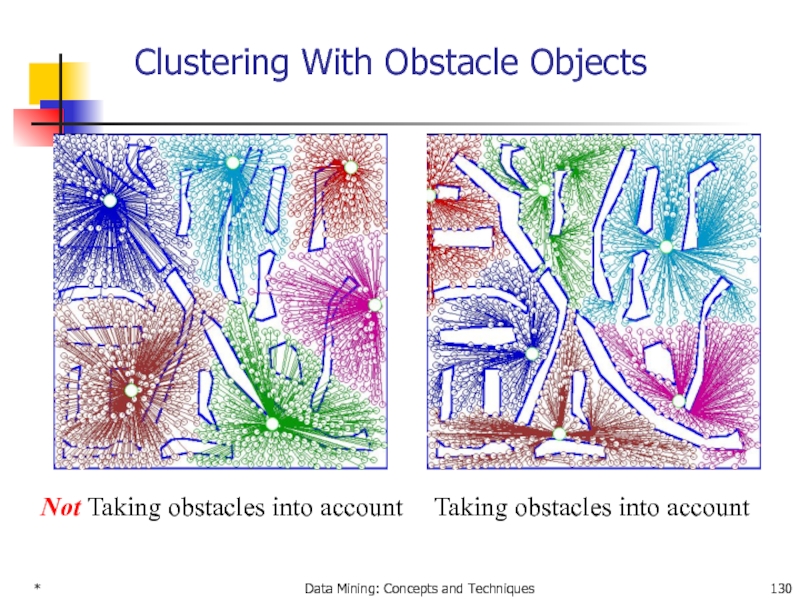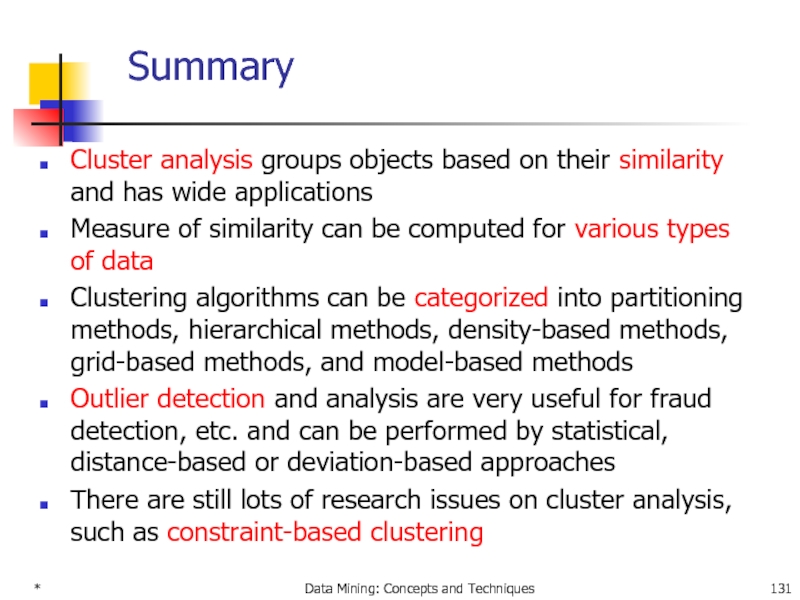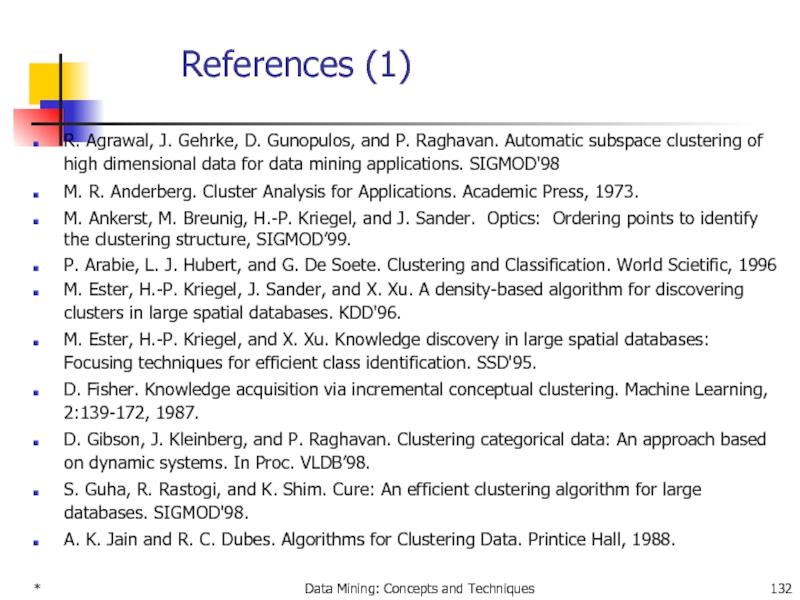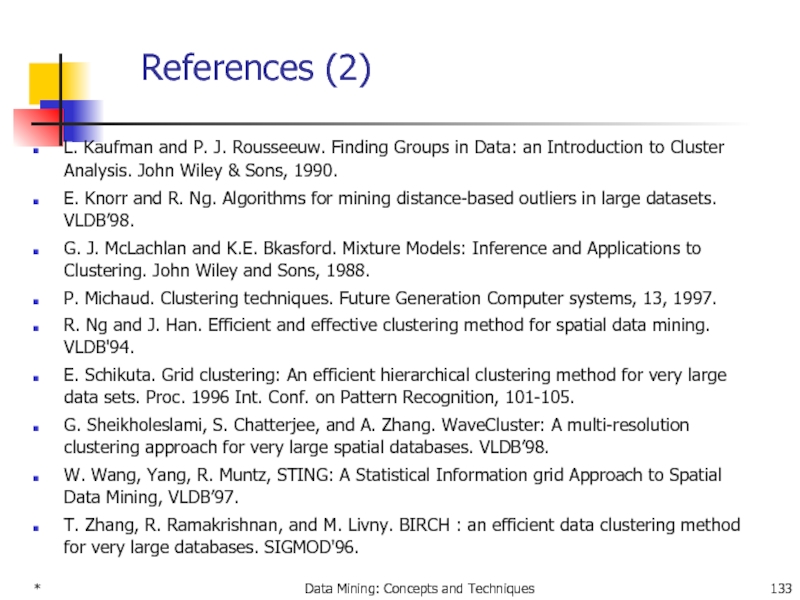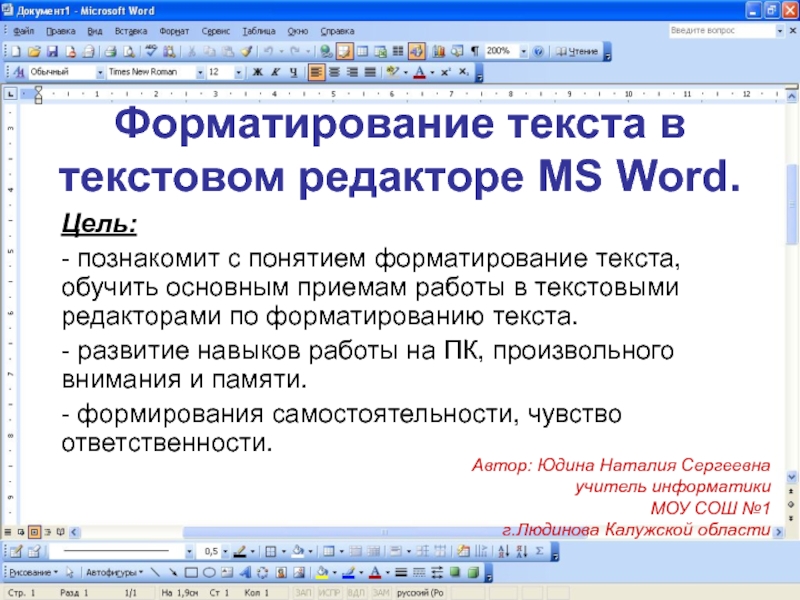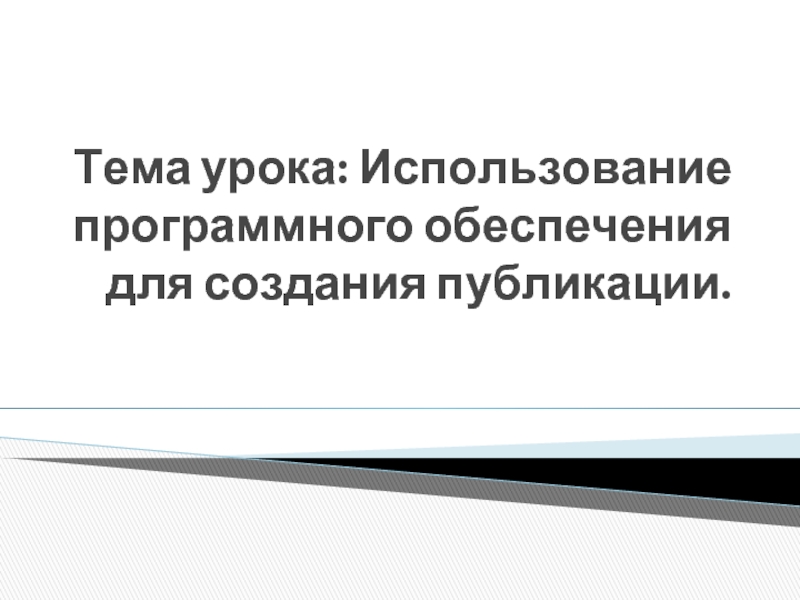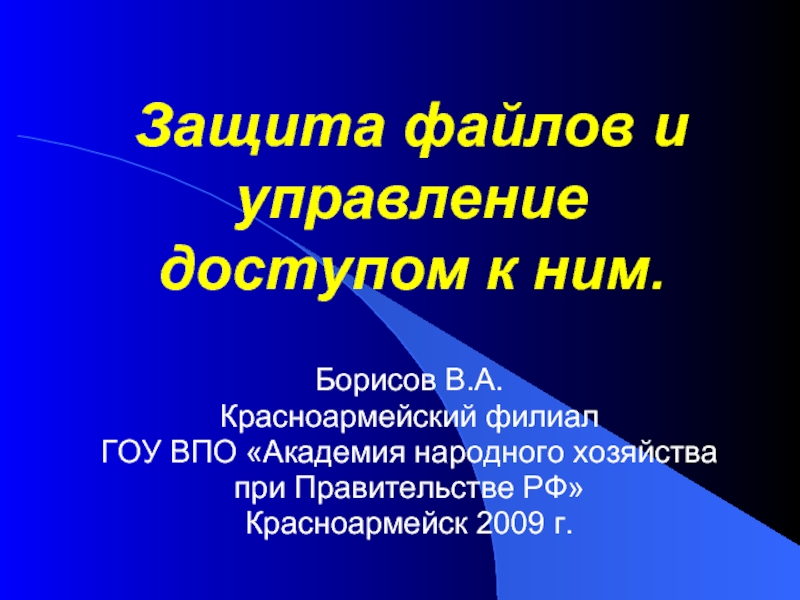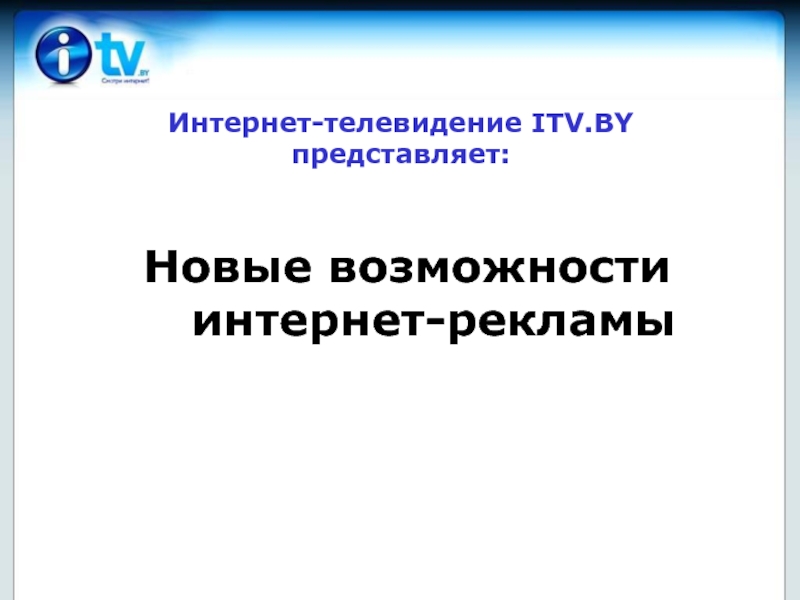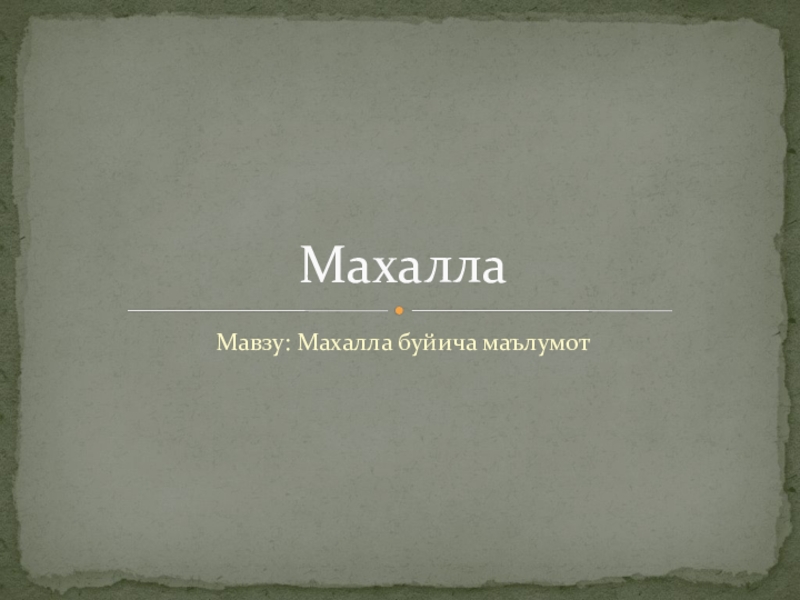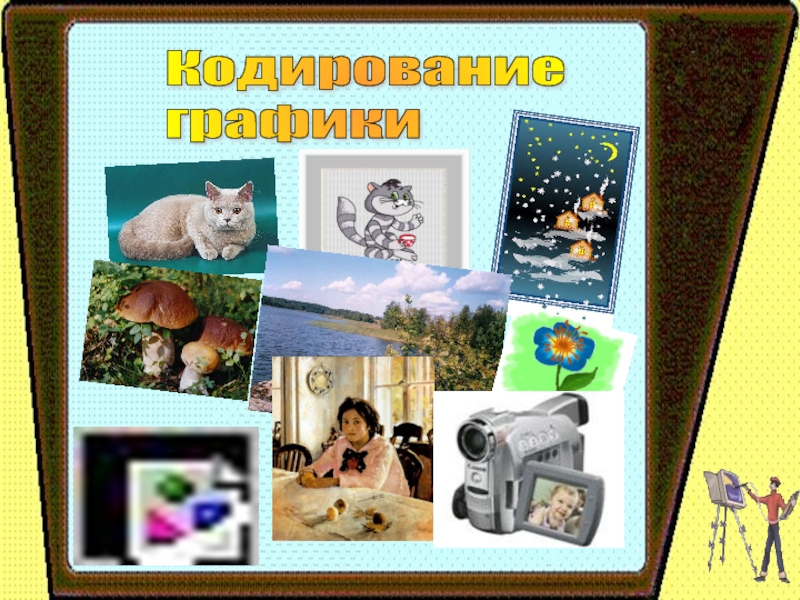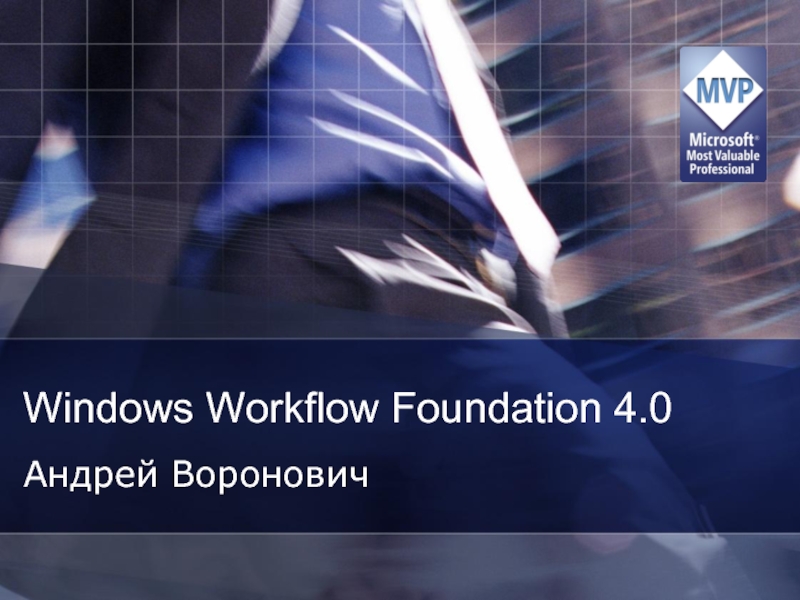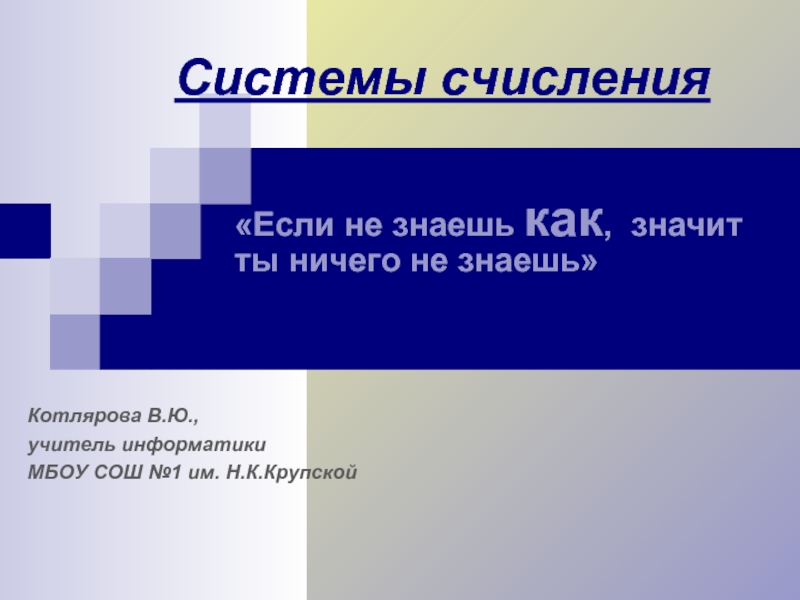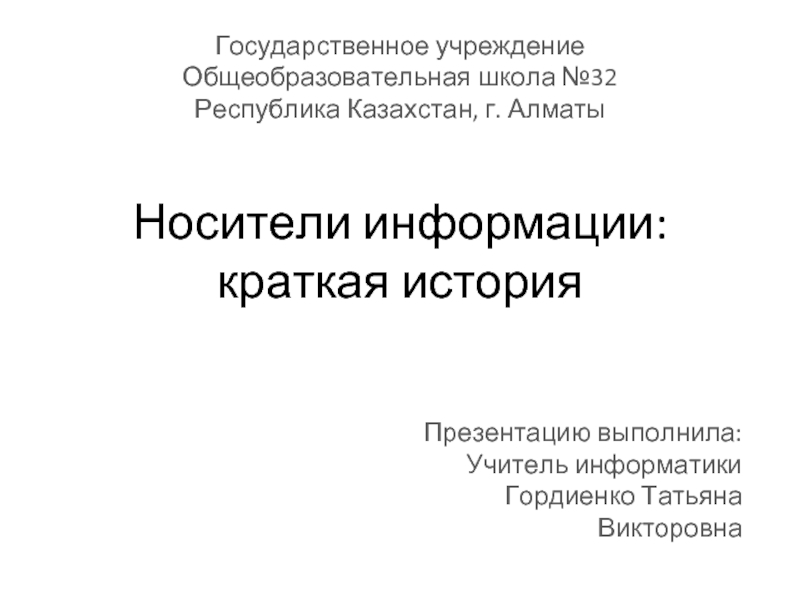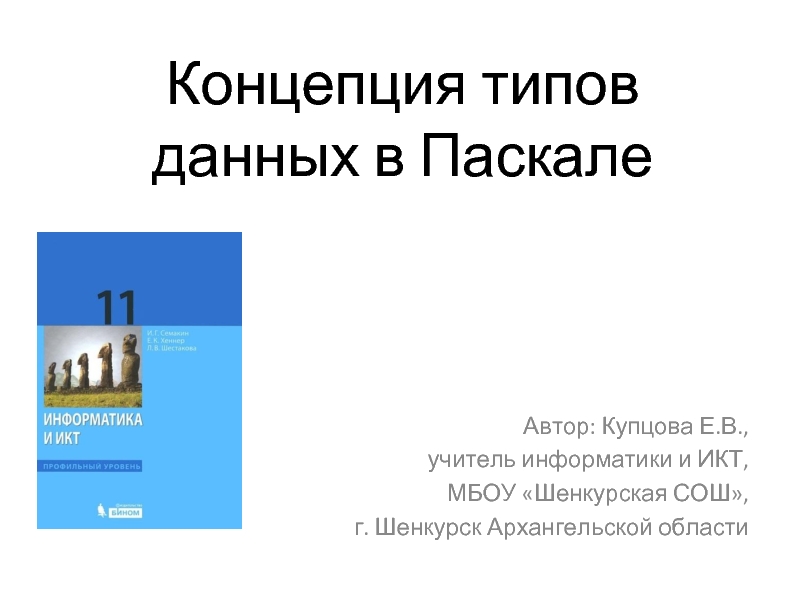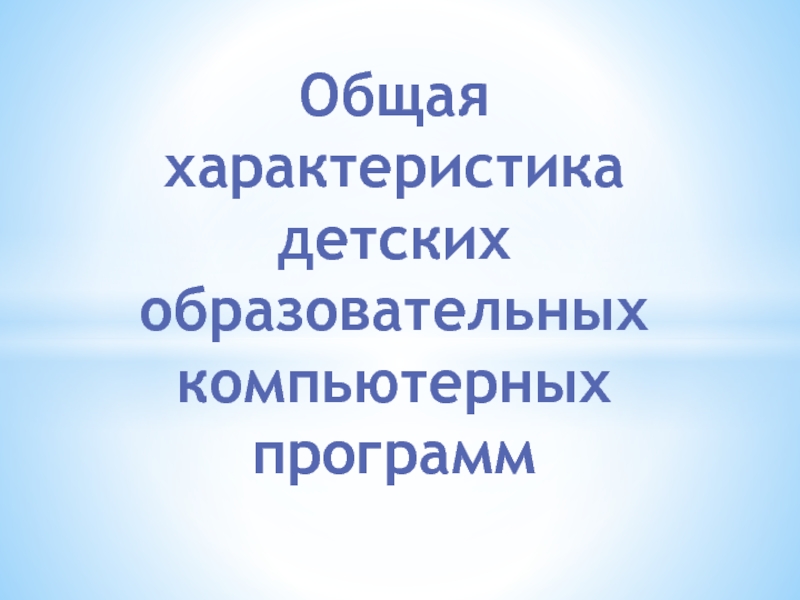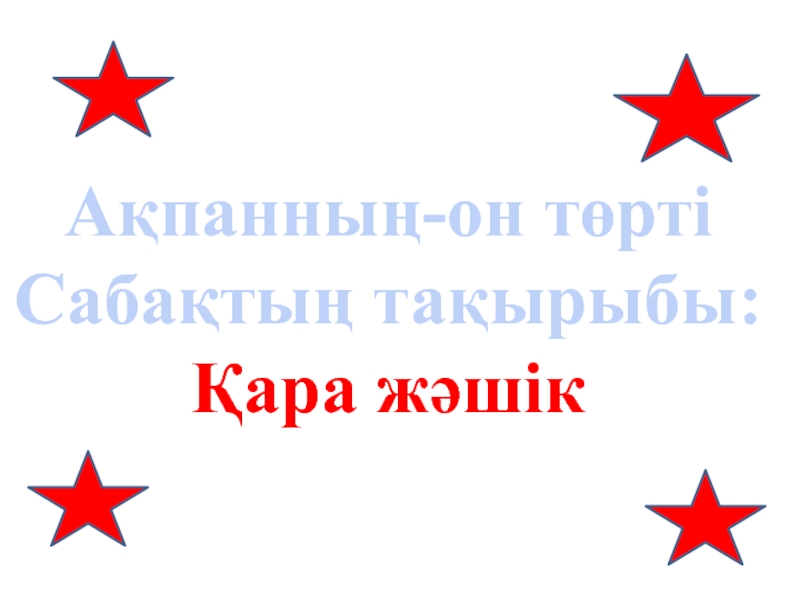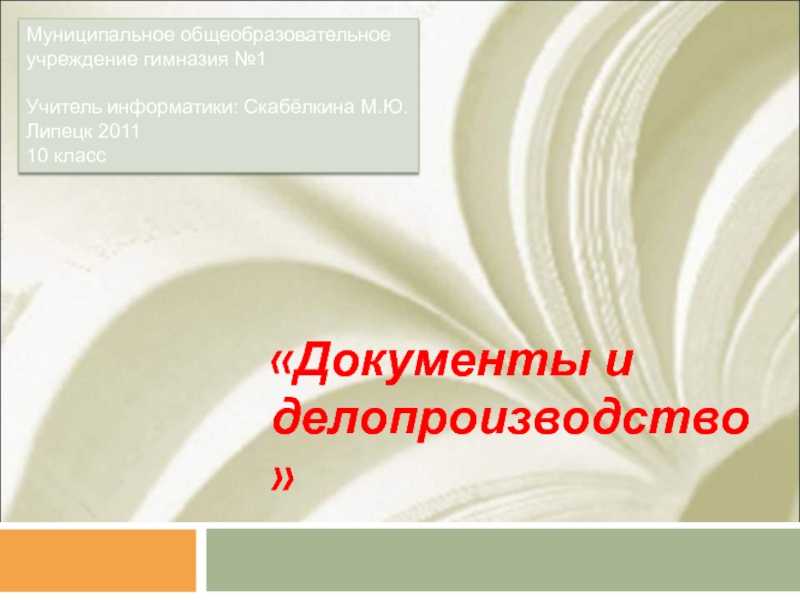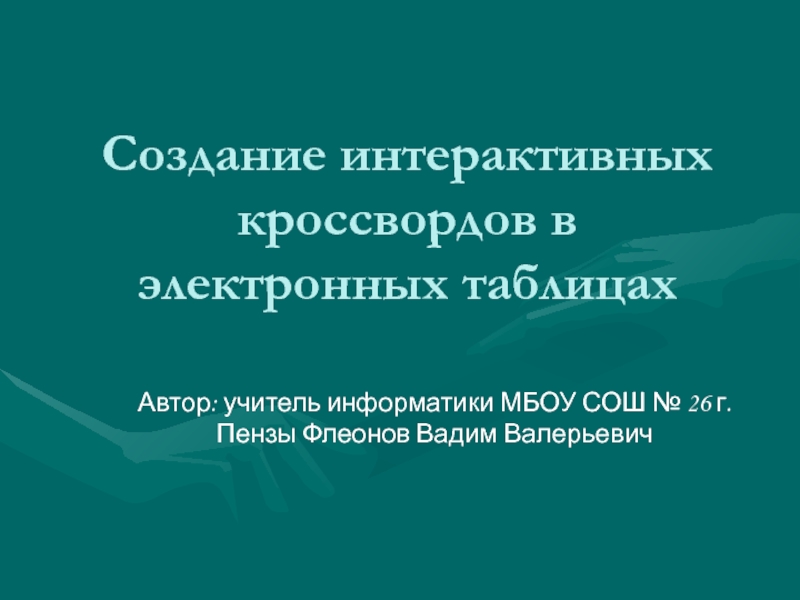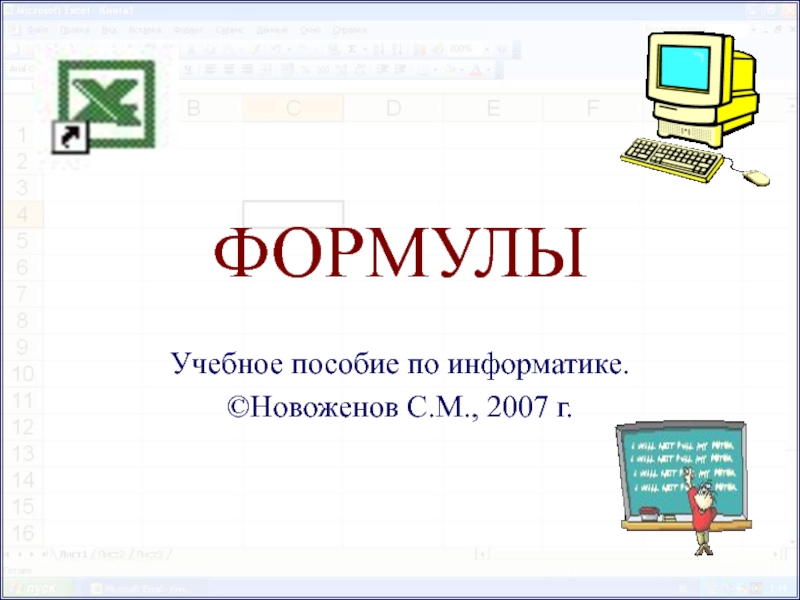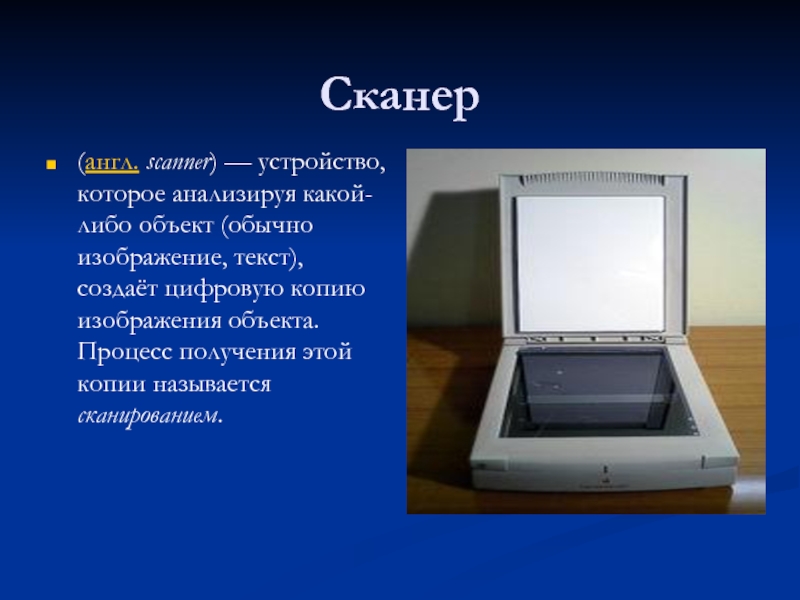Разделы презентаций
- Разное
- Английский язык
- Астрономия
- Алгебра
- Биология
- География
- Геометрия
- Детские презентации
- Информатика
- История
- Литература
- Математика
- Медицина
- Менеджмент
- Музыка
- МХК
- Немецкий язык
- ОБЖ
- Обществознание
- Окружающий мир
- Педагогика
- Русский язык
- Технология
- Физика
- Философия
- Химия
- Шаблоны, картинки для презентаций
- Экология
- Экономика
- Юриспруденция
CLUSTER ANALYSIS
Содержание
- 1. CLUSTER ANALYSIS
- 2. *Data Mining: Concepts and TechniquesChapter 8. Cluster
- 3. What is Cluster Analysis?Cluster: a collection of
- 4. *Data Mining: Concepts and TechniquesGeneral Applications of
- 5. *Data Mining: Concepts and TechniquesExamples of Clustering
- 6. *Data Mining: Concepts and Techniques
- 7. *Data Mining: Concepts and Techniques
- 8. *Data Mining: Concepts and Techniques
- 9. *Data Mining: Concepts and TechniquesWhat Is Good
- 10. *Data Mining: Concepts and TechniquesRequirements of Clustering
- 11. *Data Mining: Concepts and TechniquesChapter 8. Cluster
- 12. *Data Mining: Concepts and TechniquesData StructuresData matrix(two modes)Dissimilarity matrix(one mode)
- 13. *Data Mining: Concepts and TechniquesMeasure the Quality
- 14. *Data Mining: Concepts and Techniques
- 15. *Data Mining: Concepts and Techniques
- 16. *Data Mining: Concepts and Techniques
- 17. *Data Mining: Concepts and TechniquesType of data
- 18. *Data Mining: Concepts and TechniquesInterval-valued variablesStandardize dataCalculate
- 19. *Data Mining: Concepts and TechniquesBinary VariablesA contingency
- 20. *Data Mining: Concepts and TechniquesBinary Variables Association
- 21. *Data Mining: Concepts and TechniquesDissimilarity between Binary
- 22. *Data Mining: Concepts and TechniquesNominal VariablesA generalization
- 23. *Data Mining: Concepts and TechniquesOrdinal VariablesAn ordinal
- 24. *Data Mining: Concepts and TechniquesRatio-Scaled VariablesRatio-scaled variable:
- 25. *Data Mining: Concepts and TechniquesVariables of Mixed
- 26. *Data Mining: Concepts and TechniquesChapter 8. Cluster
- 27. *Data Mining: Concepts and TechniquesMajor Clustering ApproachesPartitioning
- 28. *Data Mining: Concepts and TechniquesChapter 8. Cluster
- 29. *Data Mining: Concepts and TechniquesPartitioning Algorithms: Basic
- 30. *Data Mining: Concepts and Techniques
- 31. *Data Mining: Concepts and TechniquesThe K-Means Clustering
- 32. *Data Mining: Concepts and TechniquesThe K-Means Clustering
- 33. *Data Mining: Concepts and TechniquesComments on the
- 34. *Data Mining: Concepts and TechniquesVariations of the
- 35. *Data Mining: Concepts and TechniquesWhat is the
- 36. *Data Mining: Concepts and Techniques
- 37. *Data Mining: Concepts and Techniques
- 38. *Data Mining: Concepts and Techniques
- 39. *Data Mining: Concepts and TechniquesTypical k-medoids algorithm
- 40. *Data Mining: Concepts and TechniquesWhat is the
- 41. *Data Mining: Concepts and Techniques
- 42. *Data Mining: Concepts and TechniquesCLARA (Clustering Large
- 43. *Data Mining: Concepts and TechniquesCLARANS (“Randomized” CLARA)
- 44. *Data Mining: Concepts and Techniques
- 45. *Data Mining: Concepts and Techniques
- 46. *Data Mining: Concepts and Techniques
- 47. *Data Mining: Concepts and Techniques
- 48. *Data Mining: Concepts and TechniquesChapter 8. Cluster
- 49. *Data Mining: Concepts and Techniques
- 50. *Data Mining: Concepts and Techniques
- 51. *Data Mining: Concepts and TechniquesA Dendrogram Shows
- 52. *Data Mining: Concepts and TechniquesA Dendrogram Algorithm
- 53. *Data Mining: Concepts and TechniquesExample for binary
- 54. *Data Mining: Concepts and Techniquesecoli2ecoli3J23=14/16=0.8752. Incedence matrixecoli1ecoli2ecoli3ecoli1
- 55. *Data Mining: Concepts and TechniquesA Dendrogram Algorithm
- 56. *Data Mining: Concepts and Techniques
- 57. *Data Mining: Concepts and TechniquesA Dendrogram Algorithm
- 58. *Data Mining: Concepts and TechniquesA Dendrogram Algorithm
- 59. *Data Mining: Concepts and TechniquesHierarchical ClusteringUse distance
- 60. *Data Mining: Concepts and Techniques
- 61. *Data Mining: Concepts and TechniquesAGNES (Agglomerative Nesting)Introduced
- 62. *Data Mining: Concepts and TechniquesDIANA (Divisive Analysis)Introduced
- 63. *Data Mining: Concepts and TechniquesMore on Hierarchical
- 64. *Data Mining: Concepts and TechniquesBIRCH (1996)Birch: Balanced
- 65. *Data Mining: Concepts and TechniquesClustering Feature VectorCF = (5, (16,30),(54,190))(3,4)(2,6)(4,5)(4,7)(3,8)
- 66. *Data Mining: Concepts and TechniquesCF-Tree in BIRCHClustering
- 67. *Data Mining: Concepts and TechniquesCF TreeCF1child1CF3child3CF2child2CF5child5CF1CF2CF6prevnextCF1CF2CF4prevnextB = 7L = 6RootNon-leaf nodeLeaf nodeLeaf node
- 68. *Data Mining: Concepts and TechniquesCURE (Clustering Using
- 69. *Data Mining: Concepts and TechniquesDrawbacks of Distance-Based
- 70. *Data Mining: Concepts and TechniquesCure: The AlgorithmDraw
- 71. *Data Mining: Concepts and TechniquesData Partitioning and Clusterings = 50p = 2s/p = 25xxs/pq = 5
- 72. *Data Mining: Concepts and TechniquesCure: Shrinking Representative
- 73. *Data Mining: Concepts and TechniquesClustering Categorical Data:
- 74. *Data Mining: Concepts and TechniquesRock: AlgorithmLinks: The
- 75. *Data Mining: Concepts and TechniquesCHAMELEON (Hierarchical clustering
- 76. *Data Mining: Concepts and TechniquesOverall Framework of CHAMELEONConstructSparse GraphPartition the GraphMerge PartitionFinal ClustersData Set
- 77. *Data Mining: Concepts and TechniquesChapter 8. Cluster
- 78. *Data Mining: Concepts and TechniquesDensity-Based Clustering MethodsClustering
- 79. *Data Mining: Concepts and Techniques
- 80. *Data Mining: Concepts and Techniques
- 81. *Data Mining: Concepts and Techniques
- 82. *Data Mining: Concepts and Techniques
- 83. *Data Mining: Concepts and Techniques
- 84. *Data Mining: Concepts and Techniques
- 85. *Data Mining: Concepts and Techniques
- 86. *Data Mining: Concepts and Techniques
- 87. *Data Mining: Concepts and Techniques
- 88. *Data Mining: Concepts and Techniques
- 89. *Data Mining: Concepts and TechniquesGradient: The steepness of a slopeExample
- 90. *Data Mining: Concepts and TechniquesDensity Attractor
- 91. *Data Mining: Concepts and TechniquesCenter-Defined and Arbitrary
- 92. *Data Mining: Concepts and Techniques
- 93. *Data Mining: Concepts and Techniques
- 94. *Data Mining: Concepts and Techniques
- 95. *Data Mining: Concepts and Techniques
- 96. *Data Mining: Concepts and Techniques
- 97. *Data Mining: Concepts and Techniques
- 98. *Data Mining: Concepts and TechniquesChapter 8. Cluster
- 99. *Data Mining: Concepts and TechniquesGrid-Based Clustering Method
- 100. *Data Mining: Concepts and TechniquesSTING: A Statistical
- 101. STING: A Statistical Information Grid Approach (2)Each
- 102. STING: A Statistical Information Grid Approach (3)Remove
- 103. *Data Mining: Concepts and TechniquesWaveCluster (1998)Sheikholeslami, Chatterjee,
- 104. *Data Mining: Concepts and TechniquesWhat is Wavelet (1)?
- 105. *Data Mining: Concepts and TechniquesWaveCluster (1998)How to
- 106. *Data Mining: Concepts and TechniquesWavelet TransformDecomposes a
- 107. *Data Mining: Concepts and TechniquesWhat Is Wavelet (2)?
- 108. *Data Mining: Concepts and TechniquesQuantization
- 109. *Data Mining: Concepts and TechniquesTransformation
- 110. *Data Mining: Concepts and TechniquesWaveCluster (1998)Why is
- 111. *Data Mining: Concepts and TechniquesCLIQUE (Clustering In
- 112. *Data Mining: Concepts and TechniquesCLIQUE: The Major
- 113. *Data Mining: Concepts and TechniquesSalary (10,000)2030405060age54312670τ = 3
- 114. *Data Mining: Concepts and TechniquesStrength and Weakness
- 115. *Data Mining: Concepts and TechniquesChapter 8. Cluster
- 116. *Data Mining: Concepts and TechniquesModel-Based Clustering MethodsAttempt
- 117. *Data Mining: Concepts and TechniquesCOBWEB Clustering MethodA classification tree
- 118. *Data Mining: Concepts and TechniquesMore on Statistical-Based
- 119. *Data Mining: Concepts and TechniquesOther Model-Based Clustering
- 120. *Data Mining: Concepts and TechniquesModel-Based Clustering Methods
- 121. *Data Mining: Concepts and TechniquesSelf-organizing feature maps
- 122. *Data Mining: Concepts and TechniquesChapter 8. Cluster
- 123. *Data Mining: Concepts and TechniquesWhat Is Outlier
- 124. *Data Mining: Concepts and TechniquesOutlier Discovery: Statistical
- 125. Outlier Discovery: Distance-Based ApproachIntroduced to counter the
- 126. *Data Mining: Concepts and TechniquesOutlier Discovery: Deviation-Based
- 127. *Data Mining: Concepts and TechniquesChapter 8. Cluster
- 128. *Data Mining: Concepts and TechniquesProblems and ChallengesConsiderable
- 129. *Data Mining: Concepts and TechniquesConstraint-Based Clustering AnalysisClustering
- 130. *Data Mining: Concepts and TechniquesClustering With Obstacle ObjectsTaking obstacles into accountNot Taking obstacles into account
- 131. *Data Mining: Concepts and TechniquesSummaryCluster analysis groups
- 132. *Data Mining: Concepts and TechniquesReferences (1)R. Agrawal,
- 133. *Data Mining: Concepts and TechniquesReferences (2)L. Kaufman
- 134. Скачать презентанцию
Слайды и текст этой презентации
Слайд 2*
Data Mining: Concepts and Techniques
Chapter 8. Cluster Analysis
What is Cluster
Analysis?
Types of Data in Cluster Analysis
A Categorization of Major Clustering
MethodsPartitioning Methods
Hierarchical Methods
Density-Based Methods
Grid-Based Methods
Model-Based Clustering Methods
Outlier Analysis
Summary
Слайд 3What is Cluster Analysis?
Cluster: a collection of data objects
Similar to
one another within the same cluster
Dissimilar to the objects in
other clustersCluster analysis
Grouping a set of data objects into clusters
Clustering is unsupervised classification: no predefined classes
Typical applications
As a stand-alone tool to get insight into data distribution
As a preprocessing step for other algorithms
Слайд 4*
Data Mining: Concepts and Techniques
General Applications of Clustering
Pattern Recognition
Spatial
Data Analysis
create thematic maps in GIS by clustering feature
spacesdetect spatial clusters and explain them in spatial data mining
Image Processing
Economic Science (especially market research)
WWW
Document classification
Cluster Weblog data to discover groups of similar access patterns
Слайд 5*
Data Mining: Concepts and Techniques
Examples of Clustering Applications
Marketing: Help marketers
discover distinct groups in their customer bases, and then use
this knowledge to develop targeted marketing programsLand use: Identification of areas of similar land use in an earth observation database
Insurance: Identifying groups of motor insurance policy holders with a high average claim cost
City-planning: Identifying groups of houses according to their house type, value, and geographical location
Earth-quake studies: Observed earth quake epicenters should be clustered along continent faults
Слайд 9*
Data Mining: Concepts and Techniques
What Is Good Clustering?
A good clustering
method will produce high quality clusters with
high intra-class similarity
low inter-class
similarity The quality of a clustering result depends on both the similarity measure used by the method and its implementation.
The quality of a clustering method is also measured by its ability to discover some or all of the hidden patterns.
Слайд 10*
Data Mining: Concepts and Techniques
Requirements of Clustering in Data Mining
Scalability
Ability to deal with different types of attributes
Discovery of clusters
with arbitrary shapeMinimal requirements for domain knowledge to determine input parameters
Able to deal with noise and outliers
Insensitive to order of input records
High dimensionality
Incorporation of user-specified constraints
Interpretability and usability
Слайд 11*
Data Mining: Concepts and Techniques
Chapter 8. Cluster Analysis
What is Cluster
Analysis?
Types of Data in Cluster Analysis
A Categorization of Major Clustering
MethodsPartitioning Methods
Hierarchical Methods
Density-Based Methods
Grid-Based Methods
Model-Based Clustering Methods
Outlier Analysis
Summary
Слайд 12*
Data Mining: Concepts and Techniques
Data Structures
Data matrix
(two modes)
Dissimilarity matrix
(one mode)
Слайд 13*
Data Mining: Concepts and Techniques
Measure the Quality of Clustering
Dissimilarity/Similarity metric:
Similarity is expressed in terms of a distance function, which
is typically metric: d(i, j)There is a separate “quality” function that measures the “goodness” of a cluster.
The definitions of distance functions are usually very different for interval-scaled, boolean, categorical, ordinal and ratio variables.
Weights should be associated with different variables based on applications and data semantics.
It is hard to define “similar enough” or “good enough”
the answer is typically highly subjective.
Слайд 17*
Data Mining: Concepts and Techniques
Type of data in clustering analysis
Interval-scaled
variables:
Binary variables:
Nominal, ordinal, and ratio variables:
Variables of mixed types:
Слайд 18*
Data Mining: Concepts and Techniques
Interval-valued variables
Standardize data
Calculate the mean absolute
deviation:
where
Calculate the standardized measurement (z-score)
Using mean absolute deviation is more
robust than using standard deviation Слайд 19*
Data Mining: Concepts and Techniques
Binary Variables
A contingency table for binary
data
Simple matching coefficient (invariant, if the binary variable is symmetric):
Jaccard
coefficient (noninvariant if the binary variable is asymmetric): Object i
Object j
Слайд 20*
Data Mining: Concepts and Techniques
Binary Variables
Association coefficient Yule:
Q(i,j)= ad-bc/ ad+bc
Rassel and Rao coefficient: J(i,j)=
a/ a+b+c+d Bravais coefficient: C(i,j)= ad-bc/
Hemming distance: H(i,j)= a+d
Слайд 21*
Data Mining: Concepts and Techniques
Dissimilarity between Binary Variables
Example
gender is a
symmetric attribute
the remaining attributes are asymmetric binary
let the values Y
and P be set to 1, and the value N be set to 0Слайд 22*
Data Mining: Concepts and Techniques
Nominal Variables
A generalization of the binary
variable in that it can take more than 2 states,
e.g., red, yellow, blue, greenMethod 1: Simple matching
m: # of matches, p: total # of variables
Method 2: use a large number of binary variables
creating a new binary variable for each of the M nominal states
Слайд 23*
Data Mining: Concepts and Techniques
Ordinal Variables
An ordinal variable can be
discrete or continuous
Order is important, e.g., rank
Can be treated like
interval-scaled replace xif by their rank
map the range of each variable onto [0, 1] by replacing i-th object in the f-th variable by
compute the dissimilarity using methods for interval-scaled variables
Слайд 24*
Data Mining: Concepts and Techniques
Ratio-Scaled Variables
Ratio-scaled variable: a positive measurement
on a nonlinear scale, approximately at exponential scale, such as
AeBt or Ae-BtMethods:
treat them like interval-scaled variables—not a good choice! (why?—the scale can be distorted)
apply logarithmic transformation
yif = log(xif)
treat them as continuous ordinal data treat their rank as interval-scaled
Слайд 25*
Data Mining: Concepts and Techniques
Variables of Mixed Types
A database may
contain all the six types of variables
symmetric binary, asymmetric binary,
nominal, ordinal, interval and ratioOne may use a weighted formula to combine their effects
f is binary or nominal:
dij(f) = 0 if xif = xjf , or dij(f) = 1 o.w.
f is interval-based: use the normalized distance
f is ordinal or ratio-scaled
compute ranks rif and
and treat zif as interval-scaled
Слайд 26*
Data Mining: Concepts and Techniques
Chapter 8. Cluster Analysis
What is Cluster
Analysis?
Types of Data in Cluster Analysis
A Categorization of Major Clustering
MethodsPartitioning Methods
Hierarchical Methods
Density-Based Methods
Grid-Based Methods
Model-Based Clustering Methods
Outlier Analysis
Summary
Слайд 27*
Data Mining: Concepts and Techniques
Major Clustering Approaches
Partitioning algorithms: Construct various
partitions and then evaluate them by some criterion
Hierarchy algorithms: Create
a hierarchical decomposition of the set of data (or objects) using some criterionDensity-based: based on connectivity and density functions
Grid-based: based on a multiple-level granularity structure
Model-based: A model is hypothesized for each of the clusters and the idea is to find the best fit of that model to each other
Слайд 28*
Data Mining: Concepts and Techniques
Chapter 8. Cluster Analysis
What is Cluster
Analysis?
Types of Data in Cluster Analysis
A Categorization of Major Clustering
MethodsPartitioning Methods
Hierarchical Methods
Density-Based Methods
Grid-Based Methods
Model-Based Clustering Methods
Outlier Analysis
Summary
Слайд 29*
Data Mining: Concepts and Techniques
Partitioning Algorithms: Basic Concept
Partitioning method: Construct
a partition of a database D of n objects into
a set of k clustersGiven a k, find a partition of k clusters that optimizes the chosen partitioning criterion
Global optimal: exhaustively enumerate all partitions
Heuristic methods: k-means and k-medoids algorithms
k-means (MacQueen’67): Each cluster is represented by the center of the cluster
k-medoids or PAM (Partition around medoids) (Kaufman & Rousseeuw’87): Each cluster is represented by one of the objects in the cluster
Слайд 31*
Data Mining: Concepts and Techniques
The K-Means Clustering Method
Given k,
the k-means algorithm is implemented in four steps:
Partition objects into
k nonempty subsetsCompute seed points as the centroids of the clusters of the current partition (the centroid is the center, i.e., mean point, of the cluster)
Assign each object to the cluster with the nearest seed point
Go back to Step 2, stop when no more new assignment
Слайд 32*
Data Mining: Concepts and Techniques
The K-Means Clustering Method
Example
0
1
2
3
4
5
6
7
8
9
10
0
1
2
3
4
5
6
7
8
9
10
K=2
Arbitrarily choose
K object as initial cluster center
Assign each objects to most
similar centerUpdate the cluster means
Update the cluster means
reassign
reassign
Слайд 33*
Data Mining: Concepts and Techniques
Comments on the K-Means Method
Strength: Relatively
efficient: O(tkn), where n is # objects, k is #
clusters, and t is # iterations. Normally, k, t << n.Comparing: PAM: O(k(n-k)2 ), CLARA: O(ks2 + k(n-k))
Comment: Often terminates at a local optimum. The global optimum may be found using techniques such as: deterministic annealing and genetic algorithms
Weakness
Applicable only when mean is defined, then what about categorical data?
Need to specify k, the number of clusters, in advance
Unable to handle noisy data and outliers
Not suitable to discover clusters with non-convex shapes
Слайд 34*
Data Mining: Concepts and Techniques
Variations of the K-Means Method
A few
variants of the k-means which differ in
Selection of the initial
k meansDissimilarity calculations
Strategies to calculate cluster means
Handling categorical data: k-modes (Huang’98)
Replacing means of clusters with modes
Using new dissimilarity measures to deal with categorical objects
Using a frequency-based method to update modes of clusters
A mixture of categorical and numerical data: k-prototype method
Слайд 35*
Data Mining: Concepts and Techniques
What is the problem of k-Means
Method?
The k-means algorithm is sensitive to outliers !
Since an object
with an extremely large value may substantially distort the distribution of the data.K-Medoids: Instead of taking the mean value of the object in a cluster as a reference point, medoids can be used, which is the most centrally located object in a cluster.
Слайд 39*
Data Mining: Concepts and Techniques
Typical k-medoids algorithm (PAM)
Total Cost =
20
0
1
2
3
4
5
6
7
8
9
10
0
1
2
3
4
5
6
7
8
9
10
K=2
Arbitrary choose k object as initial medoids
Assign each remaining object
to nearest medoidsRandomly select a nonmedoid object,Oramdom
Compute total cost of swapping
Total Cost = 26
Swapping O and Oramdom
If quality is improved.
Do loop
Until no change
Слайд 40*
Data Mining: Concepts and Techniques
What is the problem with PAM?
Pam
is more robust than k-means in the presence of noise
and outliers because a medoid is less influenced by outliers or other extreme values than a meanPam works efficiently for small data sets but does not scale well for large data sets.
O(k(n-k)2 ) for each iteration
where n is # of data,k is # of clusters
Sampling based method,
CLARA(Clustering LARge Applications)
Слайд 42*
Data Mining: Concepts and Techniques
CLARA (Clustering Large Applications) (1990)
CLARA (Kaufmann
and Rousseeuw in 1990)
Built in statistical analysis packages, such as
S+It draws multiple samples of the data set, applies PAM on each sample, and gives the best clustering as the output
Strength: deals with larger data sets than PAM
Weakness:
Efficiency depends on the sample size
A good clustering based on samples will not necessarily represent a good clustering of the whole data set if the sample is biased
Слайд 43*
Data Mining: Concepts and Techniques
CLARANS (“Randomized” CLARA) (1994)
CLARANS (A Clustering
Algorithm based on Randomized Search) (Ng and Han’94)
CLARANS draws sample
of neighbors dynamicallyThe clustering process can be presented as searching a graph where every node is a potential solution, that is, a set of k medoids
If the local optimum is found, CLARANS starts with new randomly selected node in search for a new local optimum
It is more efficient and scalable than both PAM and CLARA
Focusing techniques and spatial access structures may further improve its performance (Ester et al.’95)
Слайд 48*
Data Mining: Concepts and Techniques
Chapter 8. Cluster Analysis
What is Cluster
Analysis?
Types of Data in Cluster Analysis
A Categorization of Major Clustering
MethodsPartitioning Methods
Hierarchical Methods
Density-Based Methods
Grid-Based Methods
Model-Based Clustering Methods
Outlier Analysis
Summary
Слайд 51*
Data Mining: Concepts and Techniques
A Dendrogram Shows How the Clusters
are Merged Hierarchically
Decompose data objects into a several levels of
nested partitioning (tree of clusters), called a dendrogram. A clustering of the data objects is obtained by cutting the dendrogram at the desired level, then each connected component forms a cluster.
Слайд 52*
Data Mining: Concepts and Techniques
A Dendrogram Algorithm for Binary variables
1.
To estimate similarity of objects on the basis of binary
attributes and measures of similarity of objects such as Simple matching coefficient, Jaccard coefficient, Rassel and Rao coefficient, Bravais coefficient, association coefficient Yule, Hemming distance.2.To make a incedence matrix for all objects, where it’s elements is similarity coefficients.
3. Graphically represent a incedence matrix where on an axis х – number of objects, on an axis Y –the measures of similarity. Find in a matrix two most similar objects (with the minimal distance) and put them on the schedule. Iteratively continue construction of the schedule for all objects of the analysis
Слайд 53*
Data Mining: Concepts and Techniques
Example for binary variables
ecoli1
0 1 1 1 0
0 0 1 0 0 0 0 0 0 1 1ecoli2 0 1 0 1 1 0 0 1 0 0 0 0 0 0 1 0
ecoli3 1 1 0 1 1 0 0 1 0 0 0 0 0 0 1 1
We have 3 objects with 16 attributes . Define the similarity of objects.
1. Define the similarity on the base of Simple matching coefficient
ecoli1
ecoli2
J12=13/16=0.81
J13=12/15=0.8
ecoli1
ecoli3
Слайд 54*
Data Mining: Concepts and Techniques
ecoli2
ecoli3
J23=14/16=0.875
2. Incedence matrix
ecoli1
ecoli2
ecoli3
ecoli1 ecoli2 ecoli3
0
0.81 0.8
0 0.875 2 1 3
0.8
0.81
number
Example for binary variables
Слайд 55*
Data Mining: Concepts and Techniques
A Dendrogram Algorithm for Numerical variables
1.
To estimate similarity of objects on the basis of numerical
attributes and measures of similarity of objects such as distances (slide 14).2.To make a incedence matrix for all objects, where it’s elements is distances.
3. Graphically represent a incedence matrix where on an axis х – number of objects, on an axis Y –the measures of similarity. Find in a matrix two most similar objects (with the minimal distance) and put them on the schedule. Iteratively continue construction of the schedule for all objects of the analysis
Слайд 57*
Data Mining: Concepts and Techniques
A Dendrogram Algorithm for Numerical variables
Let
us consider five points {x1,….,x5} with the attributes
X1=(0,2), x2=(0,0)
x3=(1.5,0) x4=(5,0) x5=(5,2) a) single-link distance
Cluster 2
Cluster 1
b) complete-link distance
Using Euclidian measure
Слайд 58*
Data Mining: Concepts and Techniques
A Dendrogram Algorithm for Numerical variables
D(x1,x2)=2
D(x1,x3)=2.5 D(x1,x4)=5.39 D(x1,x5)=5
D(x2,x3)=1.5 D(x2,x4)=5 D(x2,x5)=5.29
D(x3,x4)=3.5 D(x3,x5)=4.03
D(x4,x5)=2
Dendrogram by single-link method
Dendrogram by
complete-link method2.2
Слайд 59*
Data Mining: Concepts and Techniques
Hierarchical Clustering
Use distance matrix as clustering
criteria. This method does not require the number of clusters
k as an input, but needs a termination conditionСлайд 61*
Data Mining: Concepts and Techniques
AGNES (Agglomerative Nesting)
Introduced in Kaufmann and
Rousseeuw (1990)
Implemented in statistical analysis packages, e.g., Splus
Use the Single-Link
method and the dissimilarity matrix. Merge nodes that have the least dissimilarity
Go on in a non-descending fashion
Eventually all nodes belong to the same cluster
Слайд 62*
Data Mining: Concepts and Techniques
DIANA (Divisive Analysis)
Introduced in Kaufmann and
Rousseeuw (1990)
Implemented in statistical analysis packages, e.g., Splus
Inverse order of
AGNESEventually each node forms a cluster on its own
Слайд 63*
Data Mining: Concepts and Techniques
More on Hierarchical Clustering Methods
Major weakness
of agglomerative clustering methods
do not scale well: time complexity of
at least O(n2), where n is the number of total objectscan never undo what was done previously
Integration of hierarchical with distance-based clustering
BIRCH (1996): uses CF-tree and incrementally adjusts the quality of sub-clusters
CURE (1998): selects well-scattered points from the cluster and then shrinks them towards the center of the cluster by a specified fraction
CHAMELEON (1999): hierarchical clustering using dynamic modeling
Слайд 64*
Data Mining: Concepts and Techniques
BIRCH (1996)
Birch: Balanced Iterative Reducing and
Clustering using Hierarchies, by Zhang, Ramakrishnan, Livny (SIGMOD’96)
Incrementally construct a
CF (Clustering Feature) tree, a hierarchical data structure for multiphase clusteringPhase 1: scan DB to build an initial in-memory CF tree (a multi-level compression of the data that tries to preserve the inherent clustering structure of the data)
Phase 2: use an arbitrary clustering algorithm to cluster the leaf nodes of the CF-tree
Scales linearly: finds a good clustering with a single scan and improves the quality with a few additional scans
Weakness: handles only numeric data, and sensitive to the order of the data record.
Слайд 65*
Data Mining: Concepts and Techniques
Clustering Feature Vector
CF = (5, (16,30),(54,190))
(3,4)
(2,6)
(4,5)
(4,7)
(3,8)
Слайд 66*
Data Mining: Concepts and Techniques
CF-Tree in BIRCH
Clustering feature:
summary of
the statistics for a given subcluster: the 0-th, 1st and
2nd moments of the subcluster from the statistical point of view.registers crucial measurements for computing cluster and utilizes storage efficiently
A CF tree is a height-balanced tree that stores the clustering features for a hierarchical clustering
A nonleaf node in a tree has descendants or “children”
The nonleaf nodes store sums of the CFs of their children
A CF tree has two parameters
Branching factor: specify the maximum number of children.
threshold: max diameter of sub-clusters stored at the leaf nodes
Слайд 67*
Data Mining: Concepts and Techniques
CF Tree
CF1
child1
CF3
child3
CF2
child2
CF5
child5
CF1
CF2
CF6
prev
next
CF1
CF2
CF4
prev
next
B = 7
L = 6
Root
Non-leaf
node
Leaf node
Leaf node
Слайд 68*
Data Mining: Concepts and Techniques
CURE (Clustering Using REpresentatives )
CURE: proposed
by Guha, Rastogi & Shim, 1998
Stops the creation of a
cluster hierarchy if a level consists of k clustersUses multiple representative points to evaluate the distance between clusters, adjusts well to arbitrary shaped clusters and avoids single-link effect
Слайд 69*
Data Mining: Concepts and Techniques
Drawbacks of Distance-Based Method
Drawbacks of square-error
based clustering method
Consider only one point as representative of
a clusterGood only for convex shaped, similar size and density, and if k can be reasonably estimated
Слайд 70*
Data Mining: Concepts and Techniques
Cure: The Algorithm
Draw random sample s.
Partition
sample to p partitions with size s/p
Partially cluster partitions into
s/pq clustersEliminate outliers
By random sampling
If a cluster grows too slow, eliminate it.
Cluster partial clusters.
Слайд 71*
Data Mining: Concepts and Techniques
Data Partitioning and Clustering
s = 50
p
= 2
s/p = 25
x
x
s/pq = 5
Слайд 72*
Data Mining: Concepts and Techniques
Cure: Shrinking Representative Points
Shrink the multiple
representative points towards the gravity center by a fraction of
α.Multiple representatives capture the shape of the cluster
Слайд 73*
Data Mining: Concepts and Techniques
Clustering Categorical Data: ROCK
ROCK: Robust Clustering
using linKs,
by S. Guha, R. Rastogi, K. Shim (ICDE’99).
Use
links to measure similarity/proximityNot distance based
Computational complexity:
Basic ideas:
Similarity function and neighbors:
Let T1 = {1,2,3}, T2={3,4,5}
Слайд 74*
Data Mining: Concepts and Techniques
Rock: Algorithm
Links: The number of common
neighbors for the two points.
Algorithm
Draw random sample
Cluster with links
{1,2,3}, {1,2,4},
{1,2,5}, {1,3,4}, {1,3,5}{1,4,5}, {2,3,4}, {2,3,5}, {2,4,5}, {3,4,5}
{1,2,3} {1,2,4}
3
Слайд 75*
Data Mining: Concepts and Techniques
CHAMELEON (Hierarchical clustering using dynamic modeling)
CHAMELEON:
by G. Karypis, E.H. Han, and V. Kumar’99
Measures the
similarity based on a dynamic modelTwo clusters are merged only if the interconnectivity and closeness (proximity) between two clusters are high relative to the internal interconnectivity of the clusters and closeness of items within the clusters
Cure ignores information about interconnectivity of the objects, Rock ignores information about the closeness of two clusters
A two-phase algorithm
Use a graph partitioning algorithm: cluster objects into a large number of relatively small sub-clusters
Use an agglomerative hierarchical clustering algorithm: find the genuine clusters by repeatedly combining these sub-clusters
Слайд 76*
Data Mining: Concepts and Techniques
Overall Framework of CHAMELEON
Construct
Sparse Graph
Partition the
Graph
Merge Partition
Final Clusters
Data Set
Слайд 77*
Data Mining: Concepts and Techniques
Chapter 8. Cluster Analysis
What is Cluster
Analysis?
Types of Data in Cluster Analysis
A Categorization of Major Clustering
MethodsPartitioning Methods
Hierarchical Methods
Density-Based Methods
Grid-Based Methods
Model-Based Clustering Methods
Outlier Analysis
Summary
Слайд 78*
Data Mining: Concepts and Techniques
Density-Based Clustering Methods
Clustering based on density
(local cluster criterion), such as density-connected points
Major features:
Discover clusters of
arbitrary shapeHandle noise
One scan
Need density parameters as termination condition
Several interesting studies:
DBSCAN: Ester, et al. (KDD’96)
OPTICS: Ankerst, et al (SIGMOD’99).
DENCLUE: Hinneburg & D. Keim (KDD’98)
CLIQUE: Agrawal, et al. (SIGMOD’98)
Слайд 98*
Data Mining: Concepts and Techniques
Chapter 8. Cluster Analysis
What is Cluster
Analysis?
Types of Data in Cluster Analysis
A Categorization of Major Clustering
MethodsPartitioning Methods
Hierarchical Methods
Density-Based Methods
Grid-Based Methods
Model-Based Clustering Methods
Outlier Analysis
Summary
Слайд 99*
Data Mining: Concepts and Techniques
Grid-Based Clustering Method
Using multi-resolution grid
data structure
Several interesting methods
STING (a STatistical INformation Grid approach) by
Wang, Yang and Muntz (1997)WaveCluster by Sheikholeslami, Chatterjee, and Zhang (VLDB’98)
A multi-resolution clustering approach using wavelet method
CLIQUE: Agrawal, et al. (SIGMOD’98)
Слайд 100*
Data Mining: Concepts and Techniques
STING: A Statistical Information Grid Approach
Wang,
Yang and Muntz (VLDB’97)
The spatial area area is divided into
rectangular cellsThere are several levels of cells corresponding to different levels of resolution
Слайд 101STING: A Statistical Information Grid Approach (2)
Each cell at a
high level is partitioned into a number of smaller cells
in the next lower levelStatistical info of each cell is calculated and stored beforehand and is used to answer queries
Parameters of higher level cells can be easily calculated from parameters of lower level cell
count, mean, s, min, max
type of distribution—normal, uniform, etc.
Use a top-down approach to answer spatial data queries
Start from a pre-selected layer—typically with a small number of cells
For each cell in the current level compute the confidence interval
Слайд 102STING: A Statistical Information Grid Approach (3)
Remove the irrelevant cells
from further consideration
When finish examining the current layer, proceed to
the next lower level Repeat this process until the bottom layer is reached
Advantages:
Query-independent, easy to parallelize, incremental update
O(K), where K is the number of grid cells at the lowest level
Disadvantages:
All the cluster boundaries are either horizontal or vertical, and no diagonal boundary is detected
Слайд 103*
Data Mining: Concepts and Techniques
WaveCluster (1998)
Sheikholeslami, Chatterjee, and Zhang (VLDB’98)
A multi-resolution clustering approach which applies wavelet transform to the
feature spaceA wavelet transform is a signal processing technique that decomposes a signal into different frequency sub-band.
Both grid-based and density-based
Input parameters:
# of grid cells for each dimension
the wavelet, and the # of applications of wavelet transform.
Слайд 105*
Data Mining: Concepts and Techniques
WaveCluster (1998)
How to apply wavelet transform
to find clusters
Summaries the data by imposing a multidimensional
grid structure onto data spaceThese multidimensional spatial data objects are represented in a n-dimensional feature space
Apply wavelet transform on feature space to find the dense regions in the feature space
Apply wavelet transform multiple times which result in clusters at different scales from fine to coarse
Слайд 106*
Data Mining: Concepts and Techniques
Wavelet Transform
Decomposes a signal into different
frequency subbands. (can be applied to n-dimensional signals)
Data are transformed
to preserve relative distance between objects at different levels of resolution.Allows natural clusters to become more distinguishable
Слайд 110*
Data Mining: Concepts and Techniques
WaveCluster (1998)
Why is wavelet transformation useful
for clustering
Unsupervised clustering
It uses hat-shape filters to emphasize
region where points cluster, but simultaneously to suppress weaker information in their boundary Effective removal of outliers
Multi-resolution
Cost efficiency
Major features:
Complexity O(N)
Detect arbitrary shaped clusters at different scales
Not sensitive to noise, not sensitive to input order
Only applicable to low dimensional data
Слайд 111*
Data Mining: Concepts and Techniques
CLIQUE (Clustering In QUEst)
Agrawal, Gehrke,
Gunopulos, Raghavan (SIGMOD’98).
Automatically identifying subspaces of a high dimensional
data space that allow better clustering than original space CLIQUE can be considered as both density-based and grid-based
It partitions each dimension into the same number of equal length interval
It partitions an m-dimensional data space into non-overlapping rectangular units
A unit is dense if the fraction of total data points contained in the unit exceeds the input model parameter
A cluster is a maximal set of connected dense units within a subspace
Слайд 112*
Data Mining: Concepts and Techniques
CLIQUE: The Major Steps
Partition the data
space and find the number of points that lie inside
each cell of the partition.Identify the subspaces that contain clusters using the Apriori principle
Identify clusters:
Determine dense units in all subspaces of interests
Determine connected dense units in all subspaces of interests.
Generate minimal description for the clusters
Determine maximal regions that cover a cluster of connected dense units for each cluster
Determination of minimal cover for each cluster
Слайд 114*
Data Mining: Concepts and Techniques
Strength and Weakness of CLIQUE
Strength
It
automatically finds subspaces of the highest dimensionality such that high
density clusters exist in those subspacesIt is insensitive to the order of records in input and does not presume some canonical data distribution
It scales linearly with the size of input and has good scalability as the number of dimensions in the data increases
Weakness
The accuracy of the clustering result may be degraded at the expense of simplicity of the method
Слайд 115*
Data Mining: Concepts and Techniques
Chapter 8. Cluster Analysis
What is Cluster
Analysis?
Types of Data in Cluster Analysis
A Categorization of Major Clustering
MethodsPartitioning Methods
Hierarchical Methods
Density-Based Methods
Grid-Based Methods
Model-Based Clustering Methods
Outlier Analysis
Summary
Слайд 116*
Data Mining: Concepts and Techniques
Model-Based Clustering Methods
Attempt to optimize the
fit between the data and some mathematical model
Statistical and AI
approachConceptual clustering
A form of clustering in machine learning
Produces a classification scheme for a set of unlabeled objects
Finds characteristic description for each concept (class)
COBWEB (Fisher’87)
A popular a simple method of incremental conceptual learning
Creates a hierarchical clustering in the form of a classification tree
Each node refers to a concept and contains a probabilistic description of that concept
Слайд 118*
Data Mining: Concepts and Techniques
More on Statistical-Based Clustering
Limitations of COBWEB
The
assumption that the attributes are independent of each other is
often too strong because correlation may existNot suitable for clustering large database data – skewed tree and expensive probability distributions
CLASSIT
an extension of COBWEB for incremental clustering of continuous data
suffers similar problems as COBWEB
AutoClass (Cheeseman and Stutz, 1996)
Uses Bayesian statistical analysis to estimate the number of clusters
Popular in industry
Слайд 119*
Data Mining: Concepts and Techniques
Other Model-Based Clustering Methods
Neural network approaches
Represent
each cluster as an exemplar, acting as a “prototype” of
the clusterNew objects are distributed to the cluster whose exemplar is the most similar according to some dostance measure
Competitive learning
Involves a hierarchical architecture of several units (neurons)
Neurons compete in a “winner-takes-all” fashion for the object currently being presented
Слайд 121*
Data Mining: Concepts and Techniques
Self-organizing feature maps (SOMs)
Clustering is also
performed by having several units competing for the current object
The
unit whose weight vector is closest to the current object winsThe winner and its neighbors learn by having their weights adjusted
SOMs are believed to resemble processing that can occur in the brain
Useful for visualizing high-dimensional data in 2- or 3-D space
Слайд 122*
Data Mining: Concepts and Techniques
Chapter 8. Cluster Analysis
What is Cluster
Analysis?
Types of Data in Cluster Analysis
A Categorization of Major Clustering
MethodsPartitioning Methods
Hierarchical Methods
Density-Based Methods
Grid-Based Methods
Model-Based Clustering Methods
Outlier Analysis
Summary
Слайд 123*
Data Mining: Concepts and Techniques
What Is Outlier Discovery?
What are outliers?
The
set of objects are considerably dissimilar from the remainder of
the dataExample: Sports: Michael Jordon, Wayne Gretzky, ...
Problem
Find top n outlier points
Applications:
Credit card fraud detection
Telecom fraud detection
Customer segmentation
Medical analysis
Слайд 124*
Data Mining: Concepts and Techniques
Outlier Discovery: Statistical Approaches
Assume a model
underlying distribution that generates data set (e.g. normal distribution)
Use
discordancy tests depending on data distribution
distribution parameter (e.g., mean, variance)
number of expected outliers
Drawbacks
most tests are for single attribute
In many cases, data distribution may not be known
Слайд 125Outlier Discovery: Distance-Based Approach
Introduced to counter the main limitations imposed
by statistical methods
We need multi-dimensional analysis without knowing data distribution.
Distance-based
outlier: A DB(p, D)-outlier is an object O in a dataset T such that at least a fraction p of the objects in T lies at a distance greater than D from OAlgorithms for mining distance-based outliers
Index-based algorithm
Nested-loop algorithm
Cell-based algorithm
Слайд 126*
Data Mining: Concepts and Techniques
Outlier Discovery: Deviation-Based Approach
Identifies outliers by
examining the main characteristics of objects in a group
Objects that
“deviate” from this description are considered outlierssequential exception technique
simulates the way in which humans can distinguish unusual objects from among a series of supposedly like objects
OLAP data cube technique
uses data cubes to identify regions of anomalies in large multidimensional data
Слайд 127*
Data Mining: Concepts and Techniques
Chapter 8. Cluster Analysis
What is Cluster
Analysis?
Types of Data in Cluster Analysis
A Categorization of Major Clustering
MethodsPartitioning Methods
Hierarchical Methods
Density-Based Methods
Grid-Based Methods
Model-Based Clustering Methods
Outlier Analysis
Summary
Слайд 128*
Data Mining: Concepts and Techniques
Problems and Challenges
Considerable progress has been
made in scalable clustering methods
Partitioning: k-means, k-medoids, CLARANS
Hierarchical: BIRCH, CURE
Density-based:
DBSCAN, CLIQUE, OPTICSGrid-based: STING, WaveCluster
Model-based: Autoclass, Denclue, Cobweb
Current clustering techniques do not address all the requirements adequately
Constraint-based clustering analysis: Constraints exist in data space (bridges and highways) or in user queries
Слайд 129*
Data Mining: Concepts and Techniques
Constraint-Based Clustering Analysis
Clustering analysis: less parameters
but more user-desired constraints, e.g., an ATM allocation problem
Слайд 130*
Data Mining: Concepts and Techniques
Clustering With Obstacle Objects
Taking obstacles into
account
Not Taking obstacles into account
Слайд 131*
Data Mining: Concepts and Techniques
Summary
Cluster analysis groups objects based on
their similarity and has wide applications
Measure of similarity can be
computed for various types of dataClustering algorithms can be categorized into partitioning methods, hierarchical methods, density-based methods, grid-based methods, and model-based methods
Outlier detection and analysis are very useful for fraud detection, etc. and can be performed by statistical, distance-based or deviation-based approaches
There are still lots of research issues on cluster analysis, such as constraint-based clustering
Слайд 132*
Data Mining: Concepts and Techniques
References (1)
R. Agrawal, J. Gehrke, D.
Gunopulos, and P. Raghavan. Automatic subspace clustering of high dimensional
data for data mining applications. SIGMOD'98M. R. Anderberg. Cluster Analysis for Applications. Academic Press, 1973.
M. Ankerst, M. Breunig, H.-P. Kriegel, and J. Sander. Optics: Ordering points to identify the clustering structure, SIGMOD’99.
P. Arabie, L. J. Hubert, and G. De Soete. Clustering and Classification. World Scietific, 1996
M. Ester, H.-P. Kriegel, J. Sander, and X. Xu. A density-based algorithm for discovering clusters in large spatial databases. KDD'96.
M. Ester, H.-P. Kriegel, and X. Xu. Knowledge discovery in large spatial databases: Focusing techniques for efficient class identification. SSD'95.
D. Fisher. Knowledge acquisition via incremental conceptual clustering. Machine Learning, 2:139-172, 1987.
D. Gibson, J. Kleinberg, and P. Raghavan. Clustering categorical data: An approach based on dynamic systems. In Proc. VLDB’98.
S. Guha, R. Rastogi, and K. Shim. Cure: An efficient clustering algorithm for large databases. SIGMOD'98.
A. K. Jain and R. C. Dubes. Algorithms for Clustering Data. Printice Hall, 1988.
Слайд 133*
Data Mining: Concepts and Techniques
References (2)
L. Kaufman and P. J.
Rousseeuw. Finding Groups in Data: an Introduction to Cluster Analysis.
John Wiley & Sons, 1990.E. Knorr and R. Ng. Algorithms for mining distance-based outliers in large datasets. VLDB’98.
G. J. McLachlan and K.E. Bkasford. Mixture Models: Inference and Applications to Clustering. John Wiley and Sons, 1988.
P. Michaud. Clustering techniques. Future Generation Computer systems, 13, 1997.
R. Ng and J. Han. Efficient and effective clustering method for spatial data mining. VLDB'94.
E. Schikuta. Grid clustering: An efficient hierarchical clustering method for very large data sets. Proc. 1996 Int. Conf. on Pattern Recognition, 101-105.
G. Sheikholeslami, S. Chatterjee, and A. Zhang. WaveCluster: A multi-resolution clustering approach for very large spatial databases. VLDB’98.
W. Wang, Yang, R. Muntz, STING: A Statistical Information grid Approach to Spatial Data Mining, VLDB’97.
T. Zhang, R. Ramakrishnan, and M. Livny. BIRCH : an efficient data clustering method for very large databases. SIGMOD'96.
